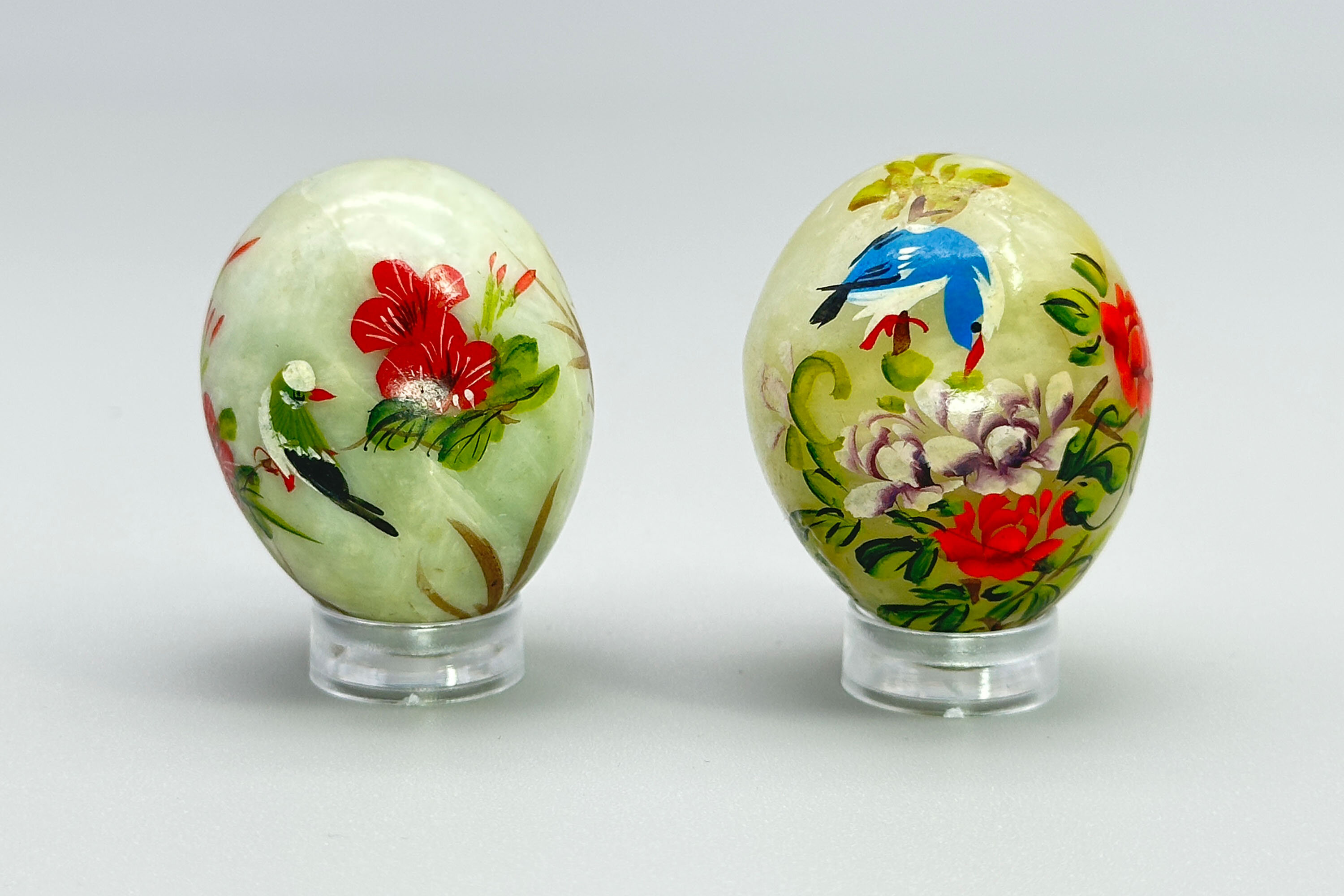Chinese & Japanese Works of Art
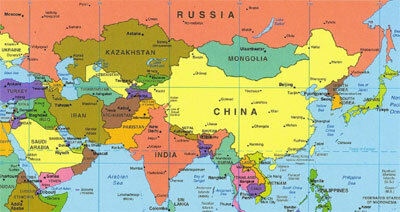
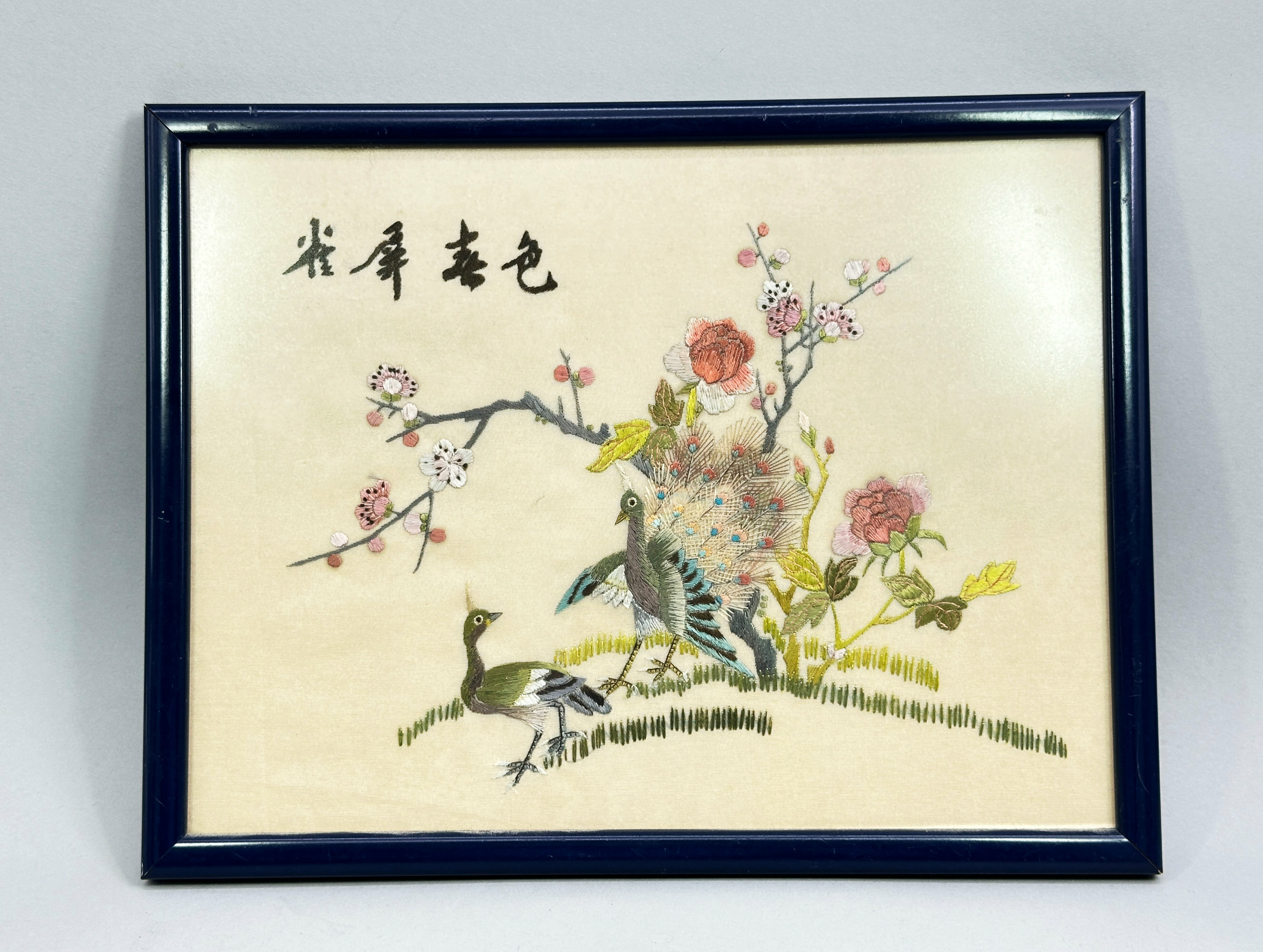
Framed Chinese Embroidery Silk Textile, signed, second half C20th
Price: £25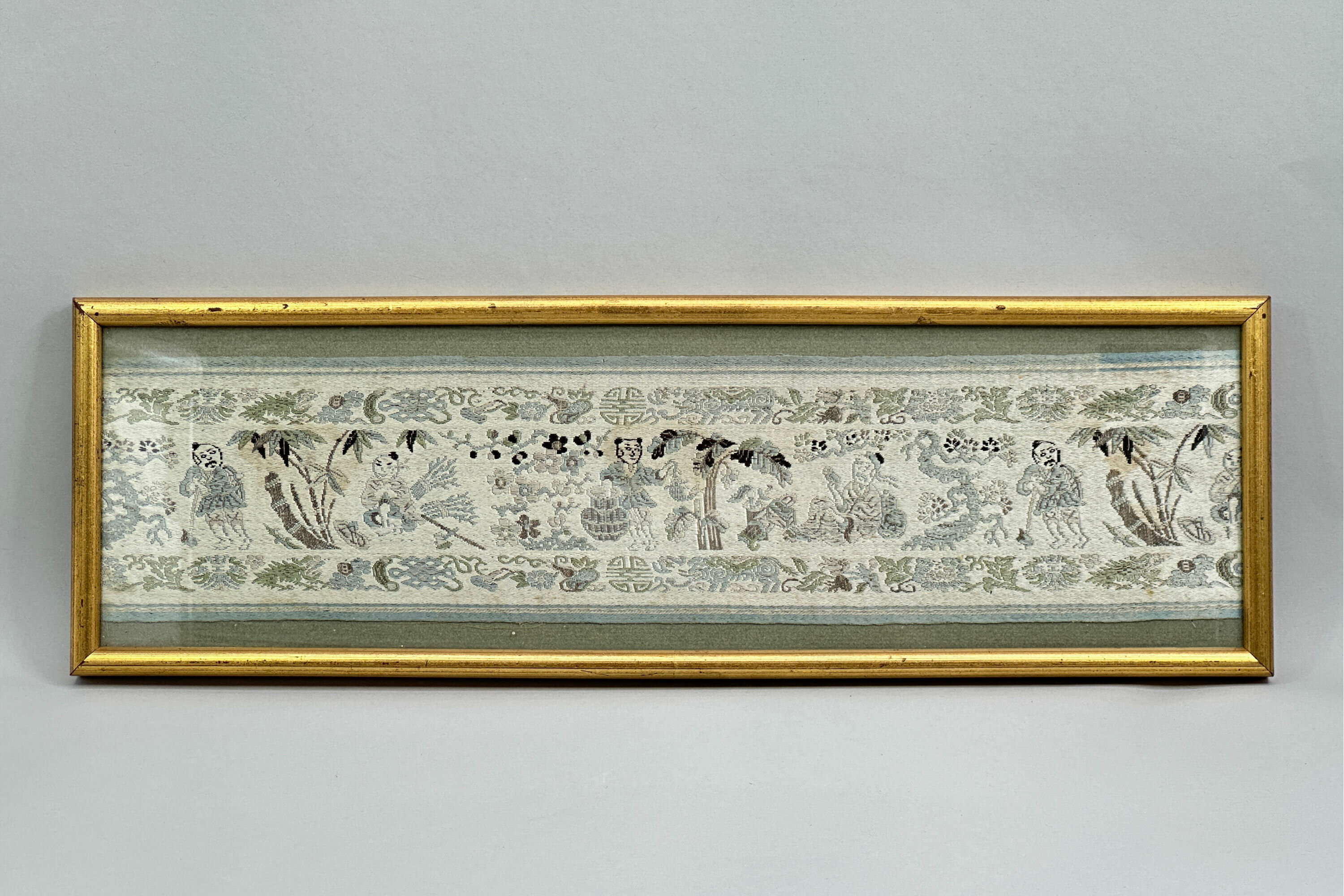
Framed Chinese Silk Embroidered Runner Panel, garden scenes, C20th
Price: £15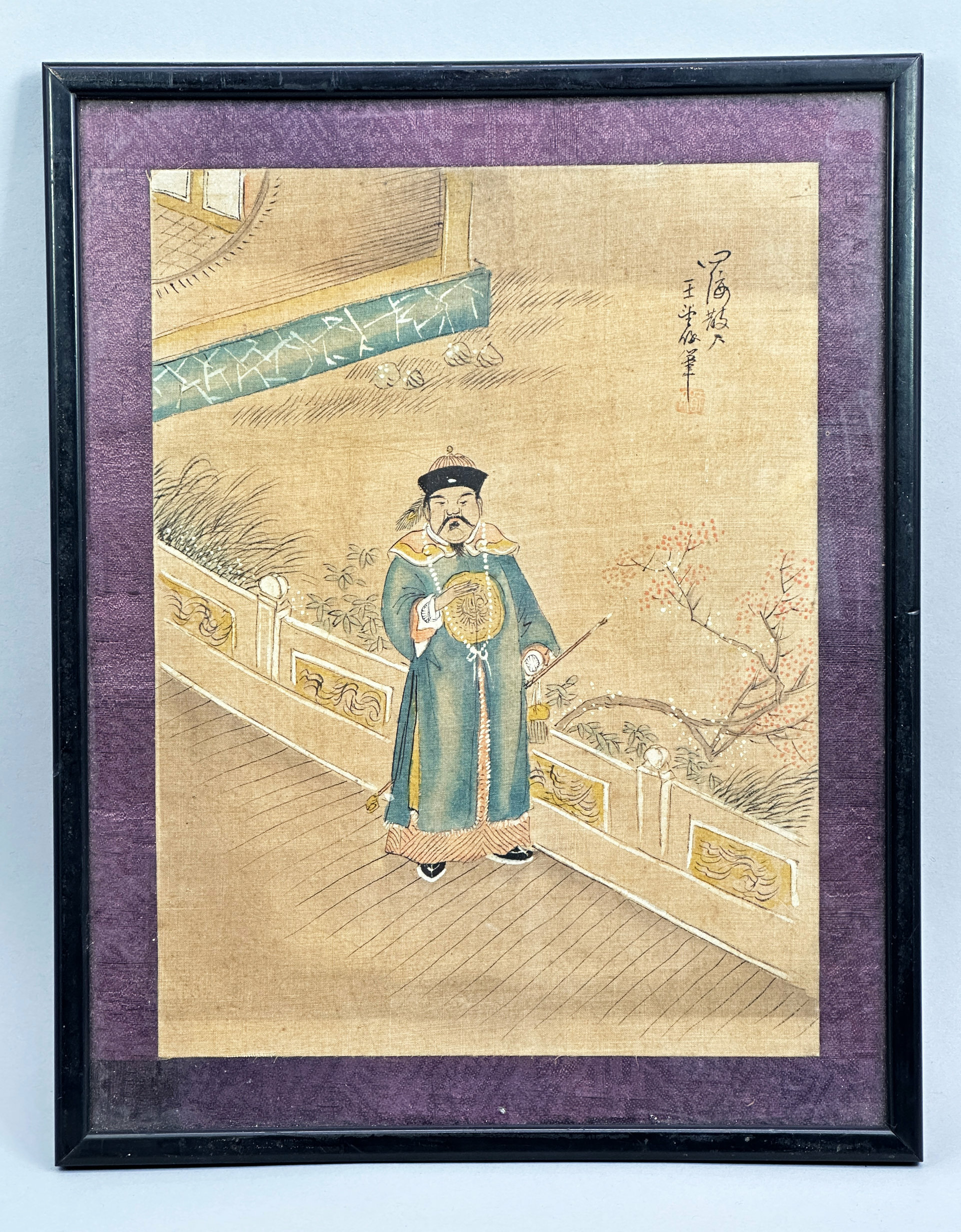
Framed Chinese Painting of a Court Official, C20th
Price: £45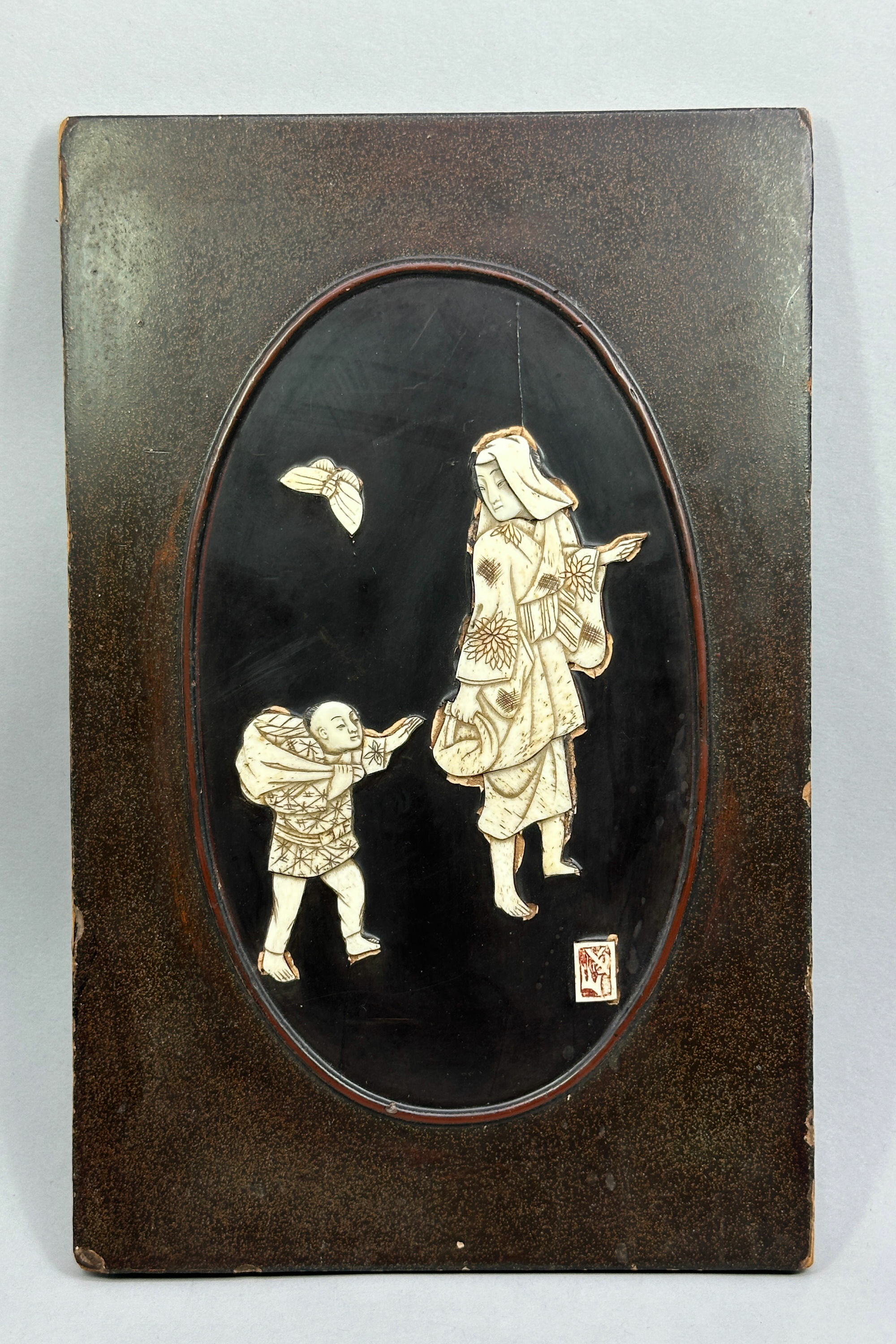
Japanese Bone and Lacquer Plaque, Lady and Boy, signed, late C19th
Price: £45These bone and lacquer plaques were produced in great quantities by Japanese artists in the late nineteenth century for export to the West and became a familiar feature of the European drawing room. The medium was easily subject to damage and loss, especially in respect of the bone inlay, and while this example has some slight damage this is confined to a crack in the lacquer ground of the panel itself and some chipping to the extremities of the panel. The decoration of the figures remains intact (the surround seems to have been cut away in some places to give added definition to the composition) and allows appreciation of the skill with which they were carved, presenting a genre scene of great charm.
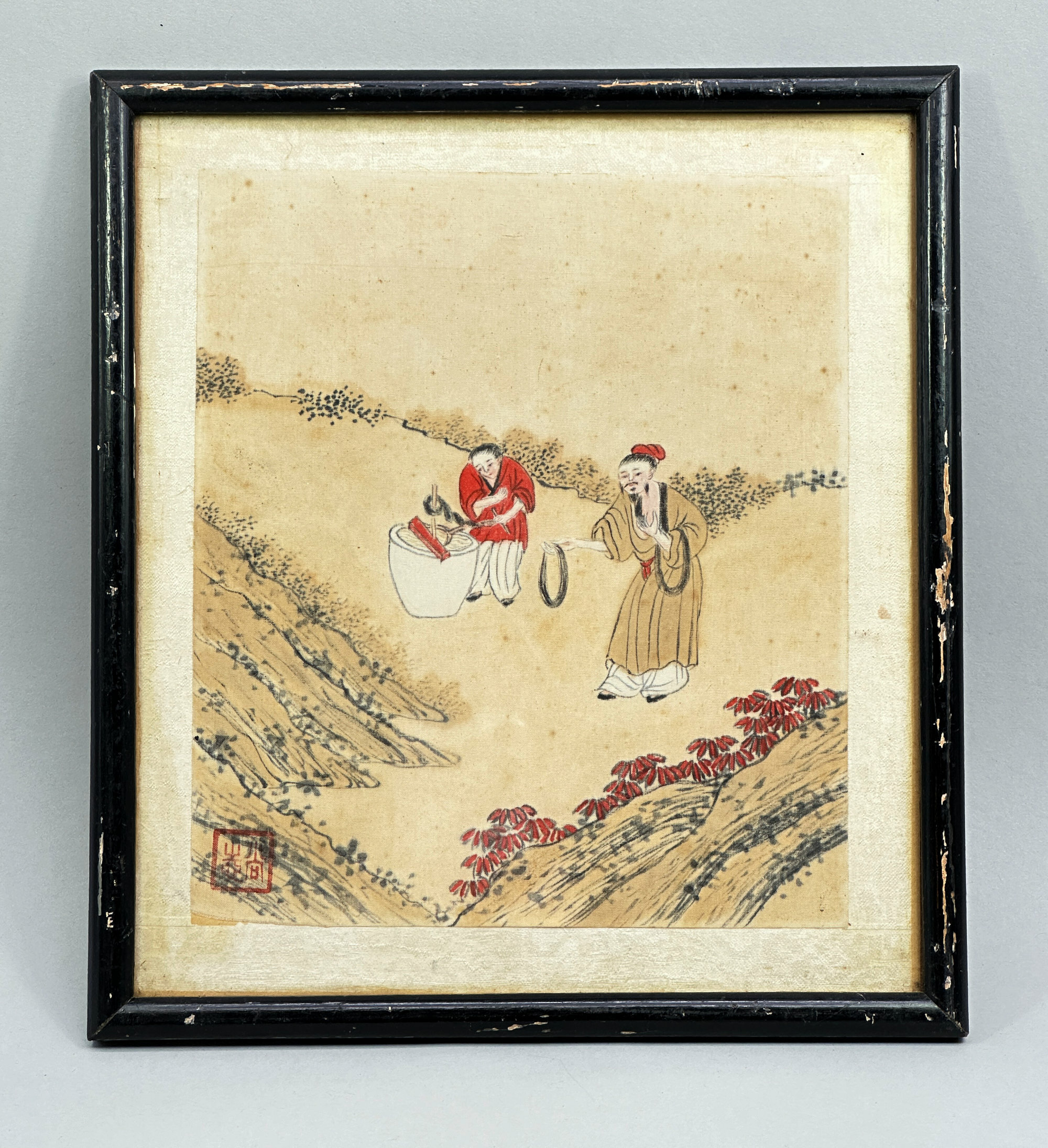
Framed Chinese painting on silk, two Silk Dyers, C19th/C20th
Price: £15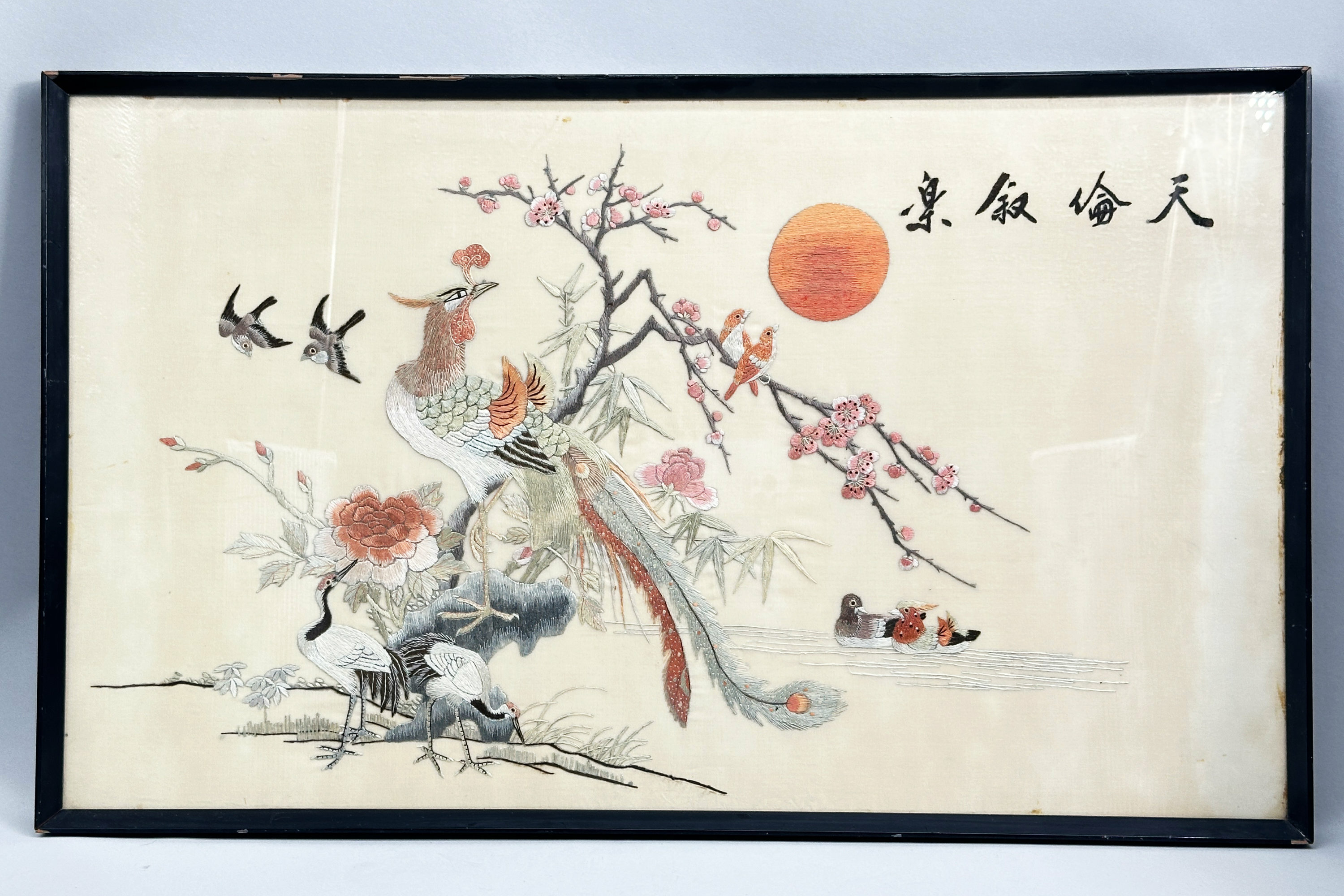
Framed Chinese Embroidery Silk Textile, signed, second half C20th
Price: £45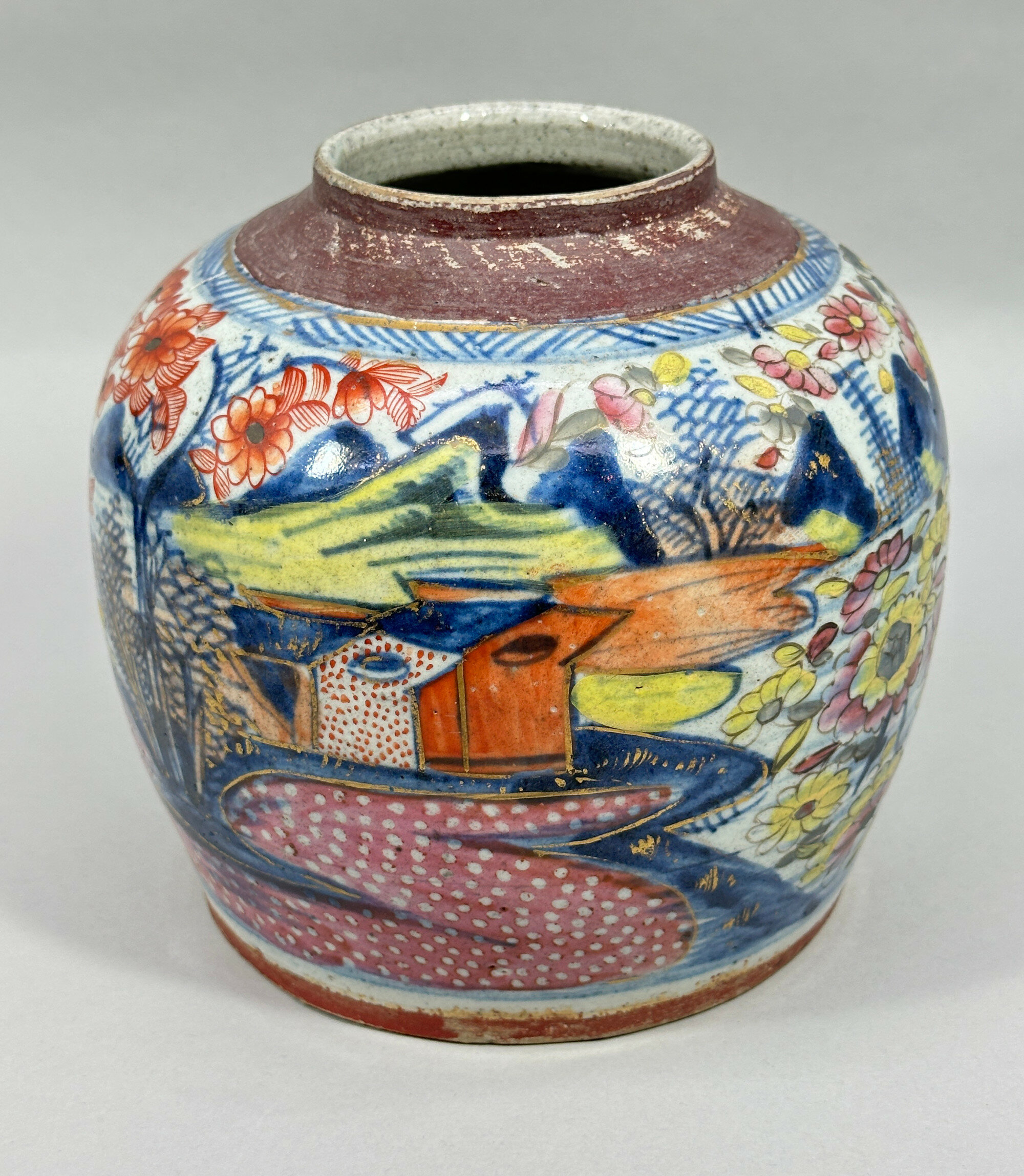
Chinese Ginger Jar Clobbered Decoration circa 1800
Price: £55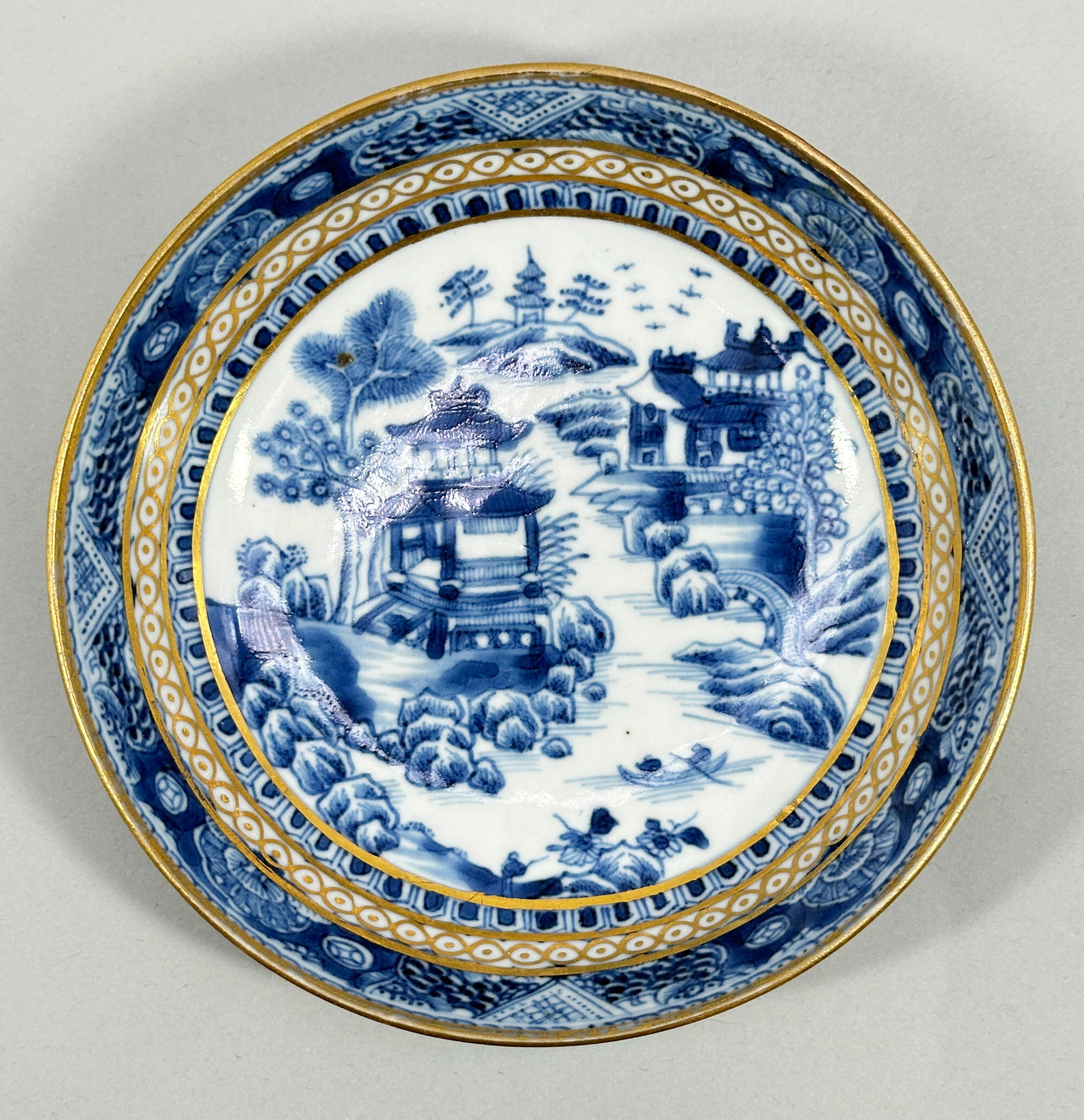
Chinese Export Nanking Pattern Saucer, Qianlong period (1736-1795)
Price: £75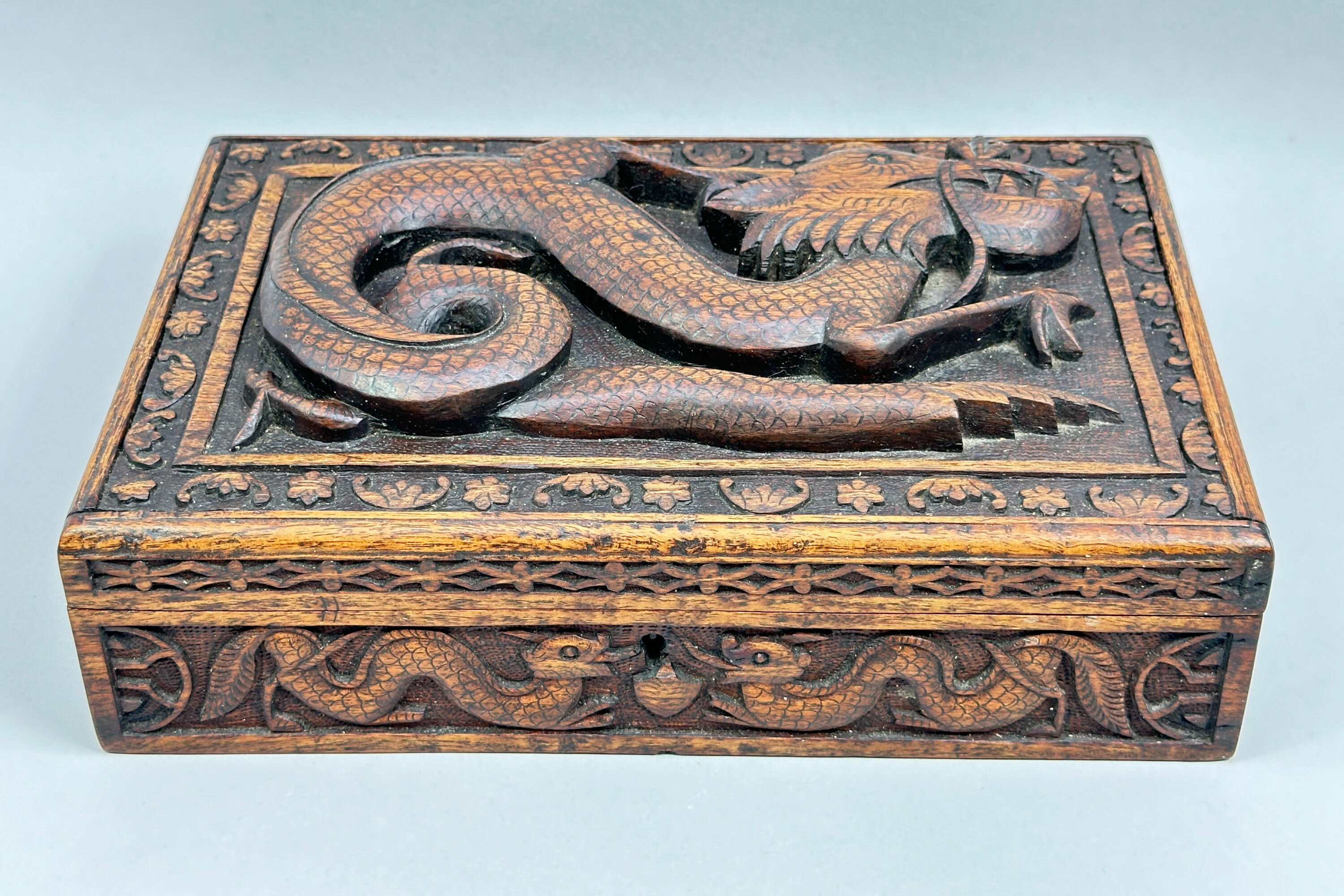
Chinese carved wood Box decorated Dragons, early C20th
Price: £150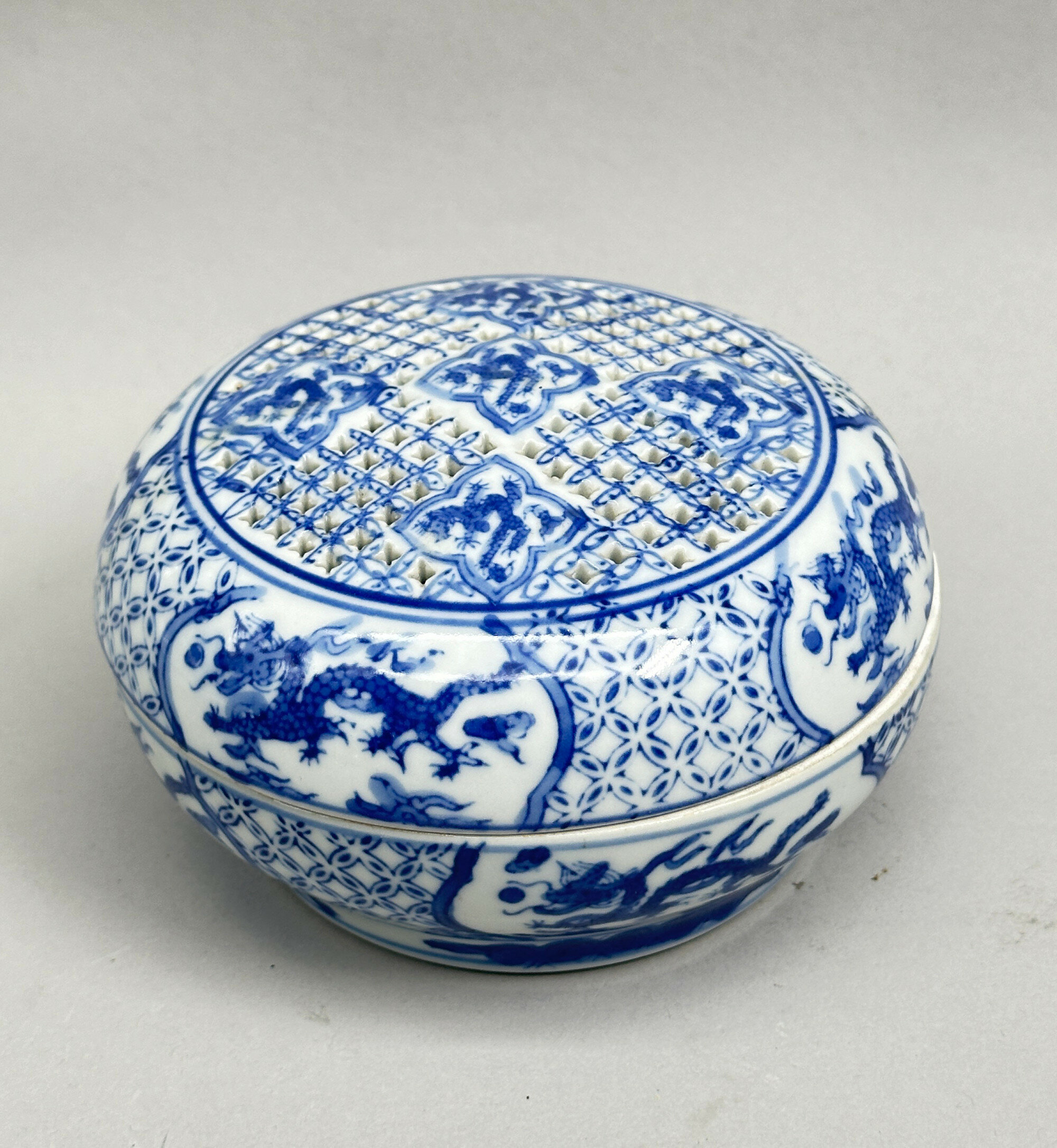
Chinese Blue and White Box and Cover with pierced lid, late C20th
Price: £25The Charles Sadek Import Company was founded in 1936 by the father and son Charles and Norman Sadek and began by importing decorative items from Japan later broadening their range to a wider variety of suppliers including China. These pieces were sold under the ‘Andrea by Sadek’ brand, named after Norman's daughter Andrea. The business continued to a third generation until it was taken over by Fitz & Floyd in 2015.
This box, then, is a typical example of their range of wares, good quality decorative items marketed at an affordable price. The quality of these boxes can vary and this piece seems to be an above average example.
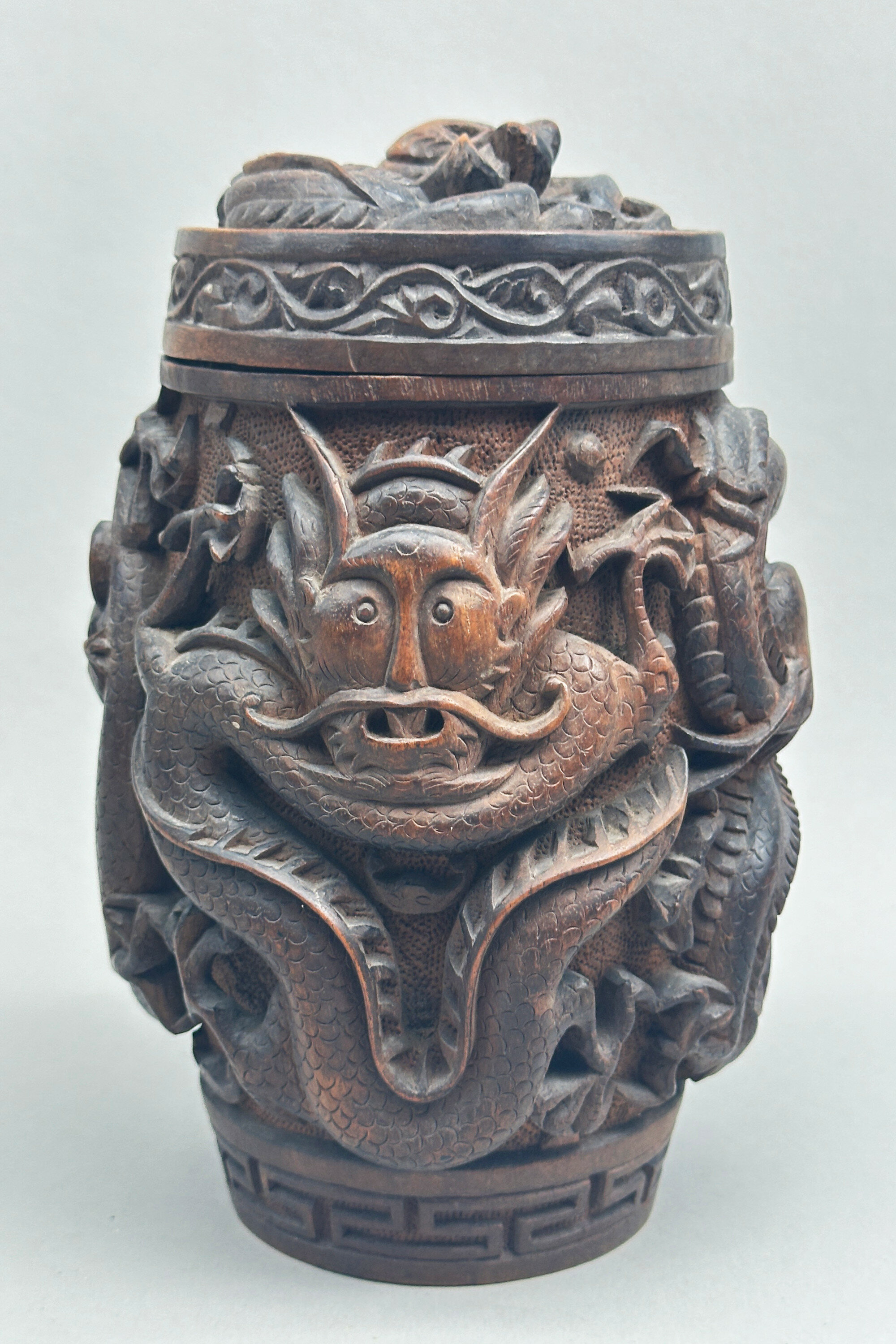
Chinese ovoid carved wood Tobacco Jar decorated dragons, early C20th
Price: £75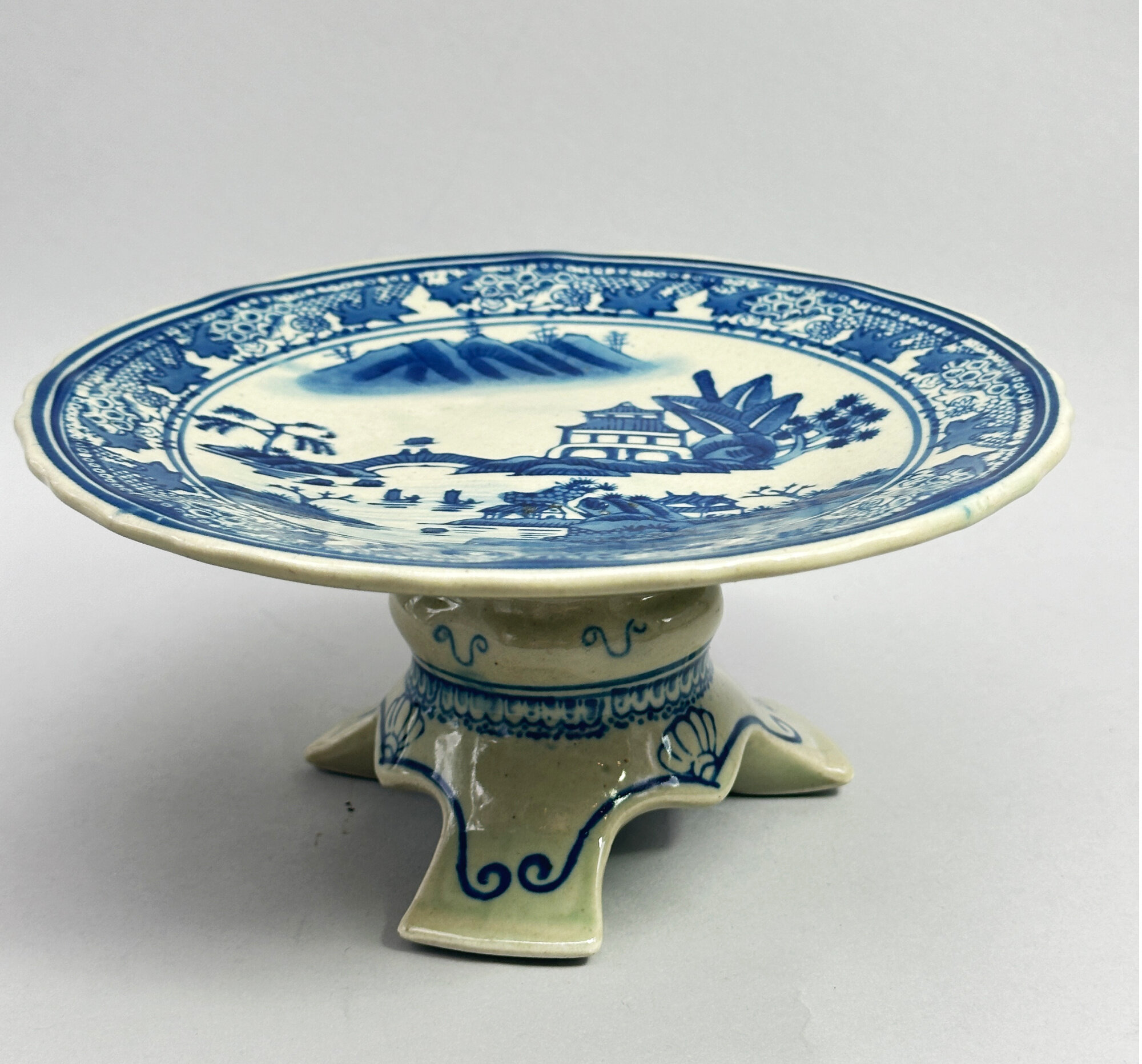
Japanese Celadon Ground Tazza with Chinese Nanking decoration, late C19th
Price: £25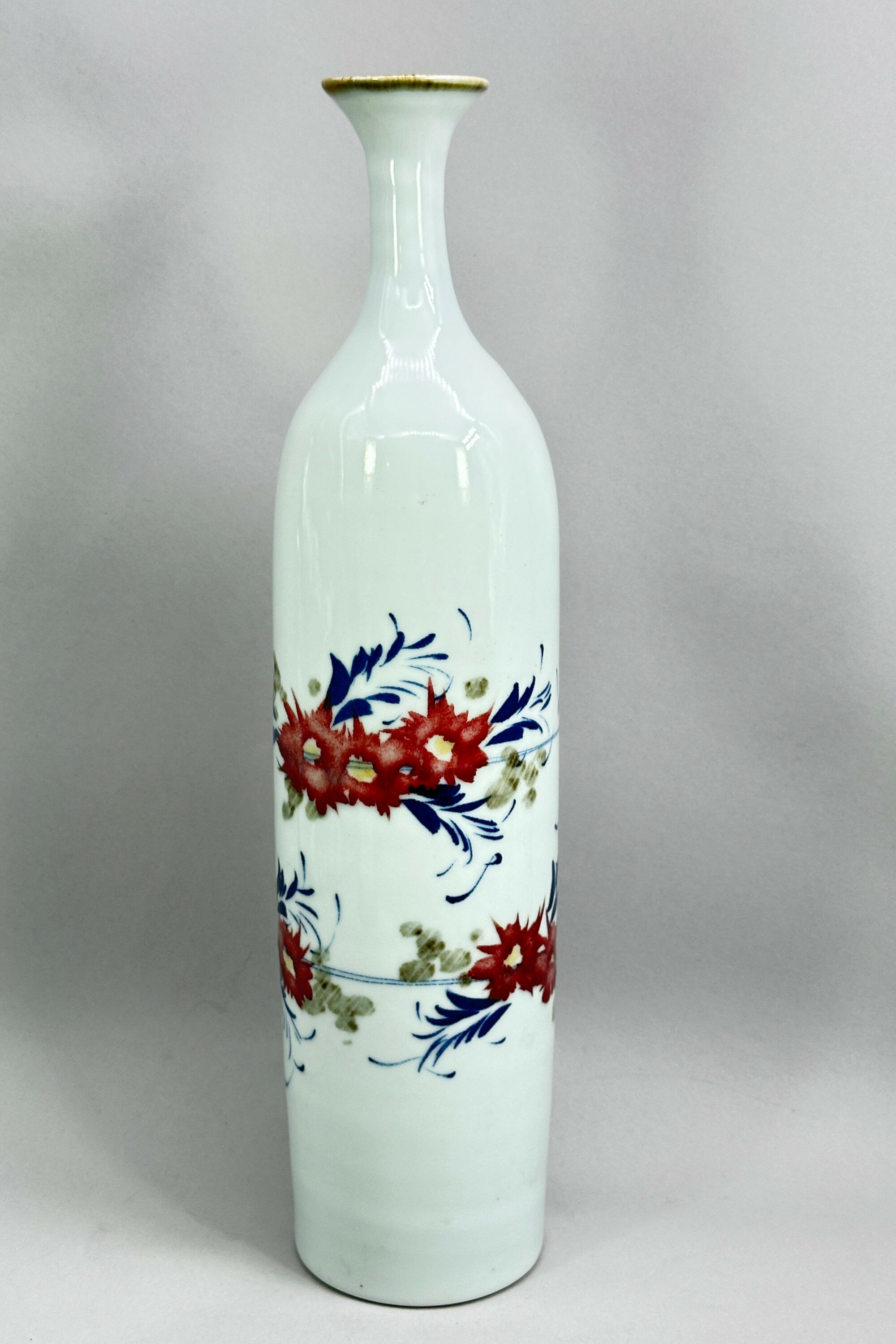
Japanese Studio Pottery Vase, signed, C20th
Price: £75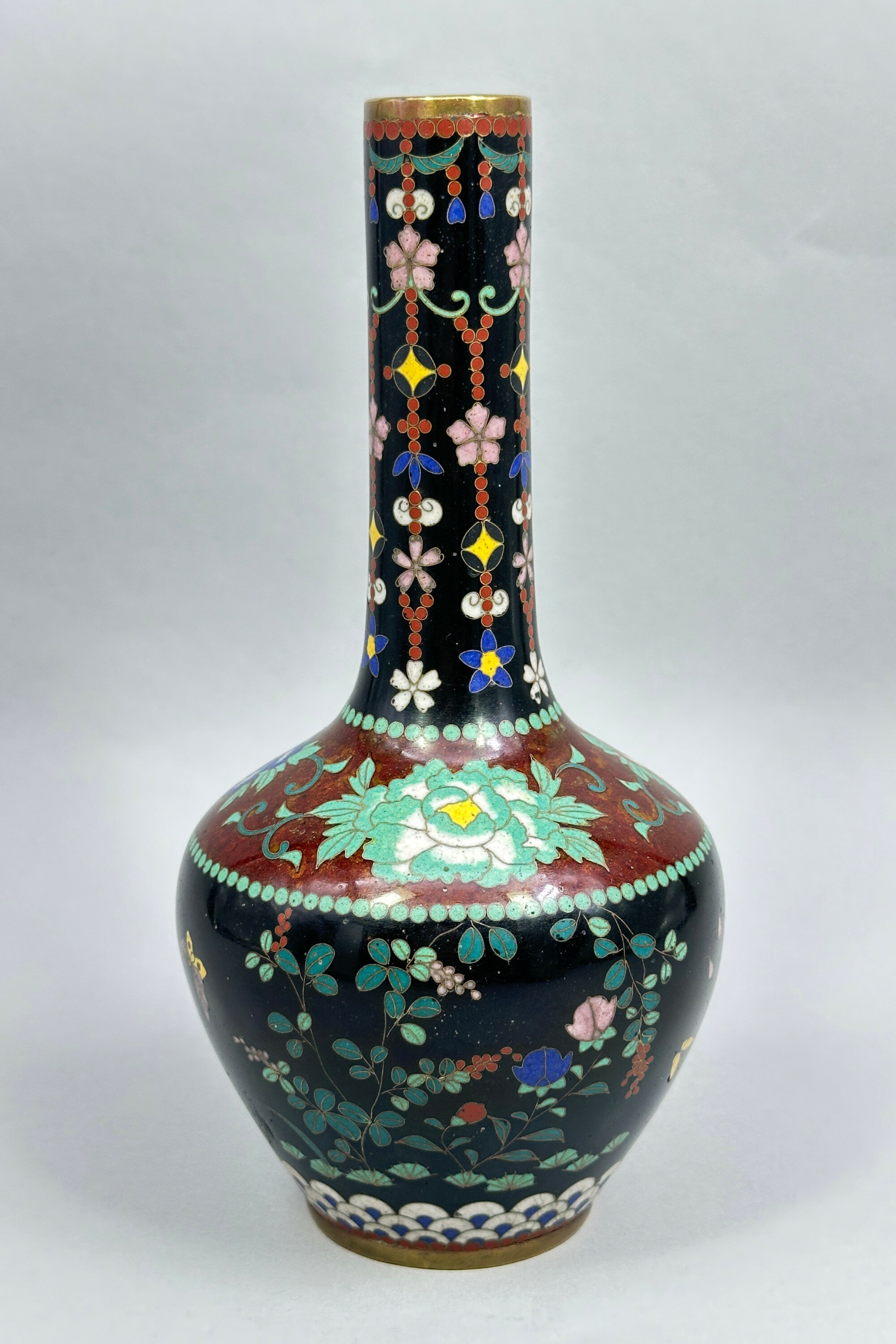
Fine quality Japanese Cloisonne bottle form Vase with black ground, late C19th
Price: £45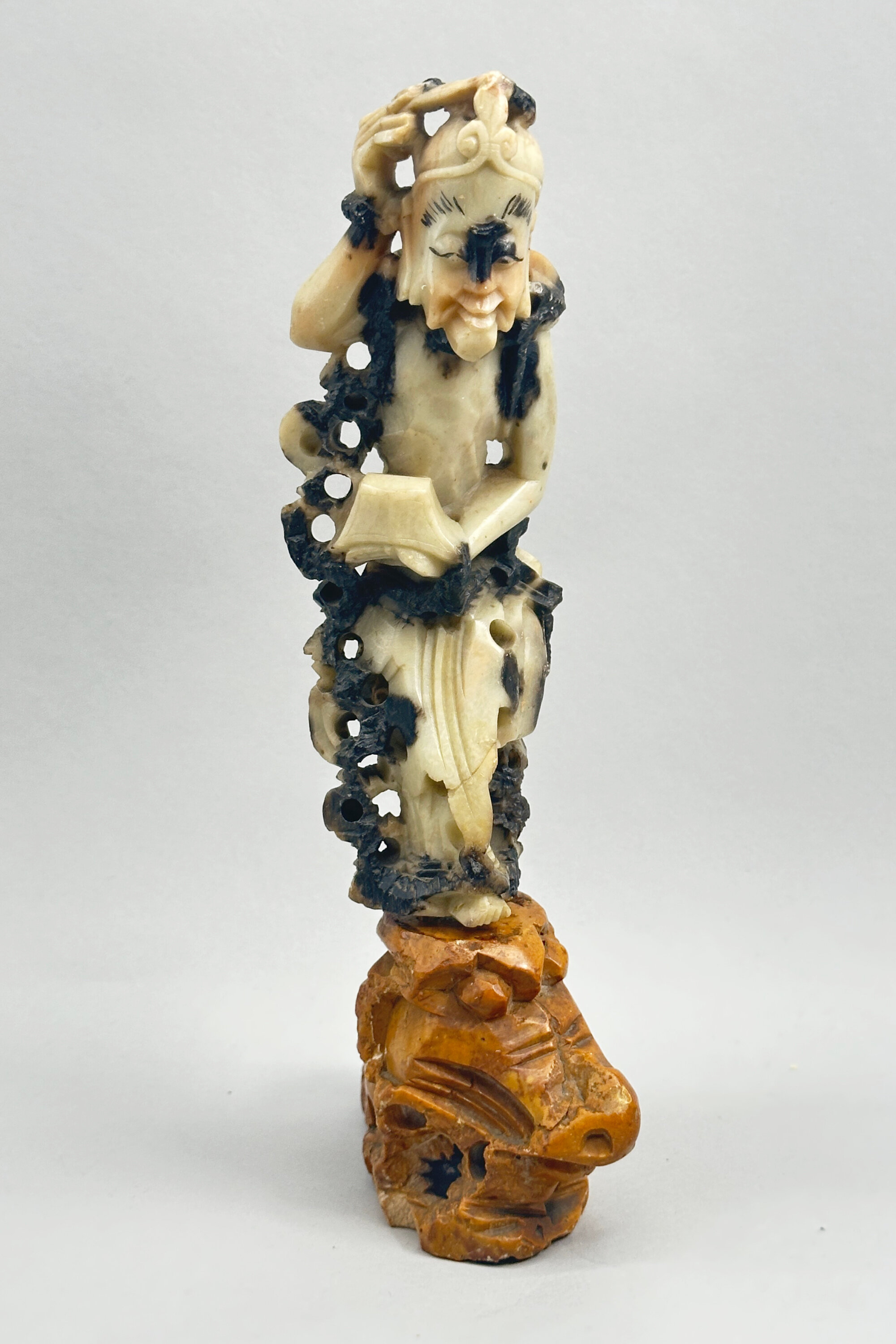
Chinese carving of a Beggar, possibly Shoushan stone, Soapstone stand, C20th
Price: £55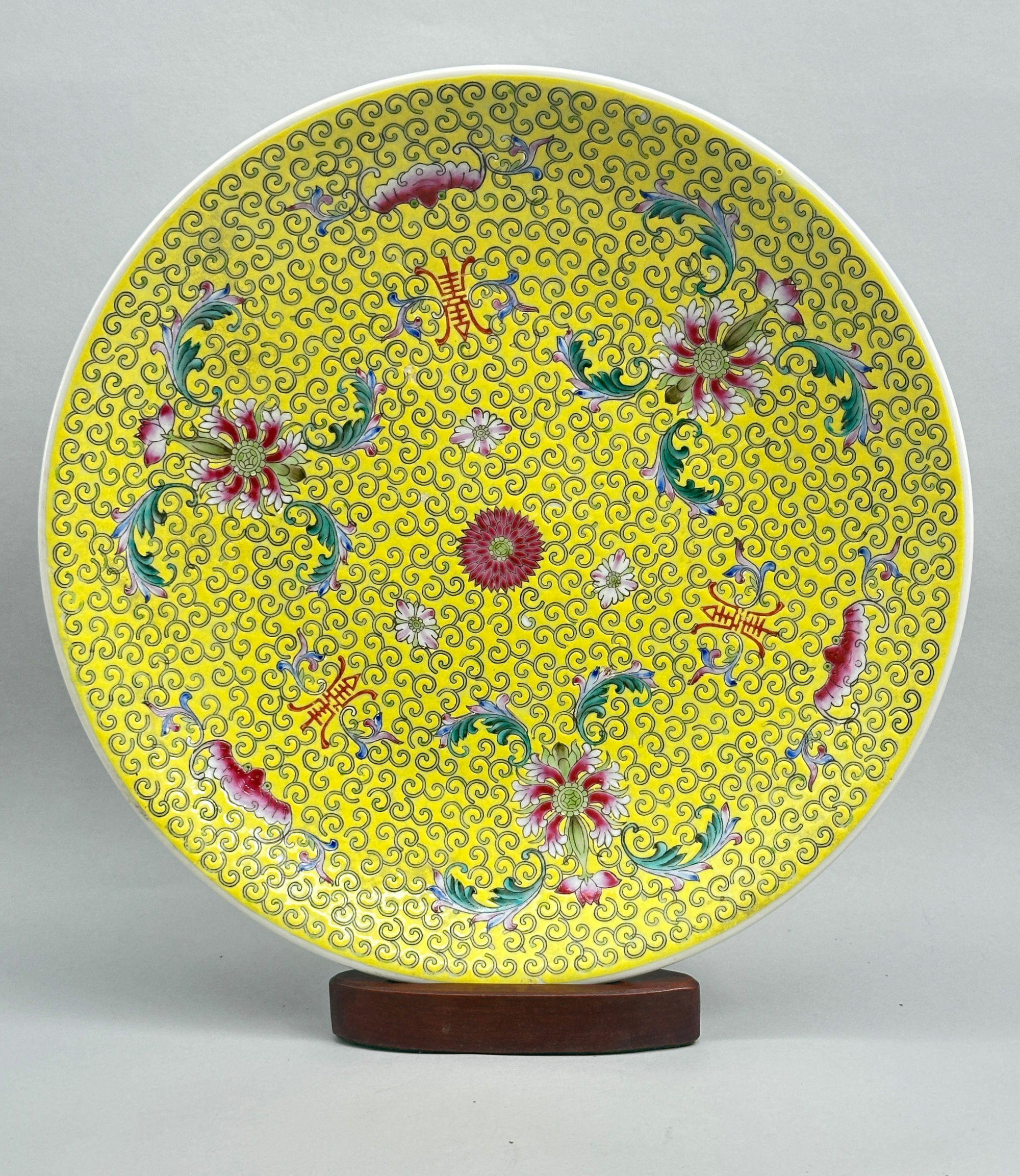
Chinese Yellow Ground Famille Rose Charger, 1950s/early 1960s
Price: £55This is a fine example of the porcelains made at Jingdezhen, for centuries the chief centre of ceramic production in China, in the early years of the People’s Republic of China (1949-). Soon after the communists took control, the kilns at Jingdezhen were organised into co-operatives, each with a number. Many of their pieces were marked and the form of the mark determines the date of production. The circular marks, as here, were the earliest allowing a dating of this charger to the 1950s or possibly the early 1960s. Some of these conglomerates, for the quality can vary, retained the skills of their predecessors and produced works of high quality. This is clearly seen here in the careful and precise enamelling and the general artistry of the design employing ‘imperial’ yellow with the symbolism of happiness (bats), longevity (shou symbols), friendship and a life of ease (chrysanthemum) and fruitfulness and offspring (lotus), all combining to produce a piece well worthy of its many predecessors.
Please note that the wood stand is for display purposes only and is not incuded with this lot.
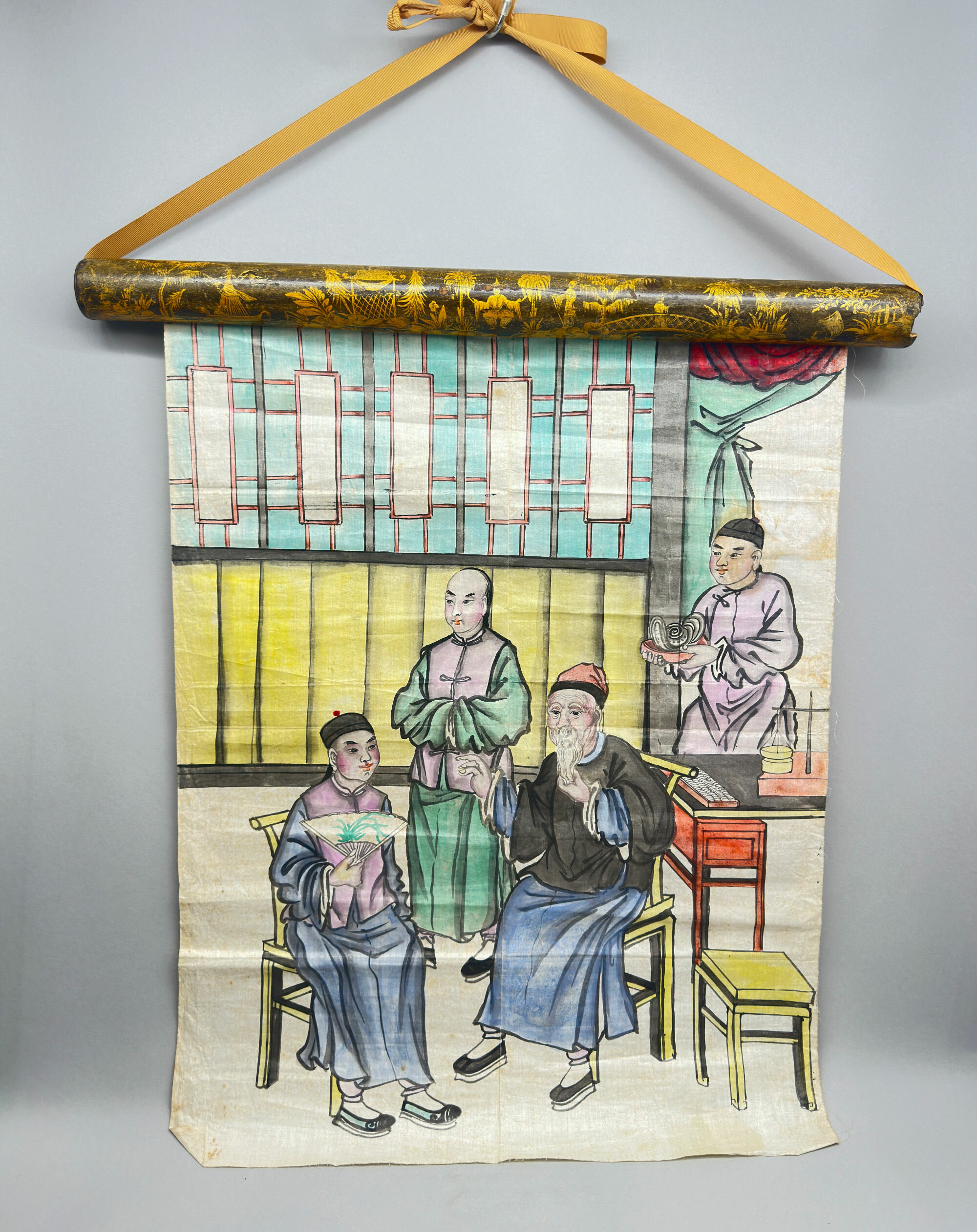
Chinese Scroll Painting of a Merchant and his Client, C20th
Price: £45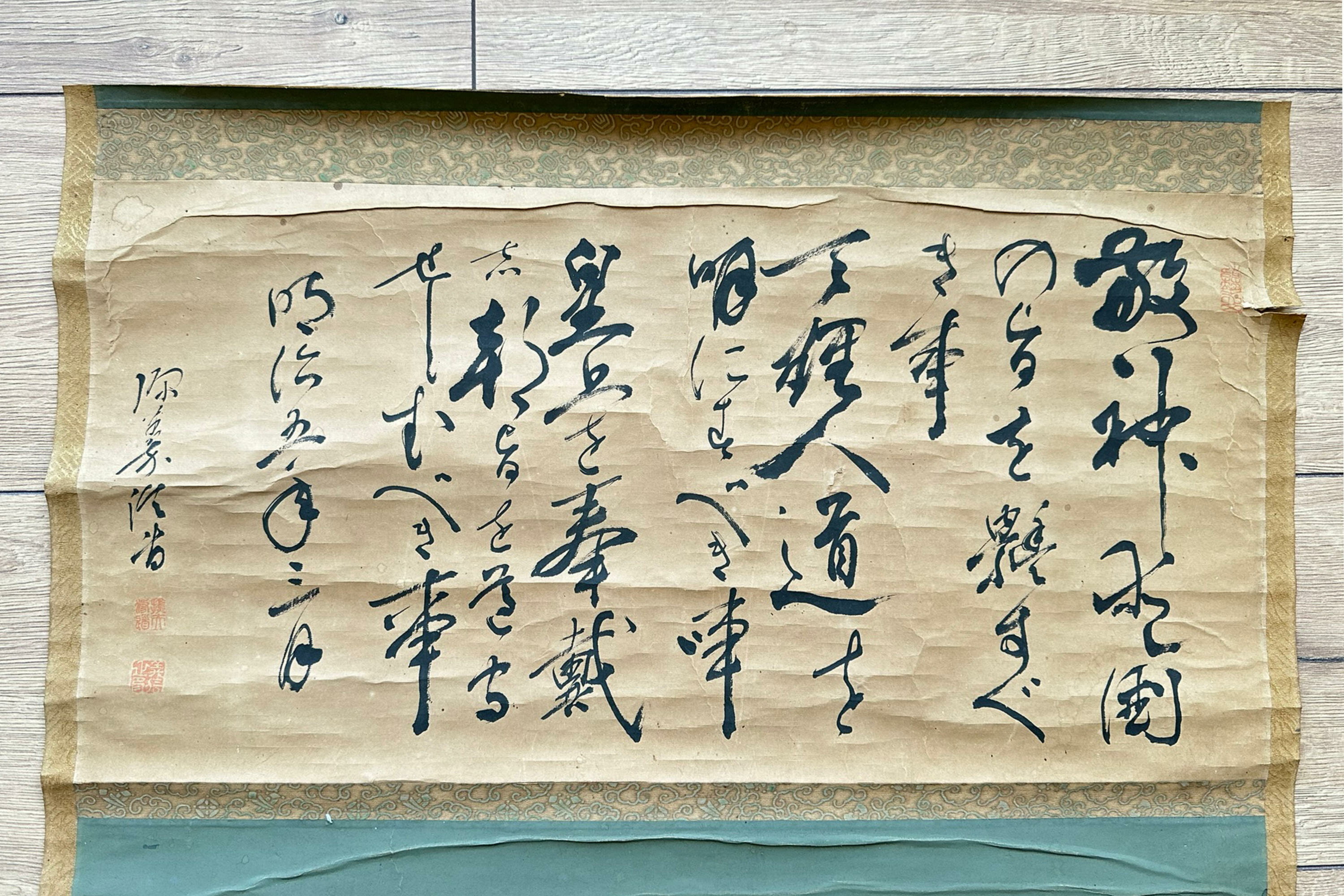
Chinese Calligraphy Scroll, Qing Dynasty (1636-1912)
Price: £25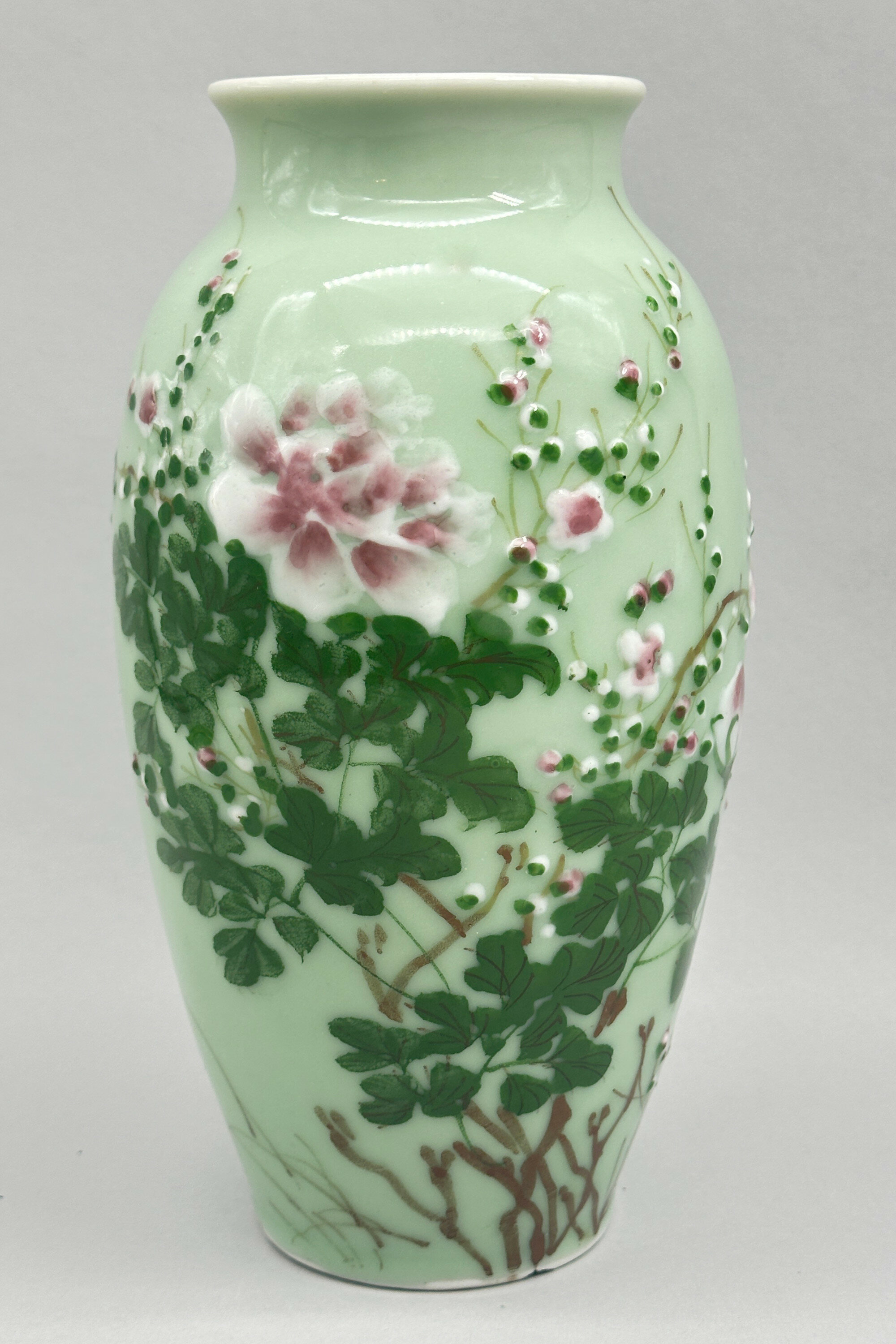
Japanese Celadon glaze vase with enamel decoration, late C19th
Price: £25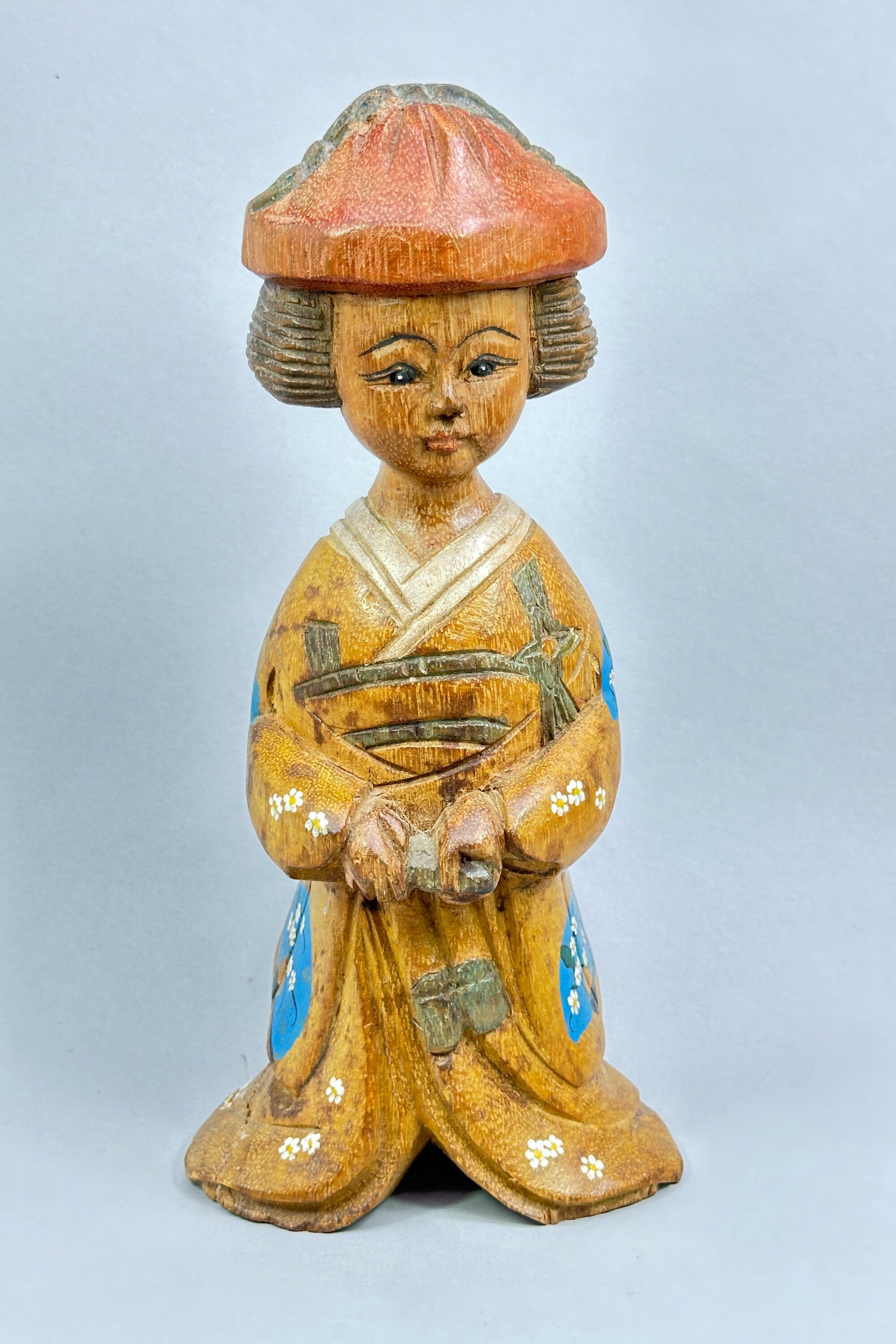
Japanese Carved Wood Figure of a Young girl, Kokeshi doll style, C20th
Price: £45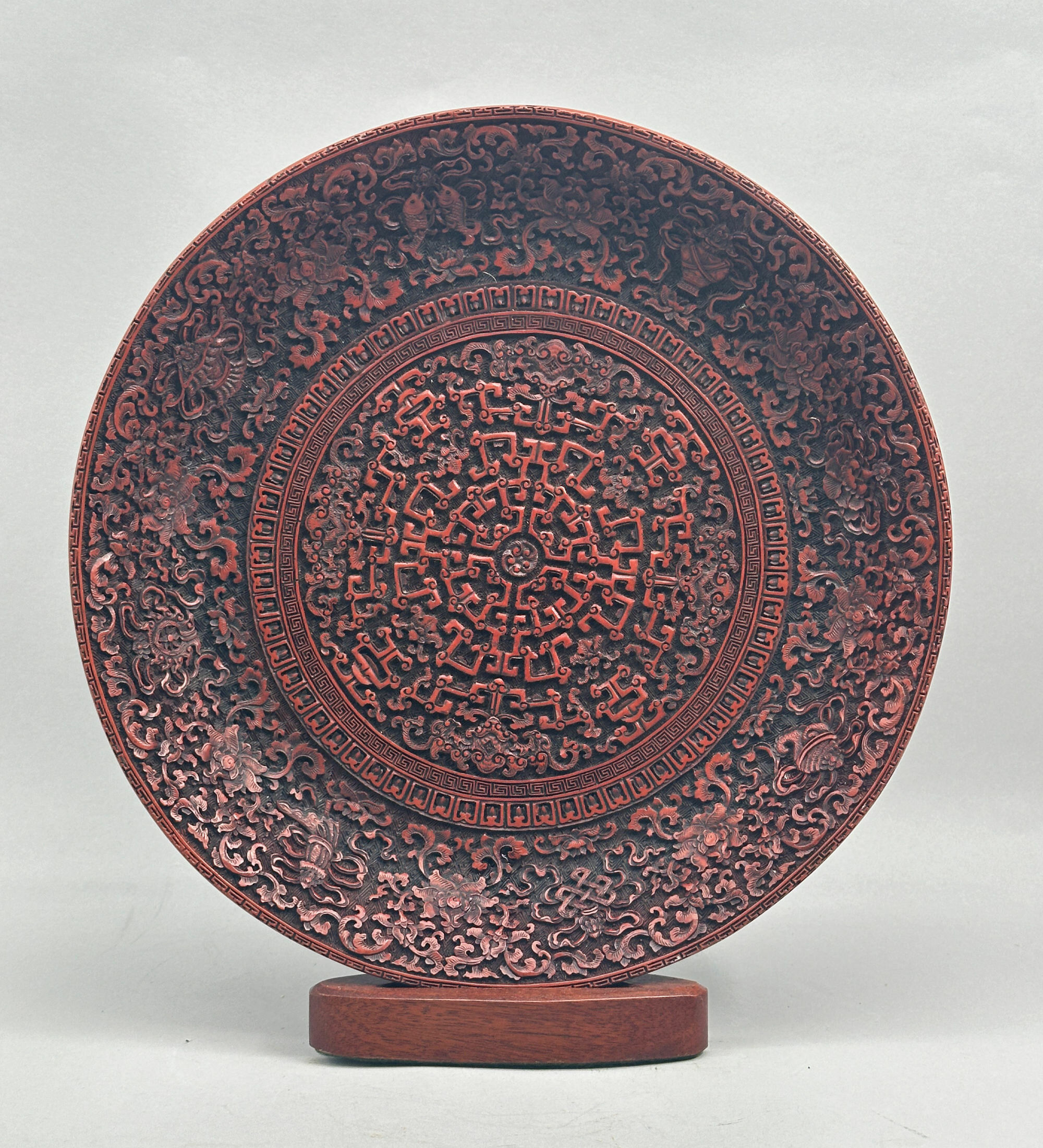
Fine quality reproduction Cinnabar Lacquer Dish with the Eight Treasures, Modern
Price: £180In 1972, the museum commissioned copies of the fifty pieces included in an exhibition of lacquerware held in that year of which this dish was one. These were clearly stamped with the museum’s mark. Examples of these can be found on the market today but, by repute, forgers took moulds from these reproductions and then produced copies of their own without the museum mark. Various examples of the ones created from the museum copy of this dish can also be found on the market today, sometimes at quite high prices. Usually these include the Qianlong mark found on the original which this piece does not. It is also of extremely high quality and it is hard to see that it was created from a mould of a mould copy. Its exact history is therefore uncertain, but if appreciated in itself it is a highly attractive decorative object, in a sense of 'museum quality’. And obtainable at a fraction of the price its original would cost!
Images 13 and 14 show the front and back of the museum exhibit allowing comparisons to be made.
Please note that the wood stand is for display purposes and is included with this lot.
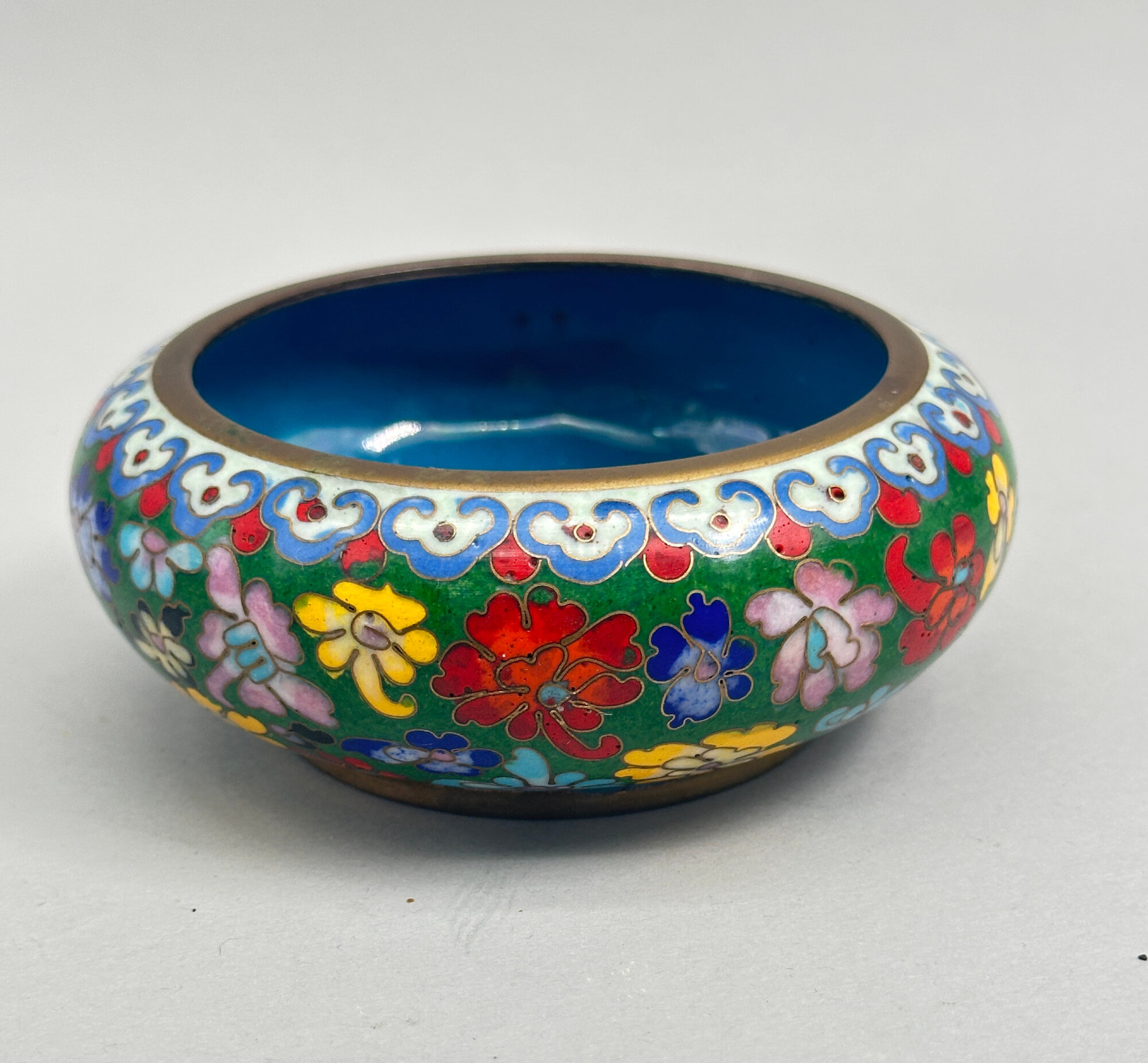
Chinese Cloisonne Shallow Bowl, C19th
Price: £45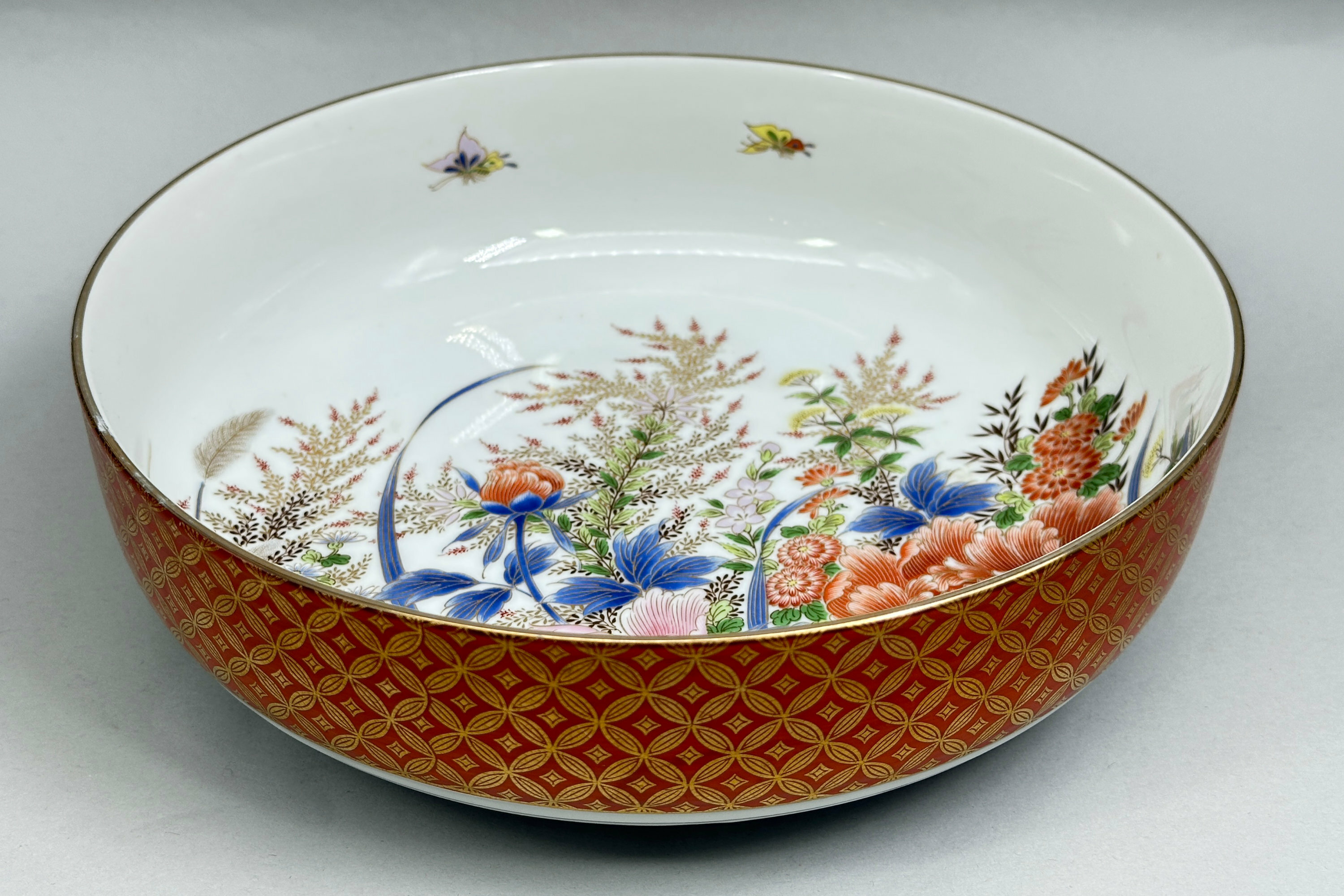
Japanese Polychrome Bowl, Shibata Toki ware, late c20th
Price: £45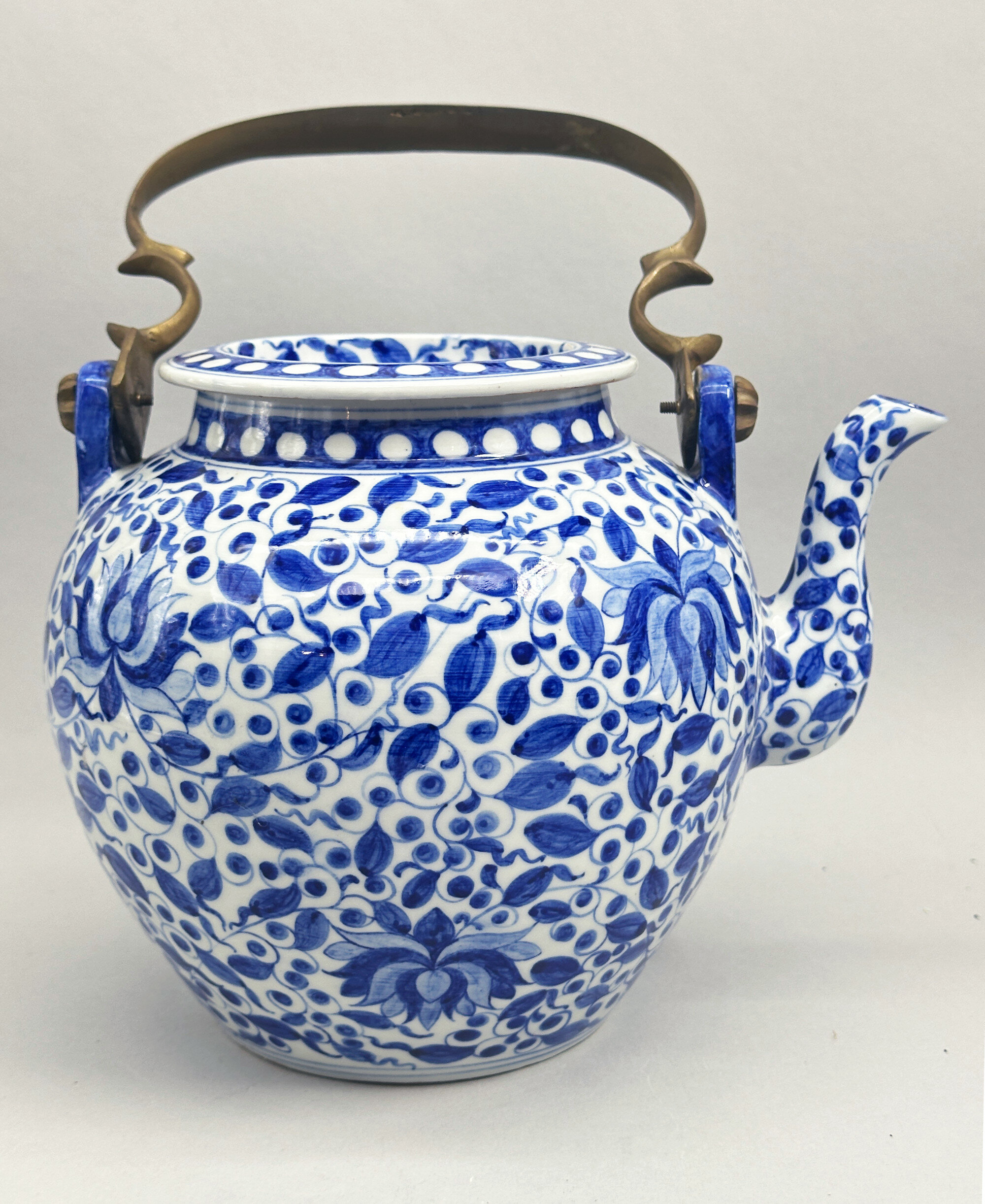
Exceptionally large Chinese Blue and White Teapot with metal handle, C19th
Price: £350The form here, without a ceramic handle but with an attached carrying handle, suggests a travelling teapot, a well known variation of the teapot type produced in China but rarely found on such an epic scale. Presumably this piece was intended for use at a rather large gathering or banquet so that a multitude of guests could be served at once! The paste of the footrim, style of decoration and clearly visible hand thrown potting rings (see images 8 and 9) all point to late nineteenth century work which is confirmed by the minute vertical lines seen on the exterior which are often found on blue and white pieces from that period. It is sometimes suggested that these brass handles, for similar examples can be found, were made in Thailand but there is little evidence for this. However, a local audience rather than an international one seems more than likely since there would have been little call for such a serving item in Western homes.
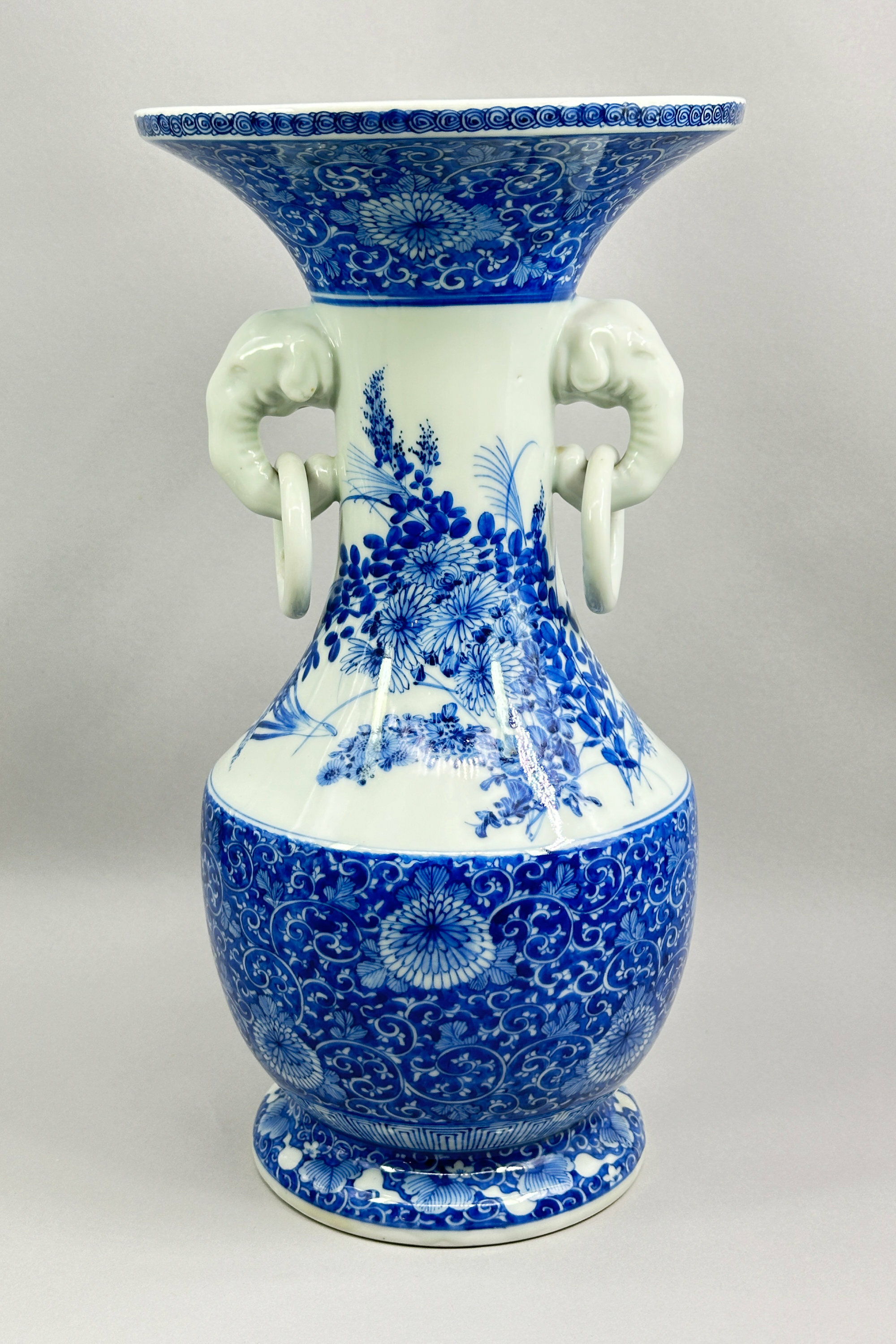
Japanese Seto Ware Blue and White Vase, late C19th
Price: £450A fine quality Japanese porcelain vase, the ovoid body with a curved flaring foot and rising to a tall concave neck with a well defined shoulder, applied elephant and ring handles to the sides and a galleried rim, decorated in bright underglaze blue with two bands of stylised flowering chrysanthemum at the top and bottom between a continuous scene of flowering peony and chrysanthemum, the top rim with repeating whorl design on the exterior and stylised leaf design inside, the stepped base glazed white.
The kilns at Seto in the Aichi prefecture of Japan and situated close to Nagoya form one of the traditional ‘Nihon Rokkoyo’, the six old kilns of medieval Japan. The location of Seto was ideal for the production of ceramics with an abundance nearby of both porcelain clay and forests to provide firewood for the kilns. Production began as early as the Heian period (794-1185) and continued without a break thereafter, the earlier pieces being more pottery forms copying Chinese wares. It was in the early nineteenth century that the kilns turned to producing porcelains decorated in underglaze blue and white, a development initiated by the potter Tamikichi Kato who went to Arita to learn the techniques of its production there, returning to Seto in 1807. Production grew and developed and was directed towards the export market in the Meiji period (1868-1912) with Seto wares being displayed at the European and North American exhibitions and fairs. Their delicately painted designs of birds and flowers proved to be immensely popular and were, in their time, to influence Art Nouveau and Art Deco designs. Some of the forms produced were truly virtuoso creations including, besides vases, screens, jardinieres and even ceramic tables.
Signed pieces are known and besides Tamikichi Kato the distinguished potters included the Kichiemon brothers, Kato Chuji and Kawamoto Jihyoe, and Kawamoto Hansuke. But not all the best pieces carried an artist’s signature as this vase well demonstrates. Formed from fine quality clay, as can be seen from the foot rim (image 10), the complex shape with its spreading base, angled shoulder and galleried rim would have been difficult to create. The handles show remarkable skill with the rings somehow formed so as to hang loose (presumably some form of kiln waster technique was used). The detail and artistry of the painting speaks for itself. Note in particular the shading effects on the peony flowers. While not perhaps an exhibition piece, this vase is definitely of exhibition quality and would be a worthy addition to a collection of nineteenth century Japanese ceramic art.
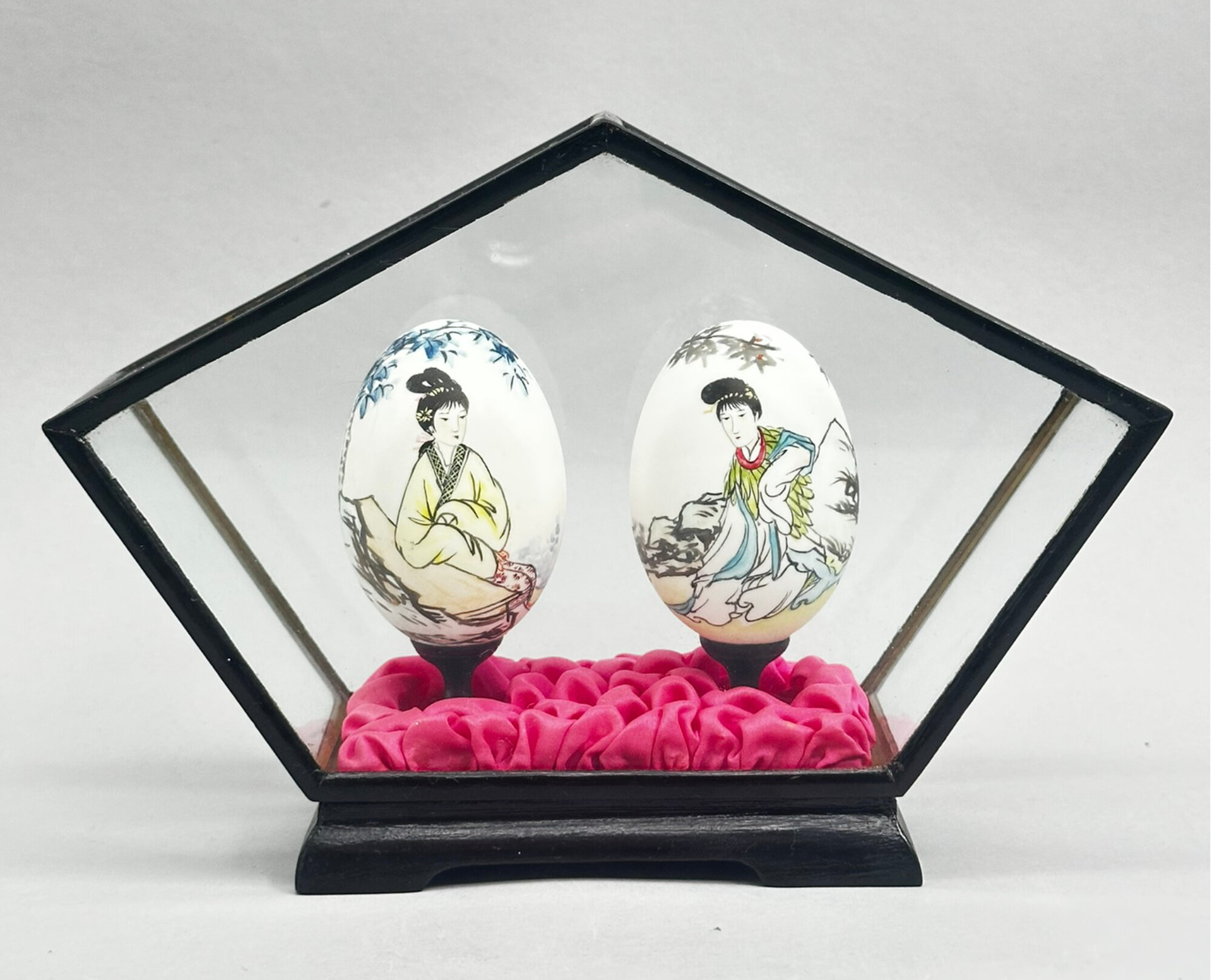
Pair of Chinese Hand Painted Eggs in Case, 1970s
Price: £25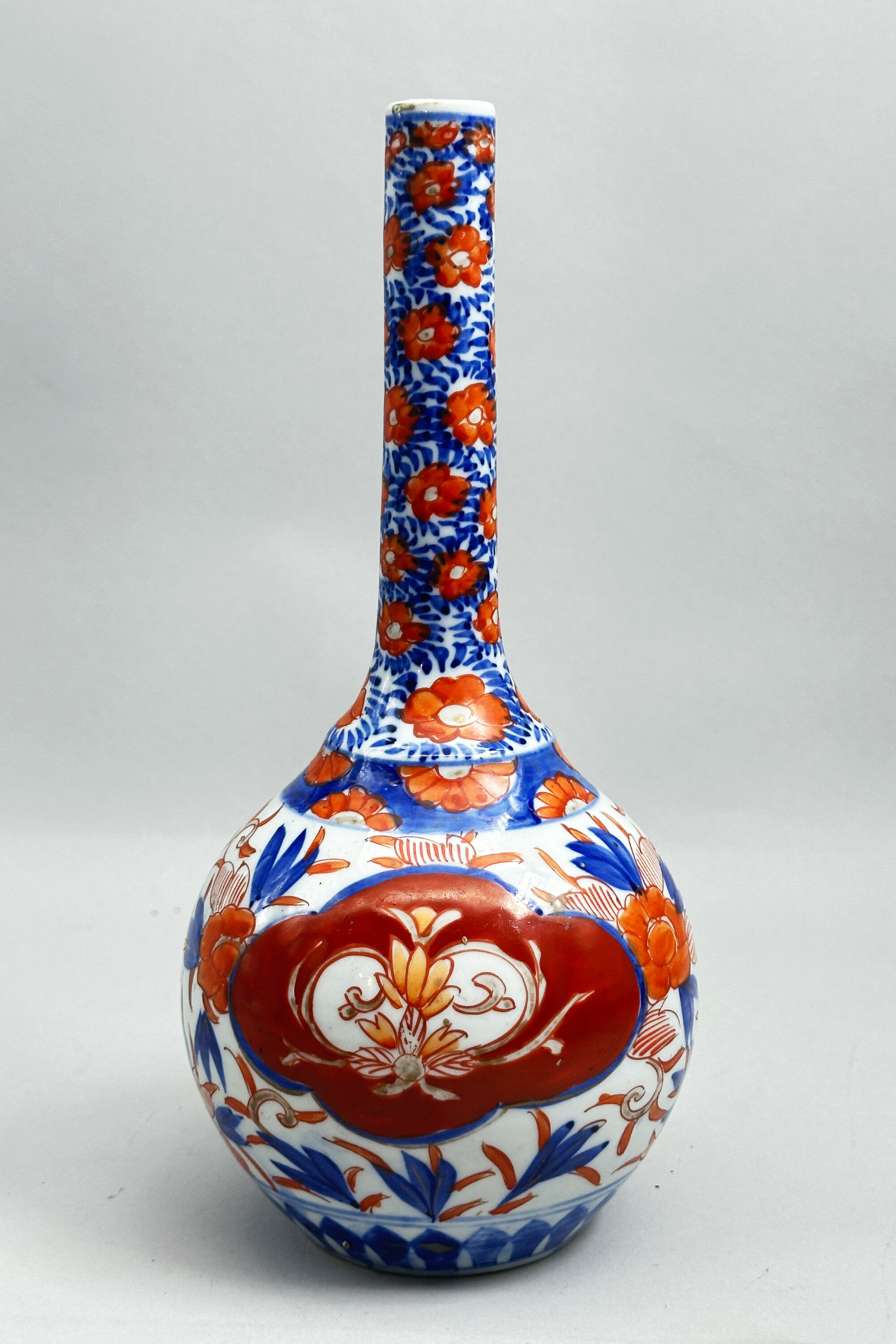
Japanese Imari Bottle Vase, circa 1900
Price: £30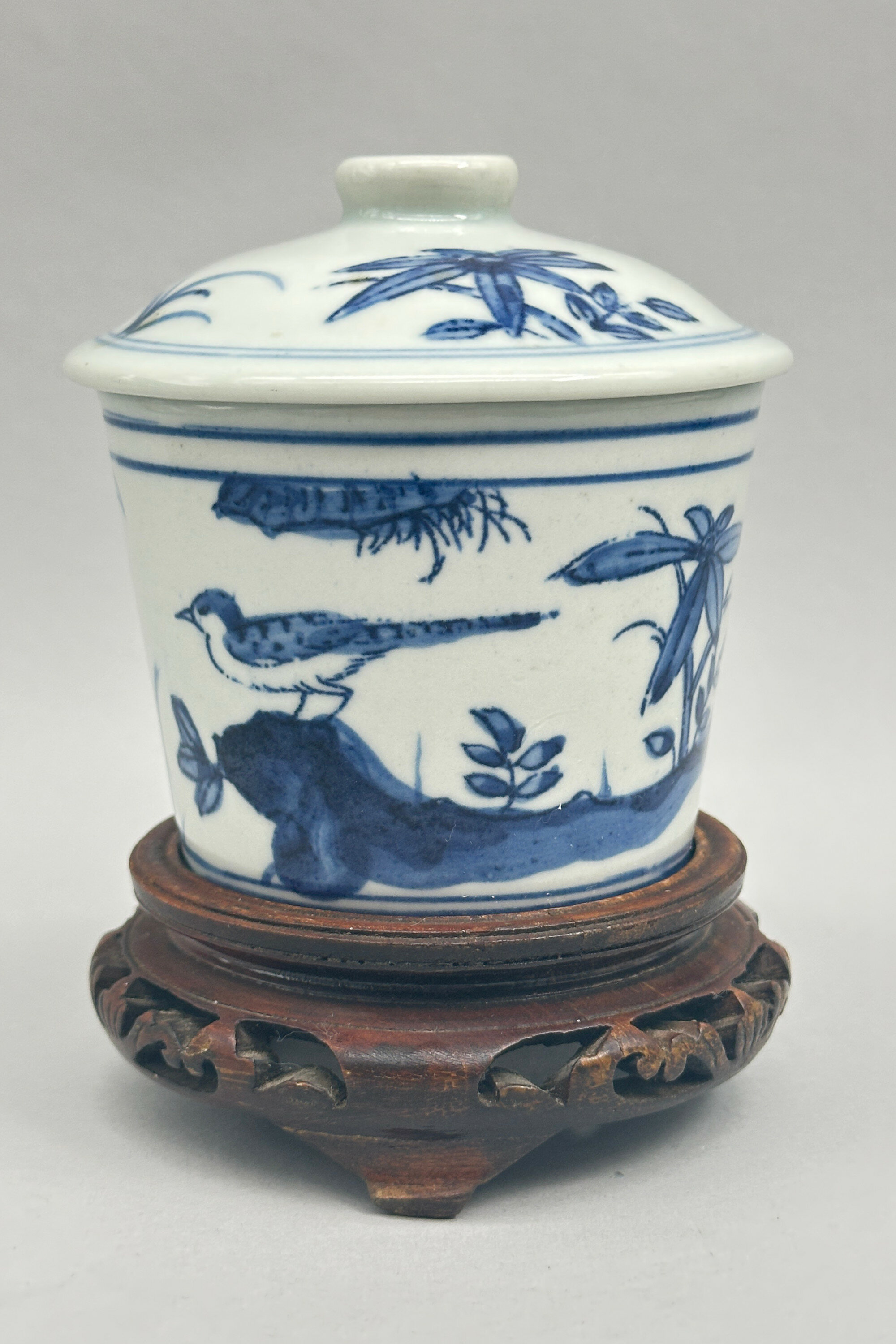
Chinese Small Blue and White Potiche and Cover with wood stand, late C20th
Price: £45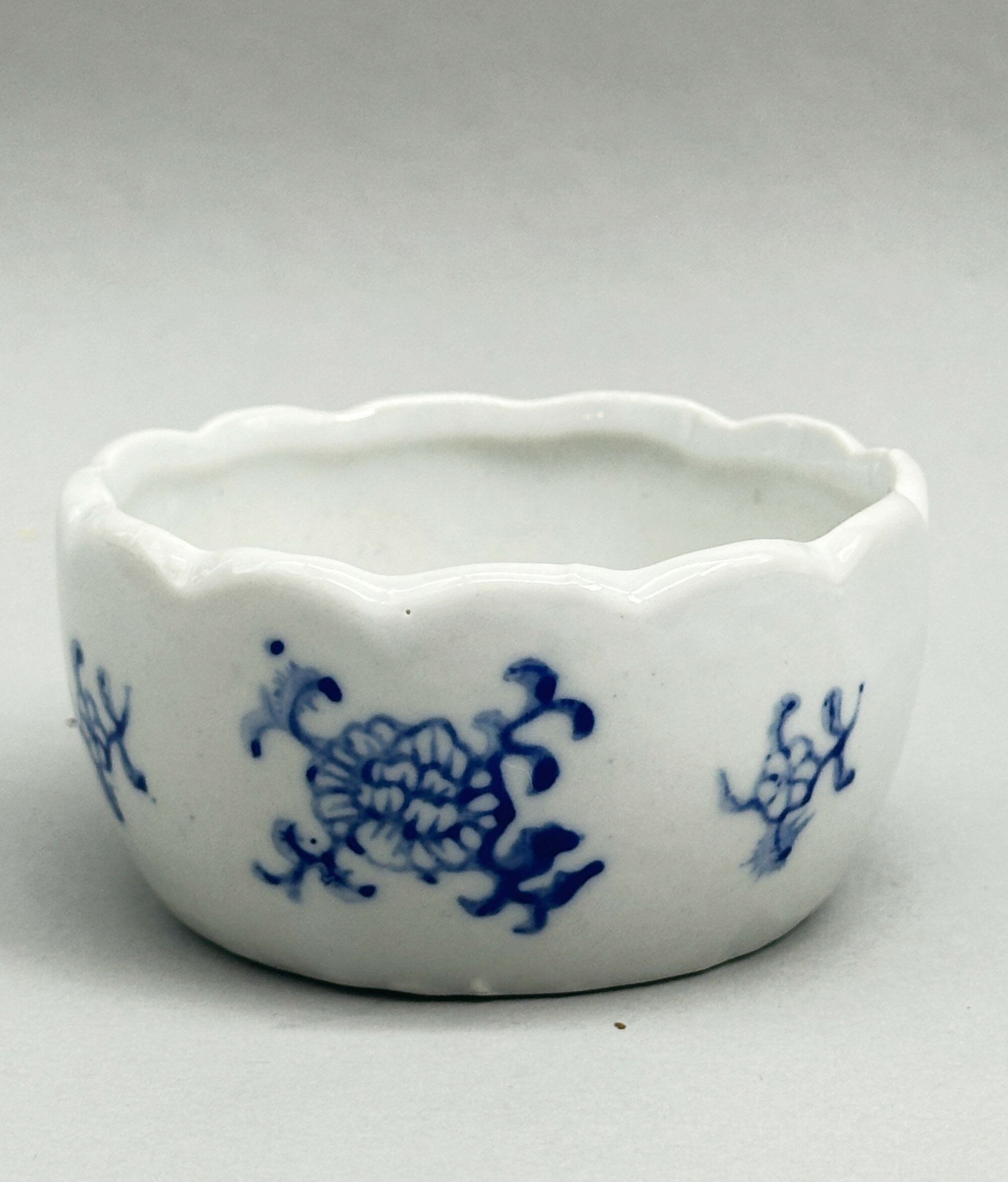
Japanese Arita Brushwasher, C20th
Price: £25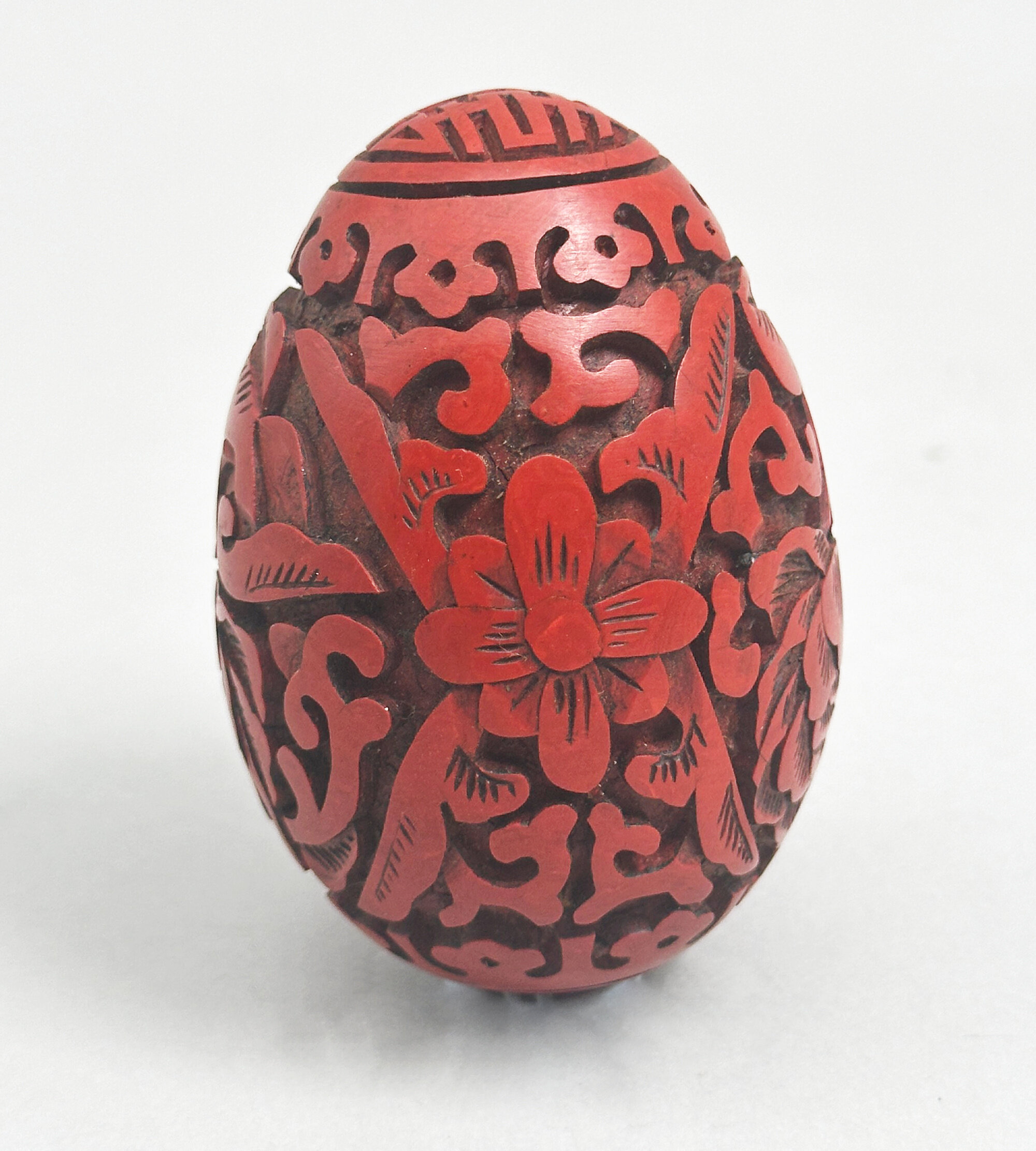
Chinese Cinnabar Lacquer Egg, C20th
Price: £55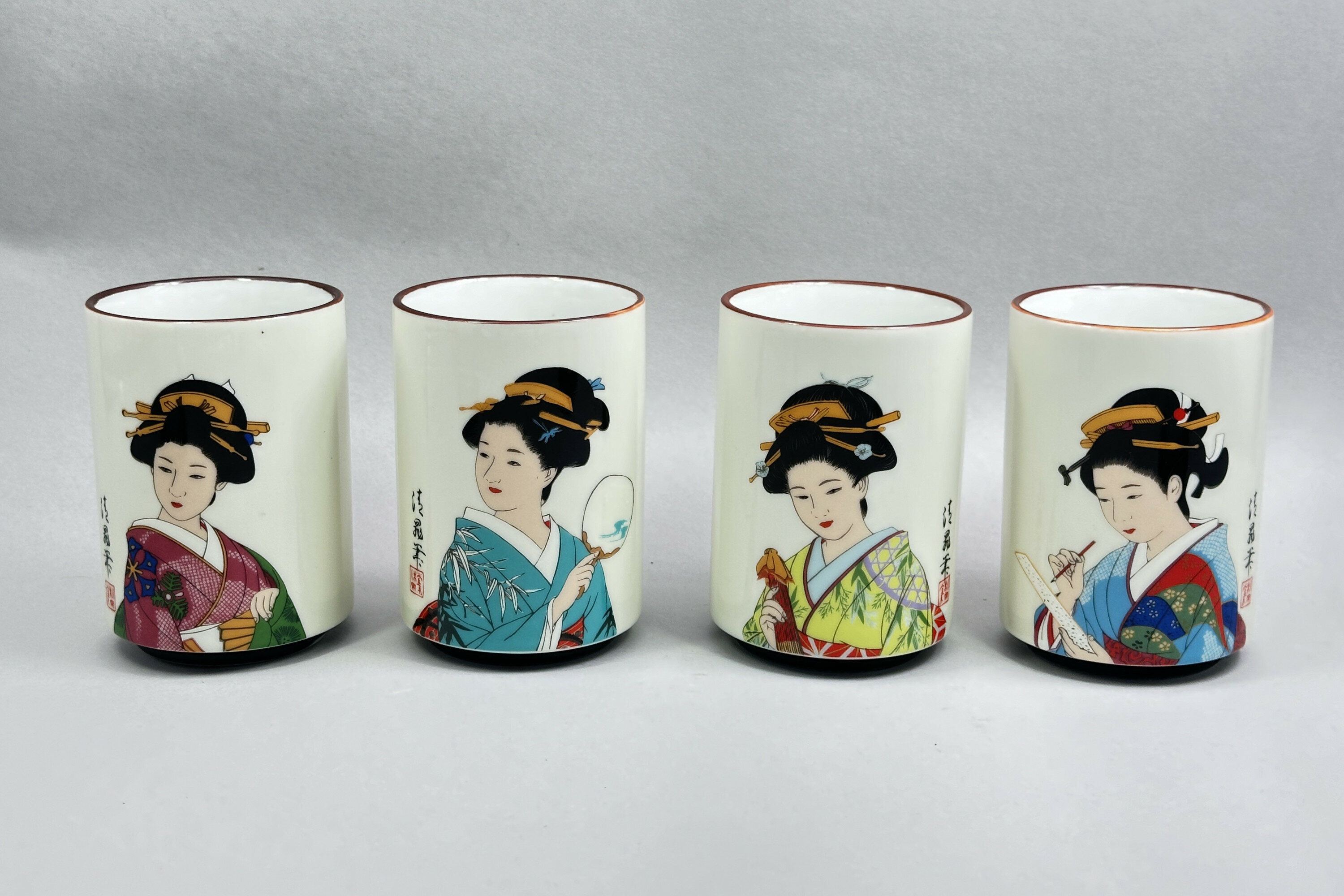
Set of Four Japanese Ceramic Beakers decorated Geisha, late C20th
Price: £40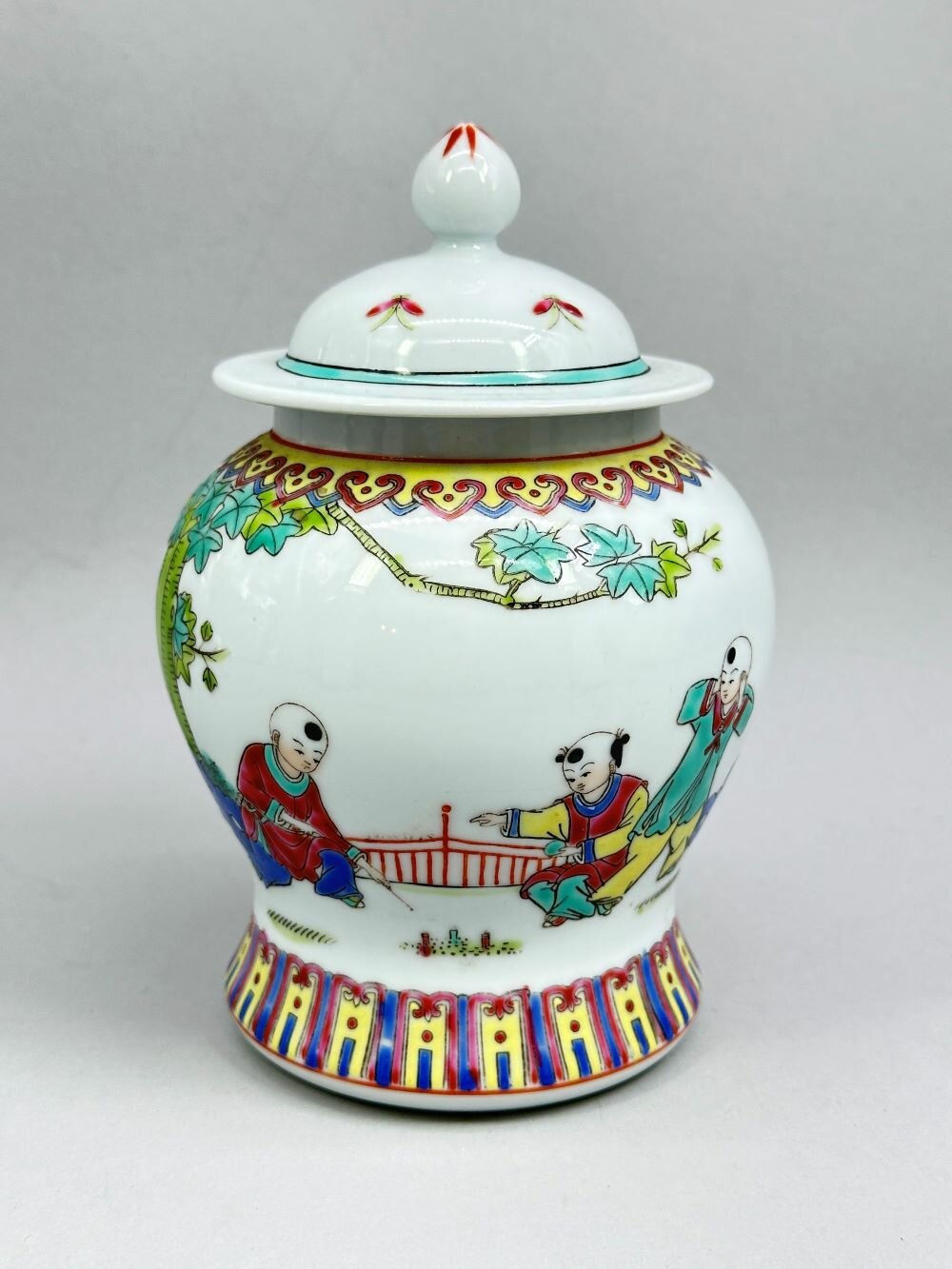
Chinese Republican Style Famille Rose small Baluster Jar and Cover, late c20th
Price: £20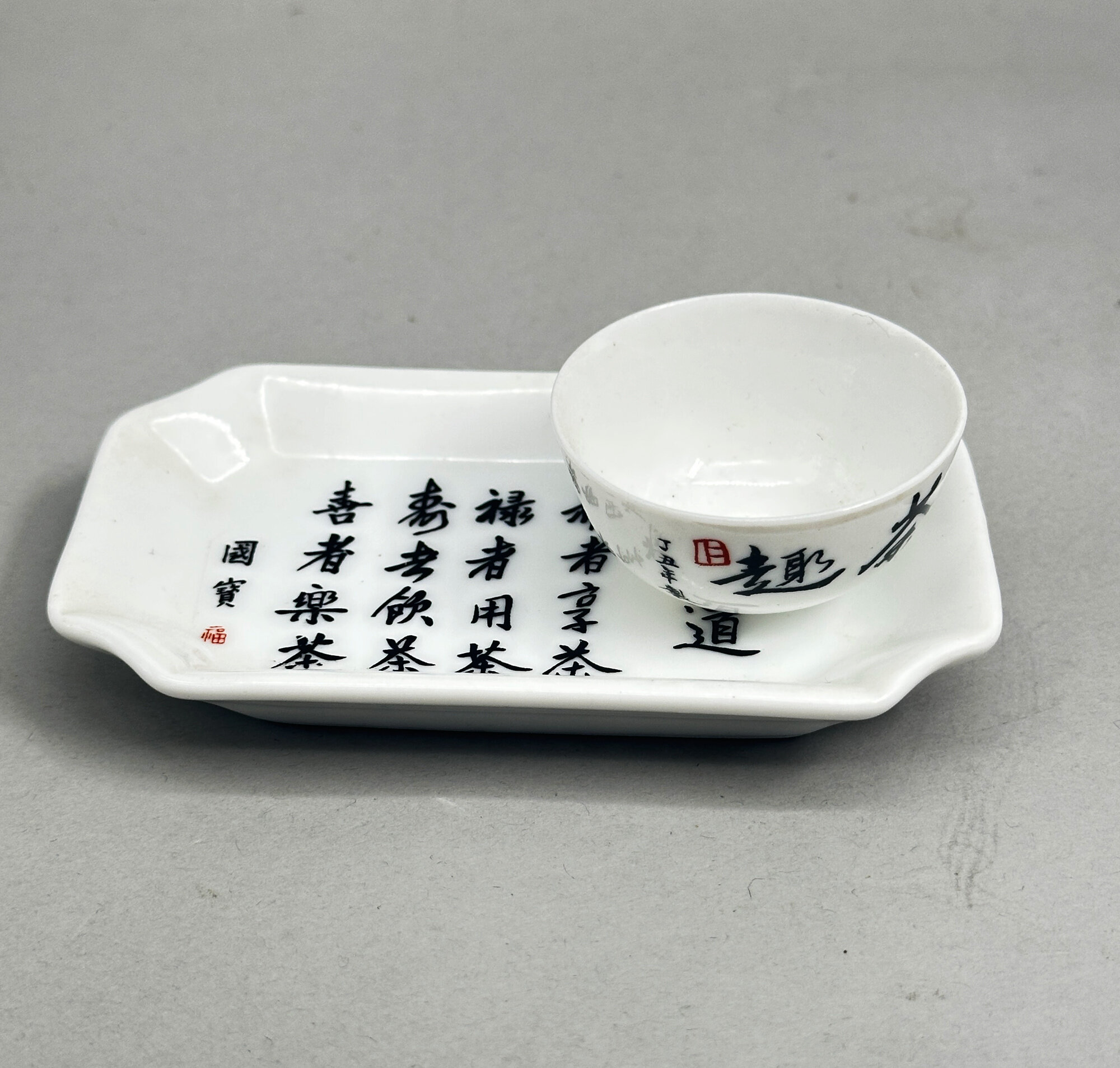
Chinese Porcelain Teabowl and Spoon Tray with calligraphy insciptions, 1997
Price: £15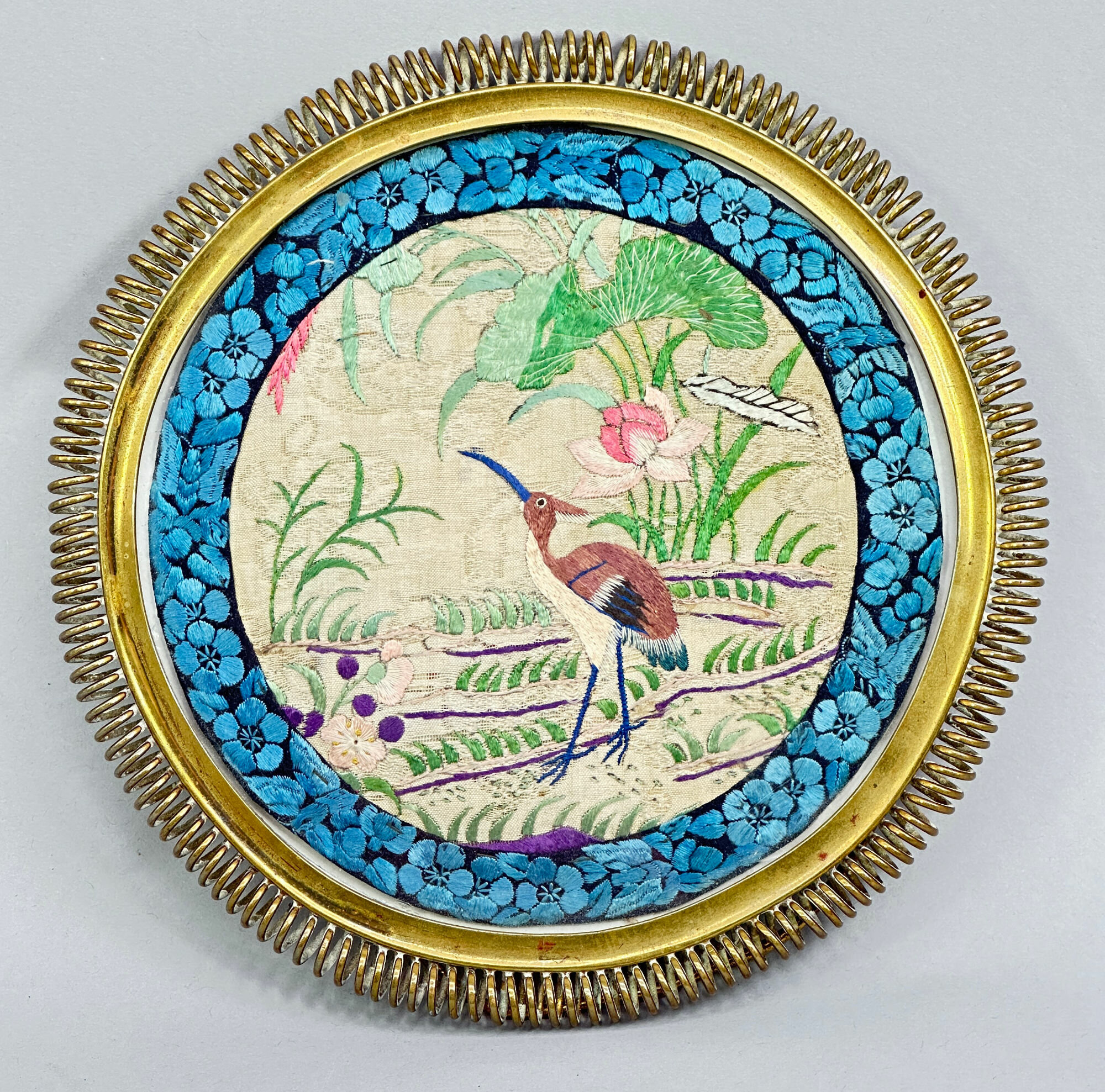
Chinese circular silk textile Panel in later European brass metal Frame, C19th/C20th
Price: £55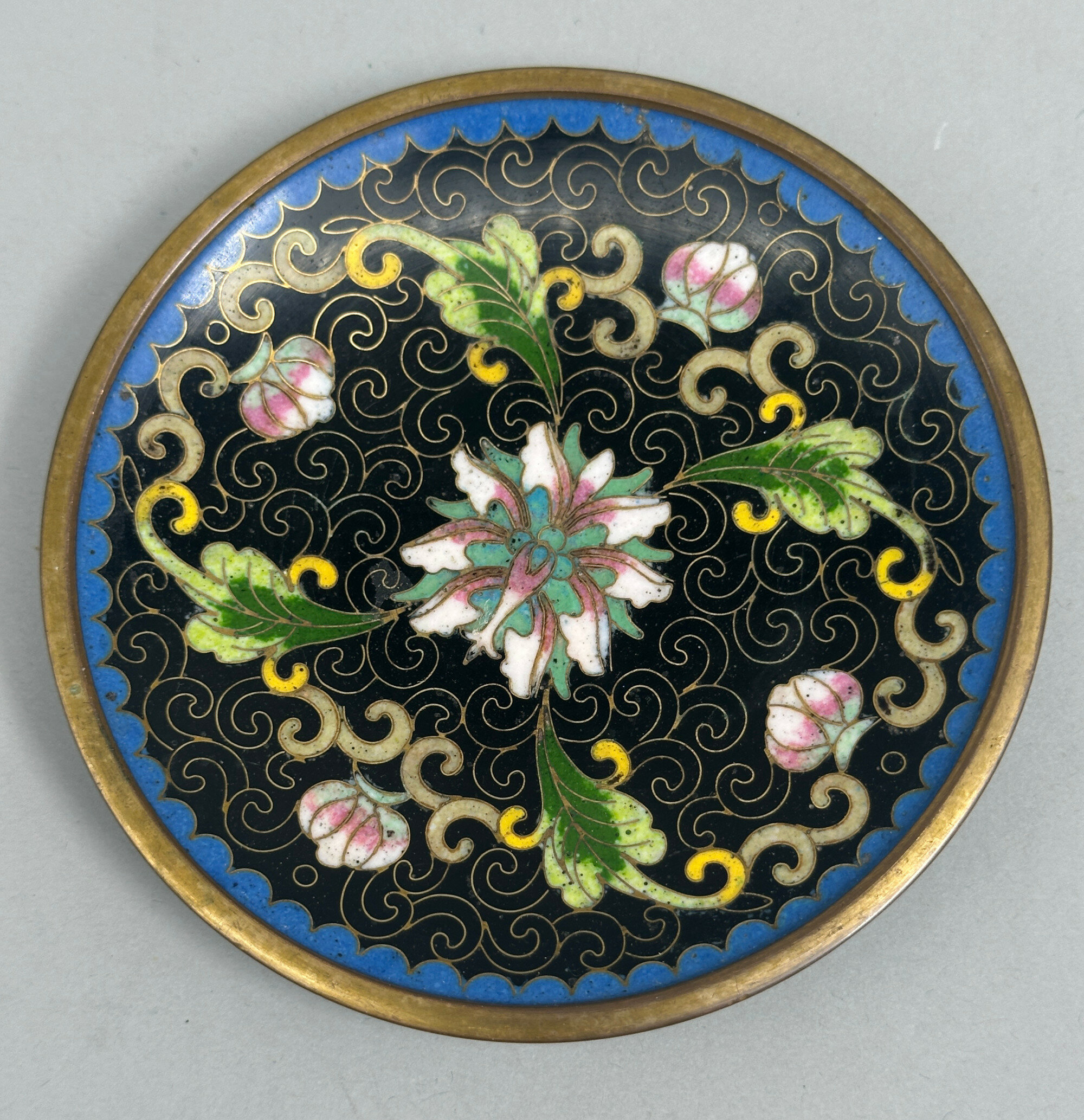
Small Chinese Cloisonné Dish decorated lotus, C20th
Price: £25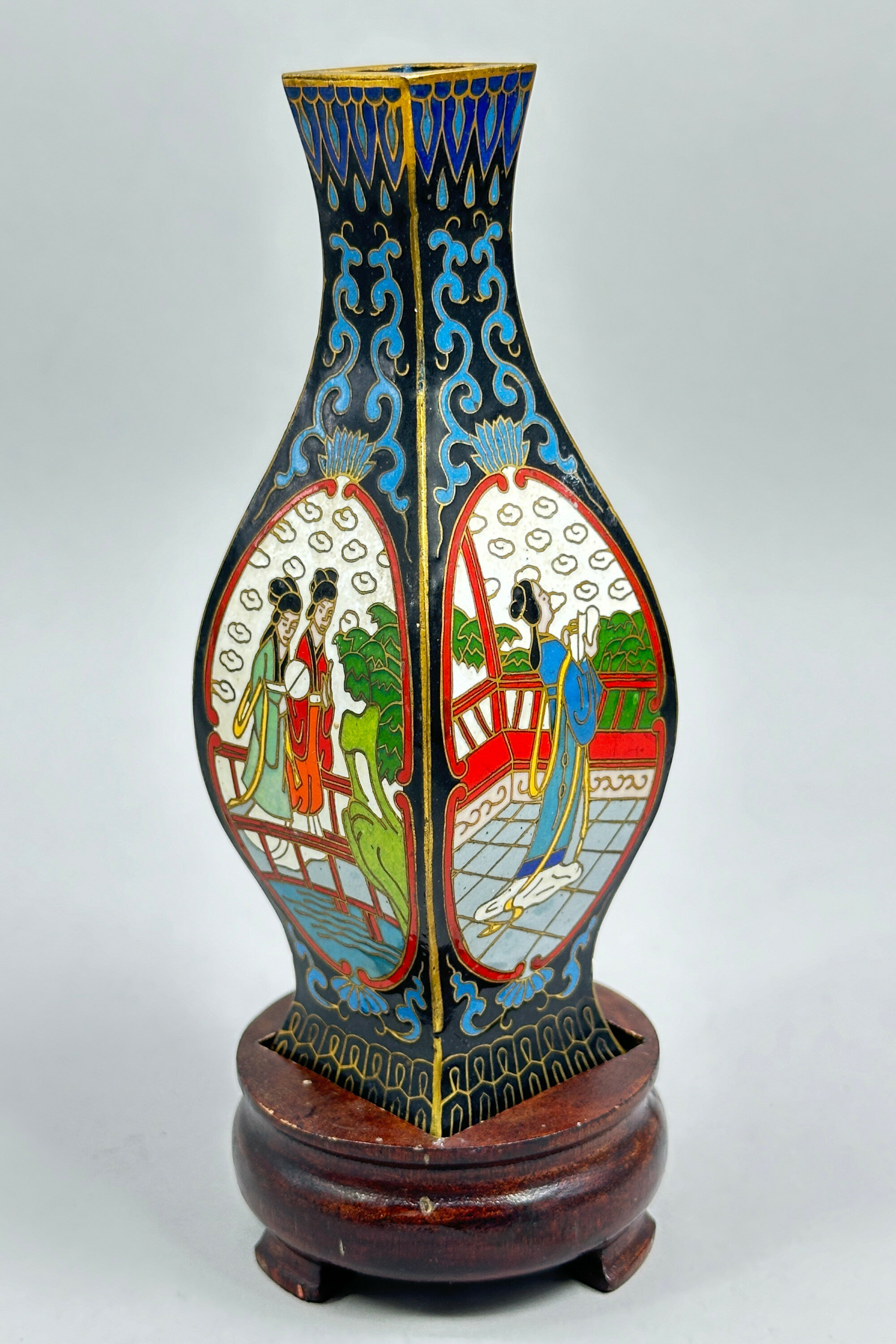
Chinese Cloisonné Square Vase on Stand, C20th
Price: £25The cloisonné technique, in which glass derived enamels were set in wire outlines (the so called ‘cloisons’ from the French word), was developed in China in the early Ming dynasty (1368-1644) and then used throughout, right up until the C20th, indeed pieces are still produced today. The style of enamelling here with fairly bold outlines to the decoration and the use of bright enamel colours suggests a dating here to the mid twentieth century which corresponds to the probable date of the accompanying wood stand. Perhaps intended as a desk ornament or possibly a flower vase, this piece could certainly find a home in a contemporary setting.
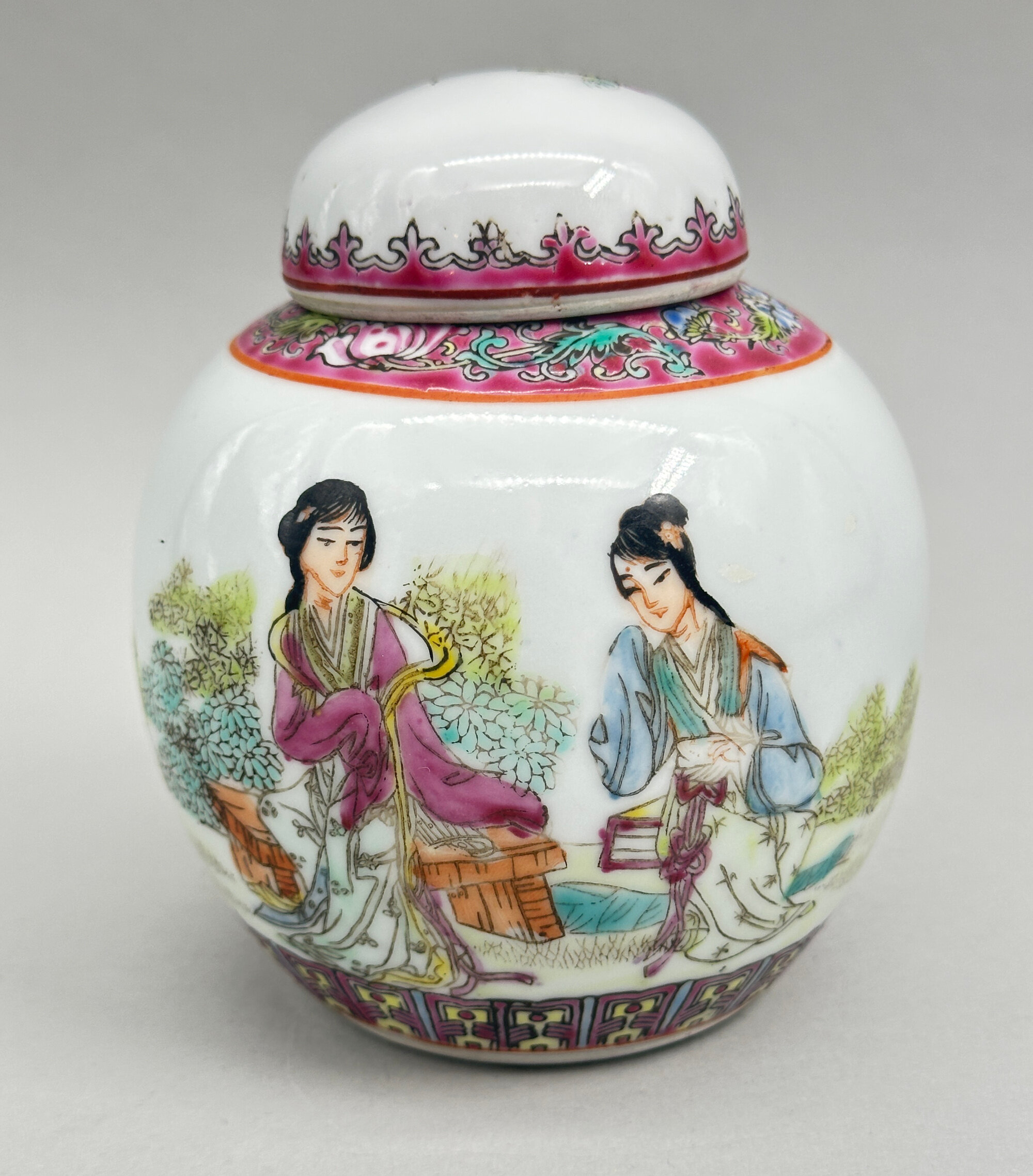
Chinese Republican Style small Famille Rose Ginger Jar and Cover, late c20th
Price: £20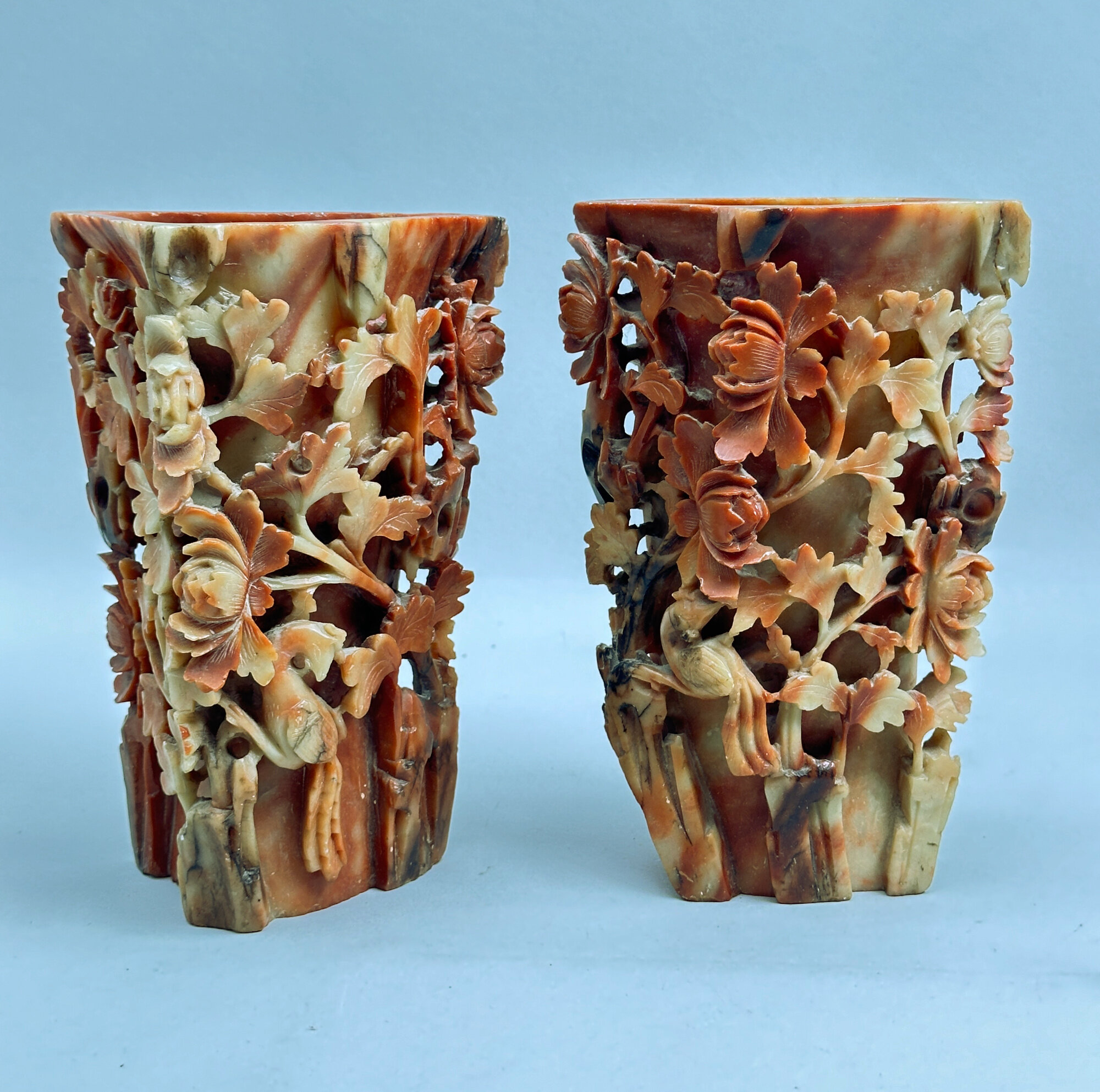
An unusual Pair of Chinese carved Soapstone Vases, circa 1900
Price: £110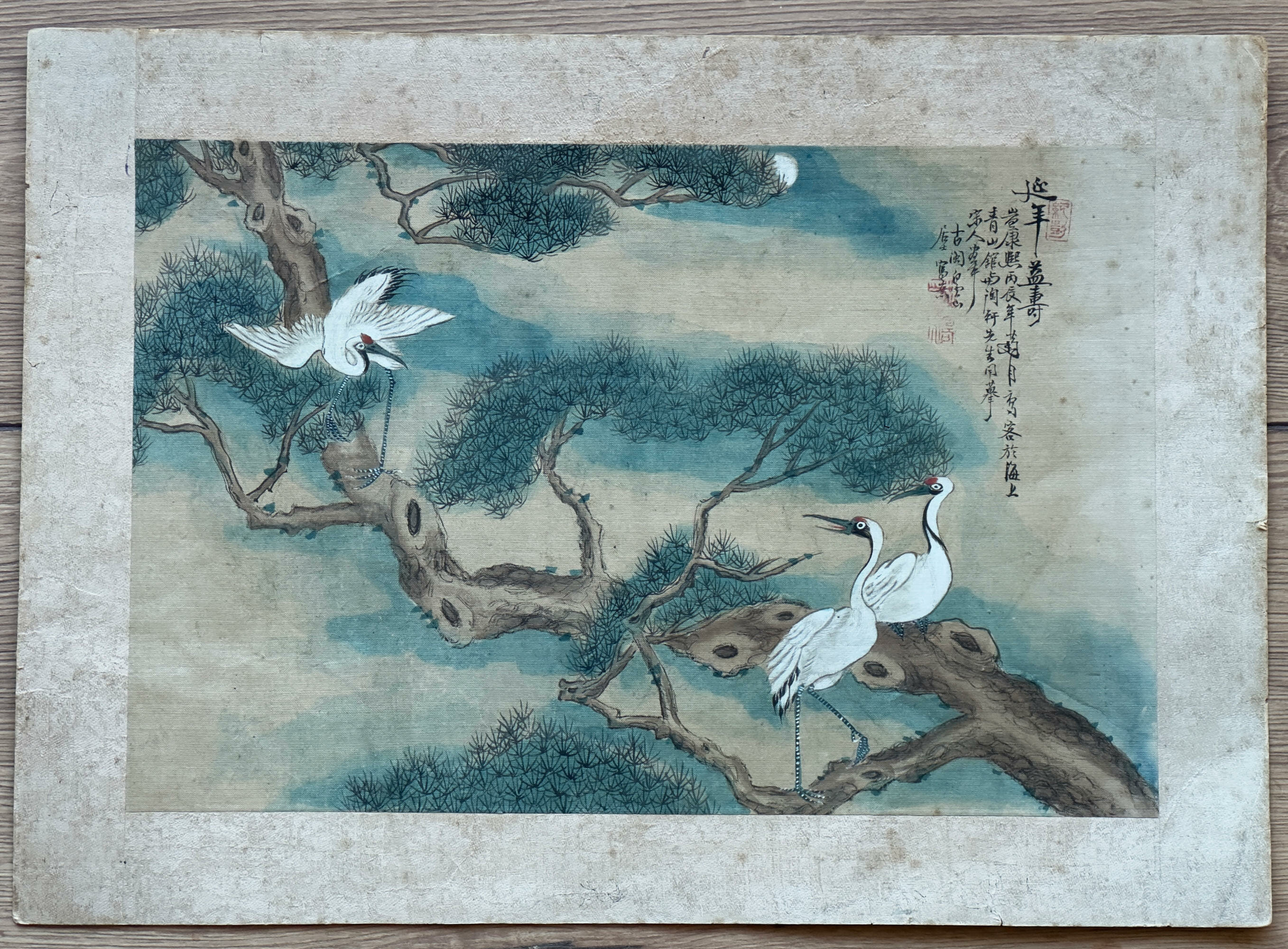
Chinese painting on Silk, Storks and Pine, circa 1900
Price: £25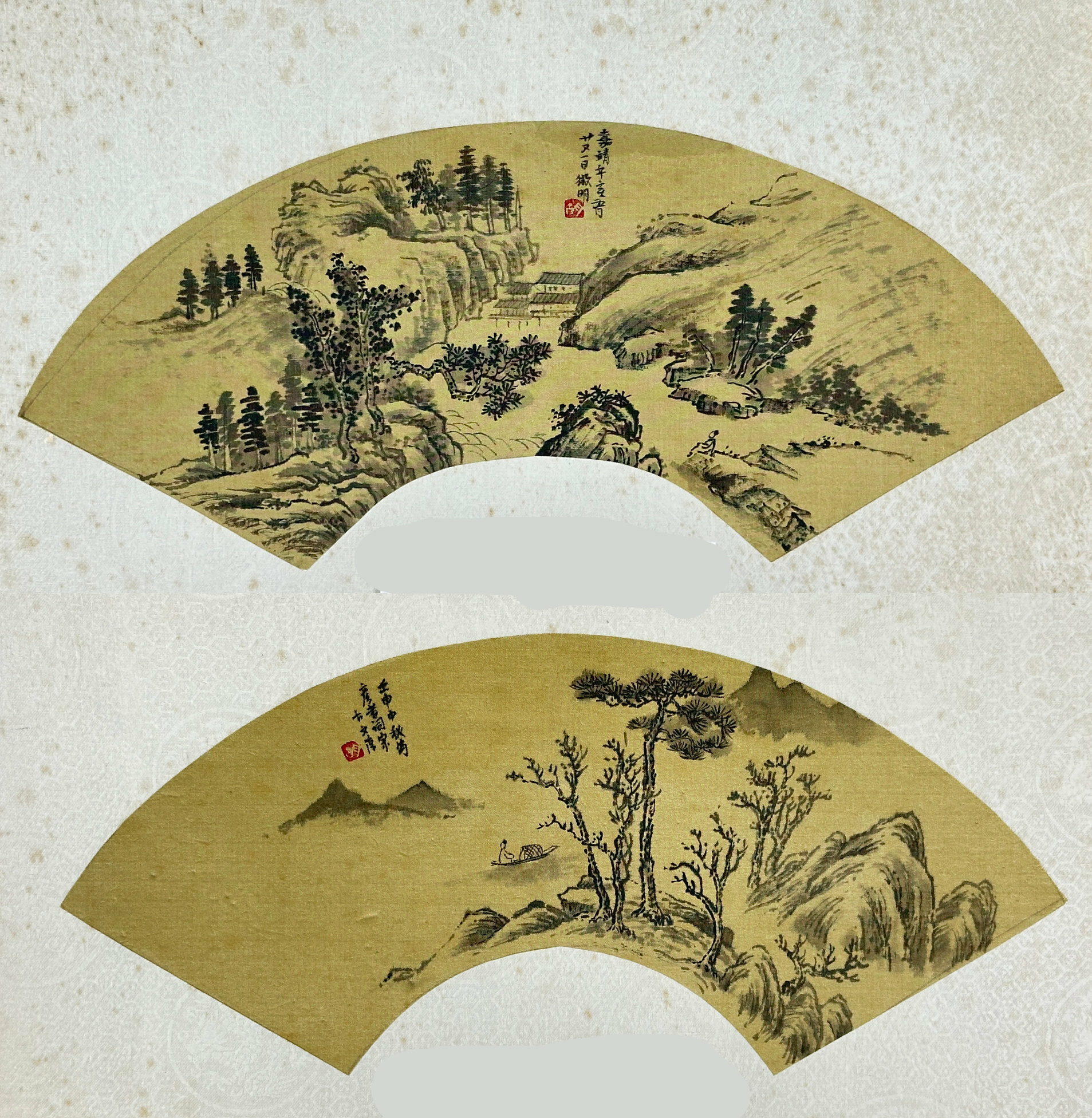
Two Chinese folding Fan Leaves with landscape scenes, now mounted, C20th
Price: £25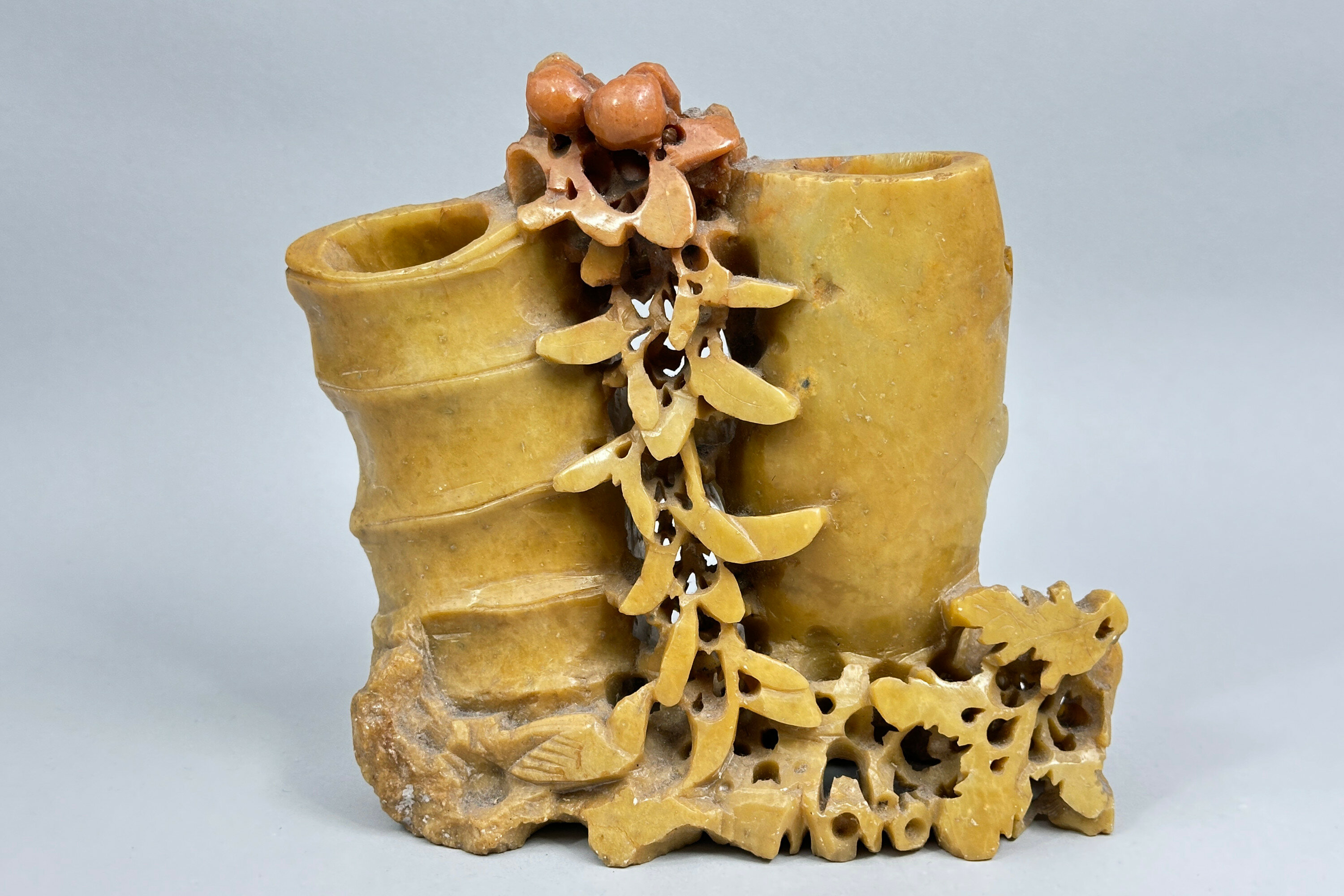
Chinese Soapstone Double Brushwasher, C20th
Price: £45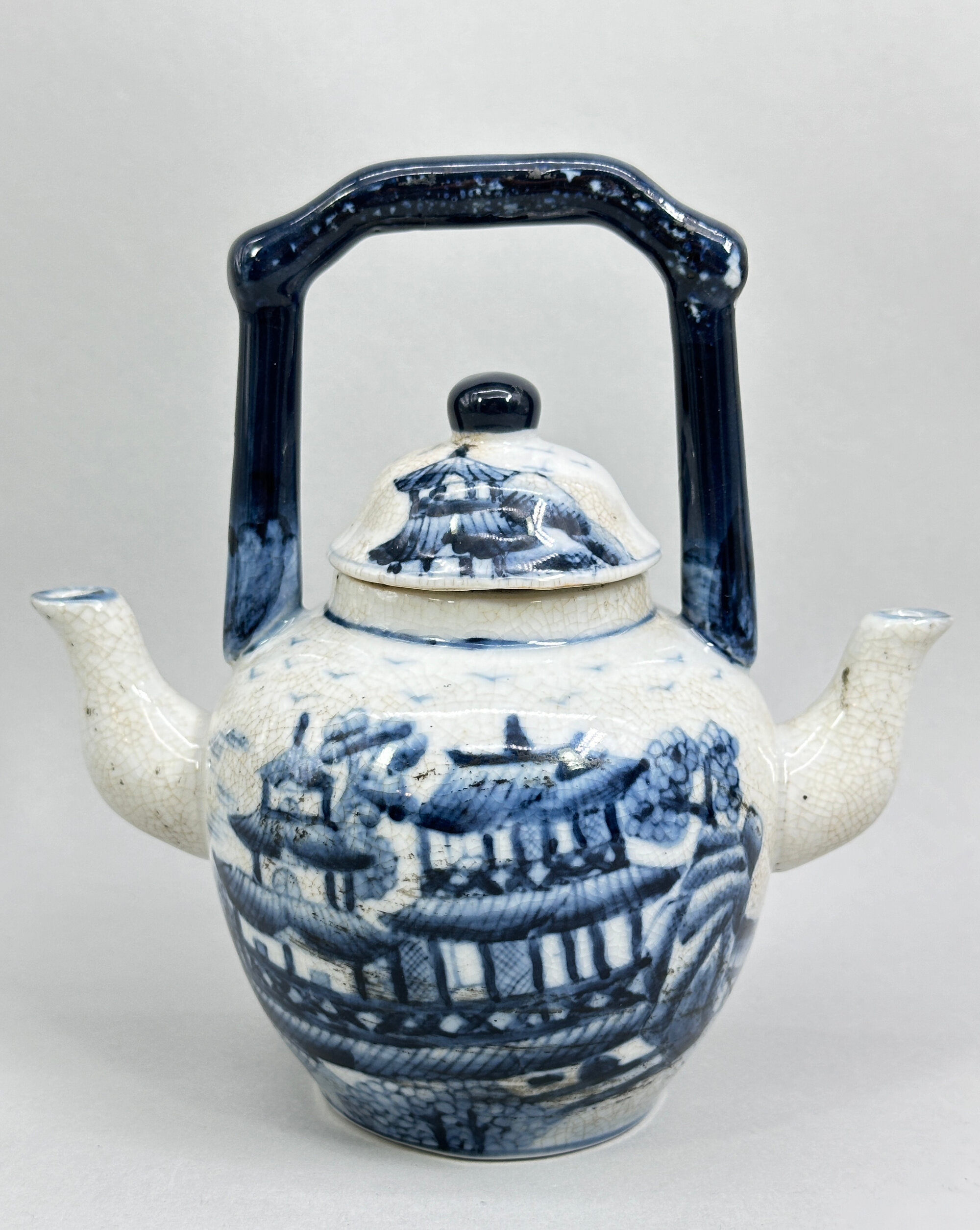
Chinese provincial double spout Teapot, early C20th
Price: £55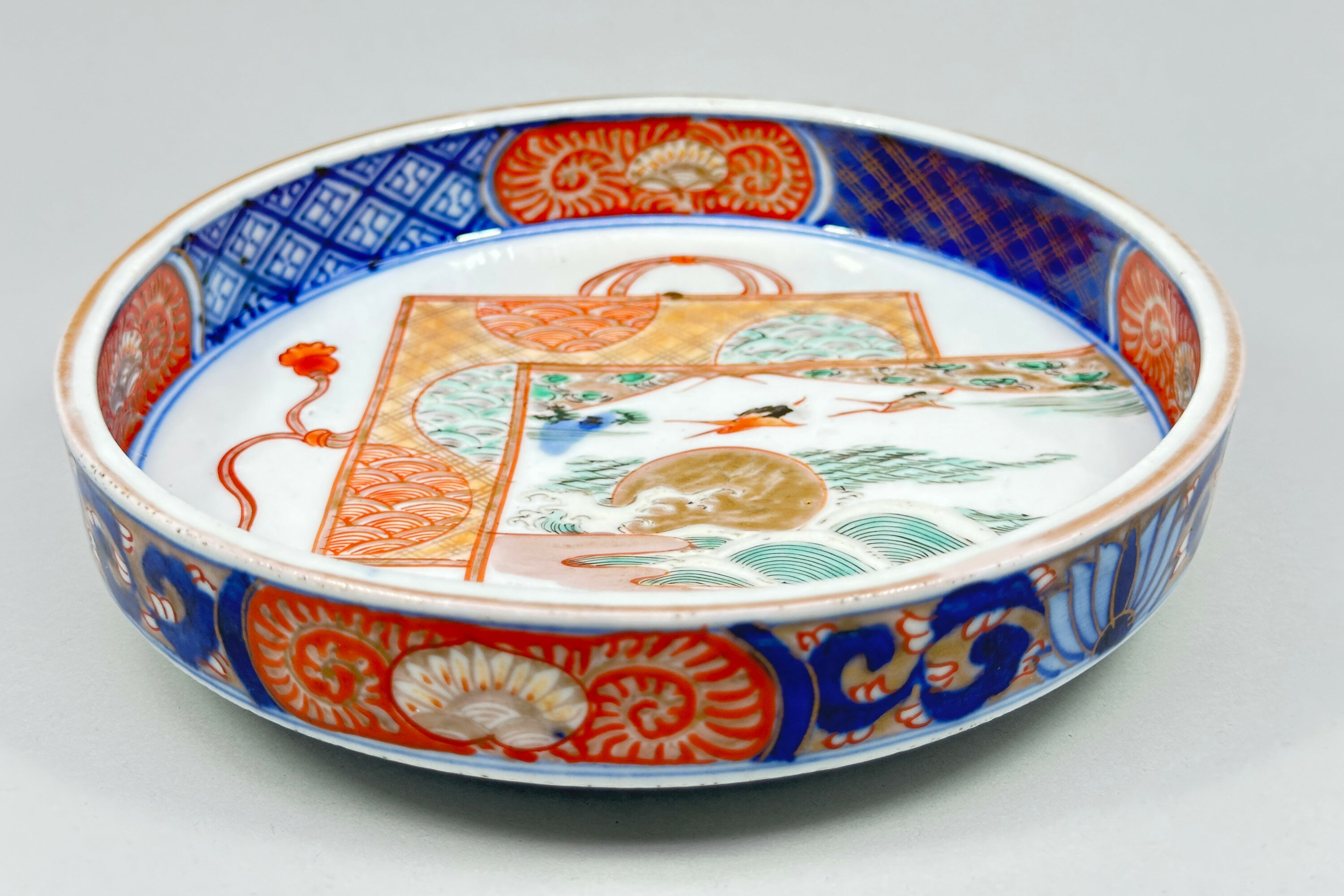
Japanese Arita shallow Bowl circa 1880
Price: £55The town of Arita in the former Hizen Province, northwestern Kyūshū island, was a major centre for the production of porcelains in Japan. Best known for blue and white pieces it also produced polychrome wares as well, including the familiar Imari colourings. While similar to Imari, the wider palette of colours used here is usually termed ‘Arita’ and this bowl employs not only the colourings but also many of the decorative elements found in these wares. The angular form, though, is unusual. Dating is to the Meiji era (1868-1912) probably around 1880.
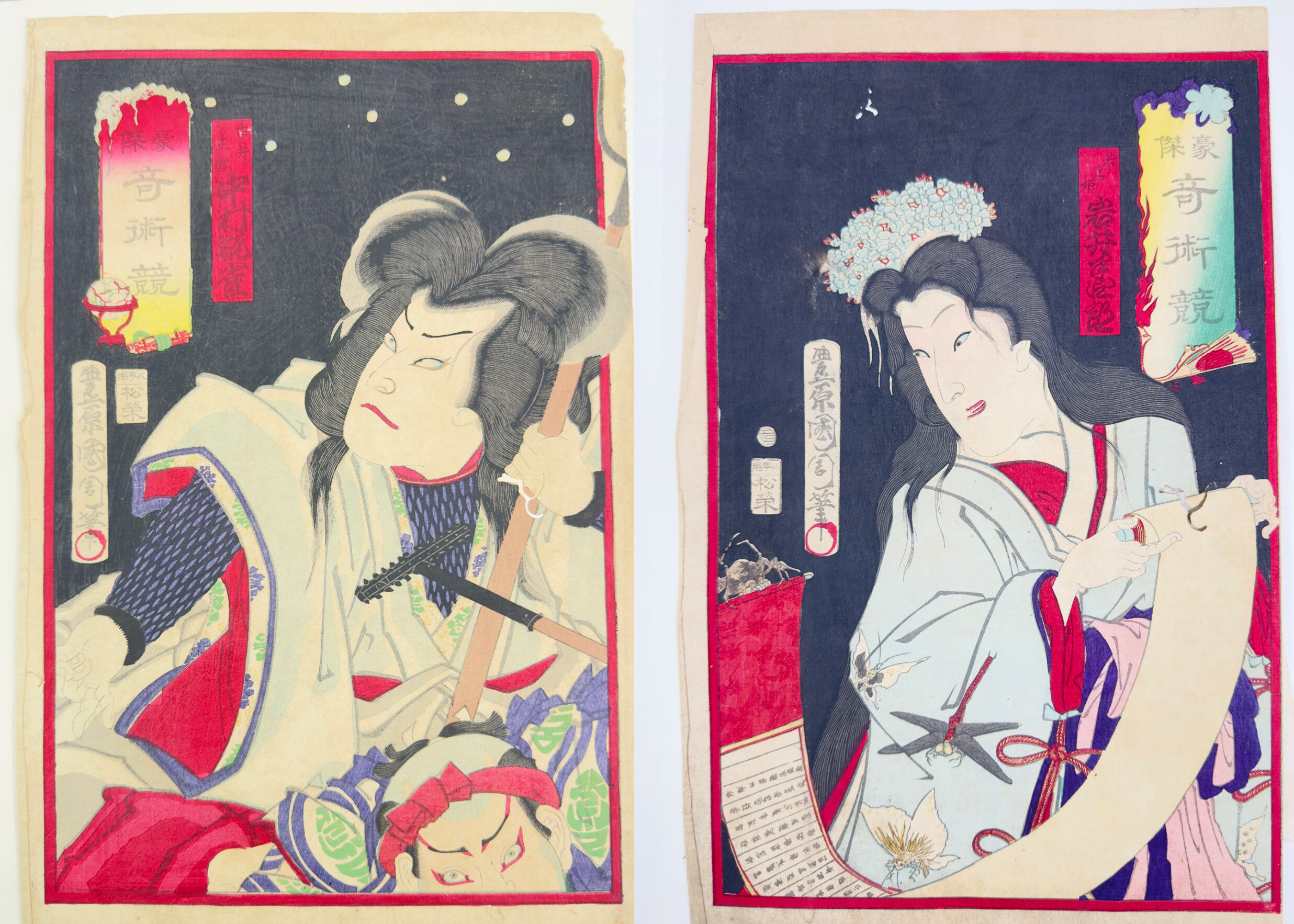
Two Japanese Woodblock Prints by Toyohara Kunichika, second half C19th
Price: £75Toyohara Kunichika achieved great fame and distinction a Japanese print artist. Born in 1835 he studied under Toyohara Chikanobu and then Utagawa Kunisada (also known as Utagawa Toyokuni III) eventually using a combination of both his teacher’s names to create his own professional one. At first he worked within Kunisada’s studio and when his teacher died in 1865 was asked to design two memorial portraits of him. The beginning of the Meiji era (1868-1912) saw Kunichika issuing his own prints, often in themed series and he became known in particular for his portrayals of kabuki actors, indeed he regarded the theatre as almost his second home. A contemporary once wrote ‘"Print designing, theatre and drinking were his life and for him that was enough.’ He achieved great fame and was rated as one of the masters of woodblock printing. Contemporary observers noted Kunichika's skilful use of colour in his actor prints, but he was also criticized for some of his choices for unlike most artists of the period, he made use of strong reds and dark purples rather than the softer colours used previously, exploiting the recent import of new dyes from Germany. Red, for the Japanese, meant progress and enlightenment so there was probably hidden meaning here. Eventually Kunichika’s lifestyle took its toll and he died in poor health, aged 65. It had been a Japanese custom for people of high cultural standing to write a poem before death. Kunichika's own, inscribed on his grave, reads ‘Since I am tired of painting portraits of people of this world, I will paint portraits of the King of hell and the devils.’ For many years his prints fell out of favour but interest has now revived and Kunichika is regarded as one of the eminently collectible Japanese artists in the field and these two prints are an excellent example of his work.
Each print is accompanied by a printed text on fine paper which presumably describes the character represented. The second of them is accompanied by two sheets one of which has become attached in one small place to the print itself but could probably fairly easily be detached by a restorer. In general there are some typical signs of age with minor losses (illustrated), tears and folding but the colours remain bright and fresh.
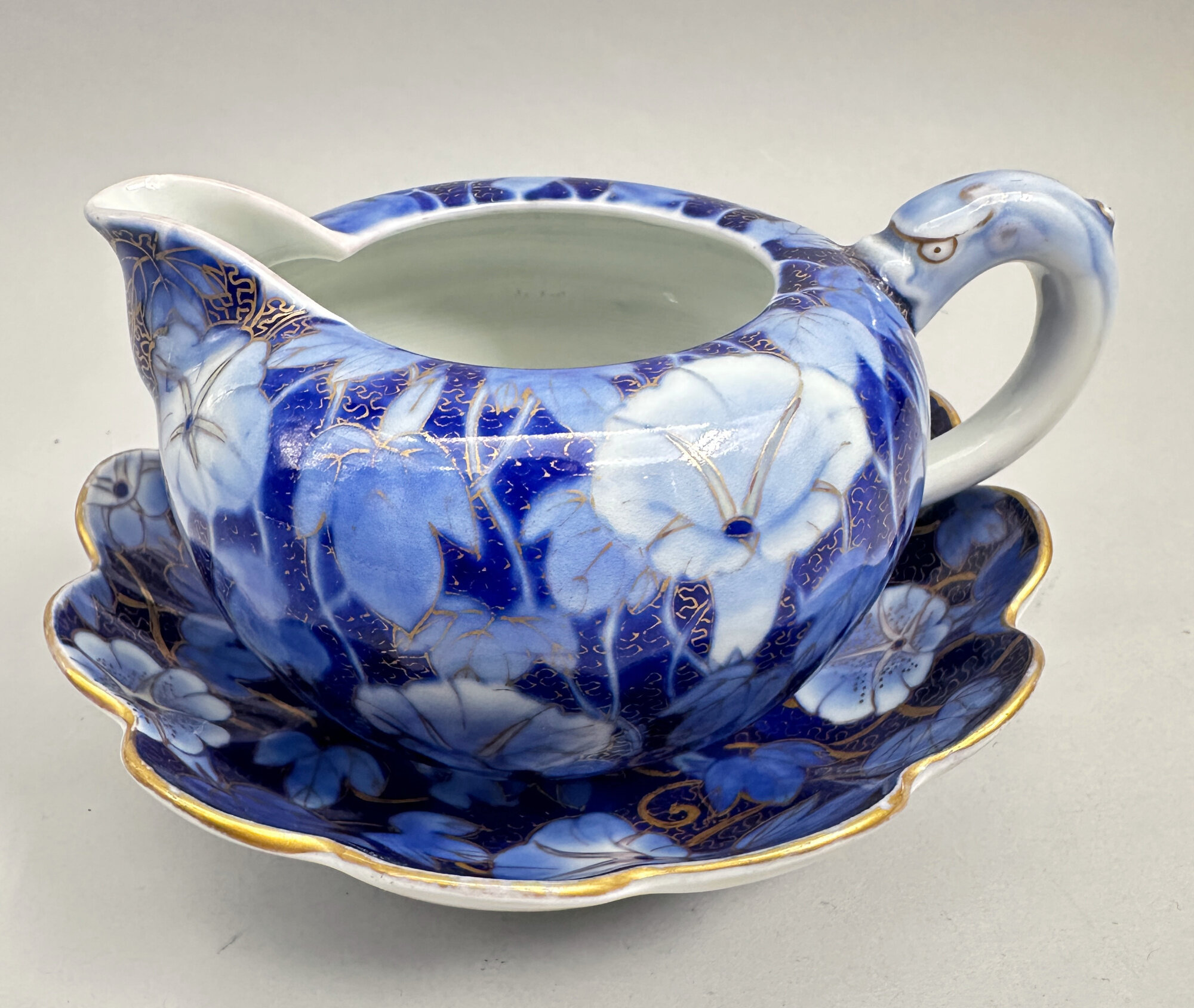
Japanese Fukagawa Jug and Stand decorated lotus, signed, circa 1900
Price: £45The Fukagawa kilns produced the best quality Imari items made in Japan in the late nineteenth century for export to the West. Their history starts with Ezaiemon Fukagawa who in 1856 became head of his family's porcelain business and in 1875 founded Koransha (The Company of the Scented Orchid) in Arita, Japan, to produce tableware for export. In 1894 the modern Fukagawa company was founded by Chuji Fukagawa, with the Fukagawa trade mark of Mount Fuji and a stream, as its trade mark. Dating of these pieces is therefore towards the end of the Meiji period (1868 - 1912) probably around 1900. While the decoration is similar to that found on other Fukagawa pieces there are few, if any parallels, and tea ware pieces by the firm are not very often seen.
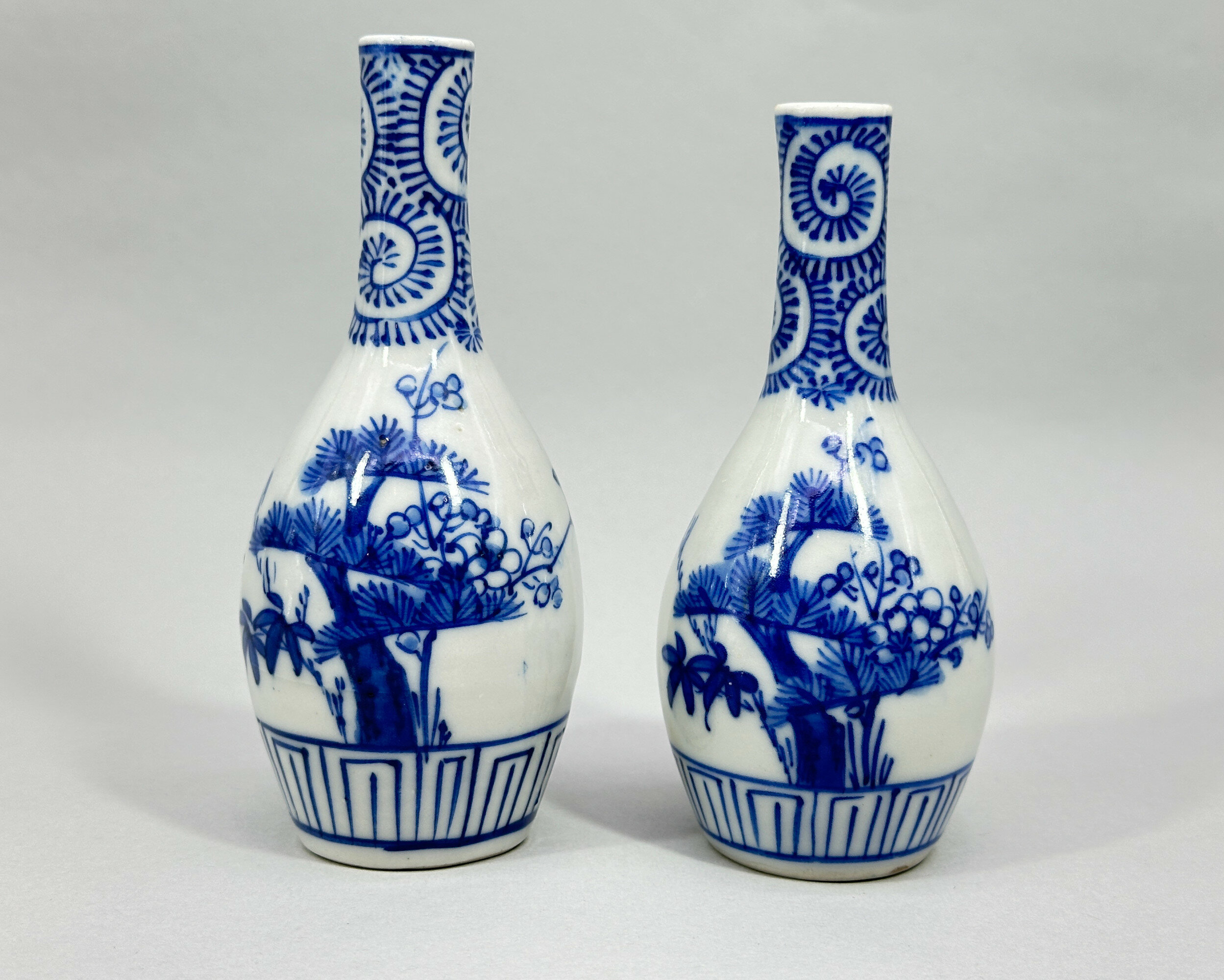
Pair of small Japanese Arita Blue and White Bottle Vases, circa 1880
Price: £55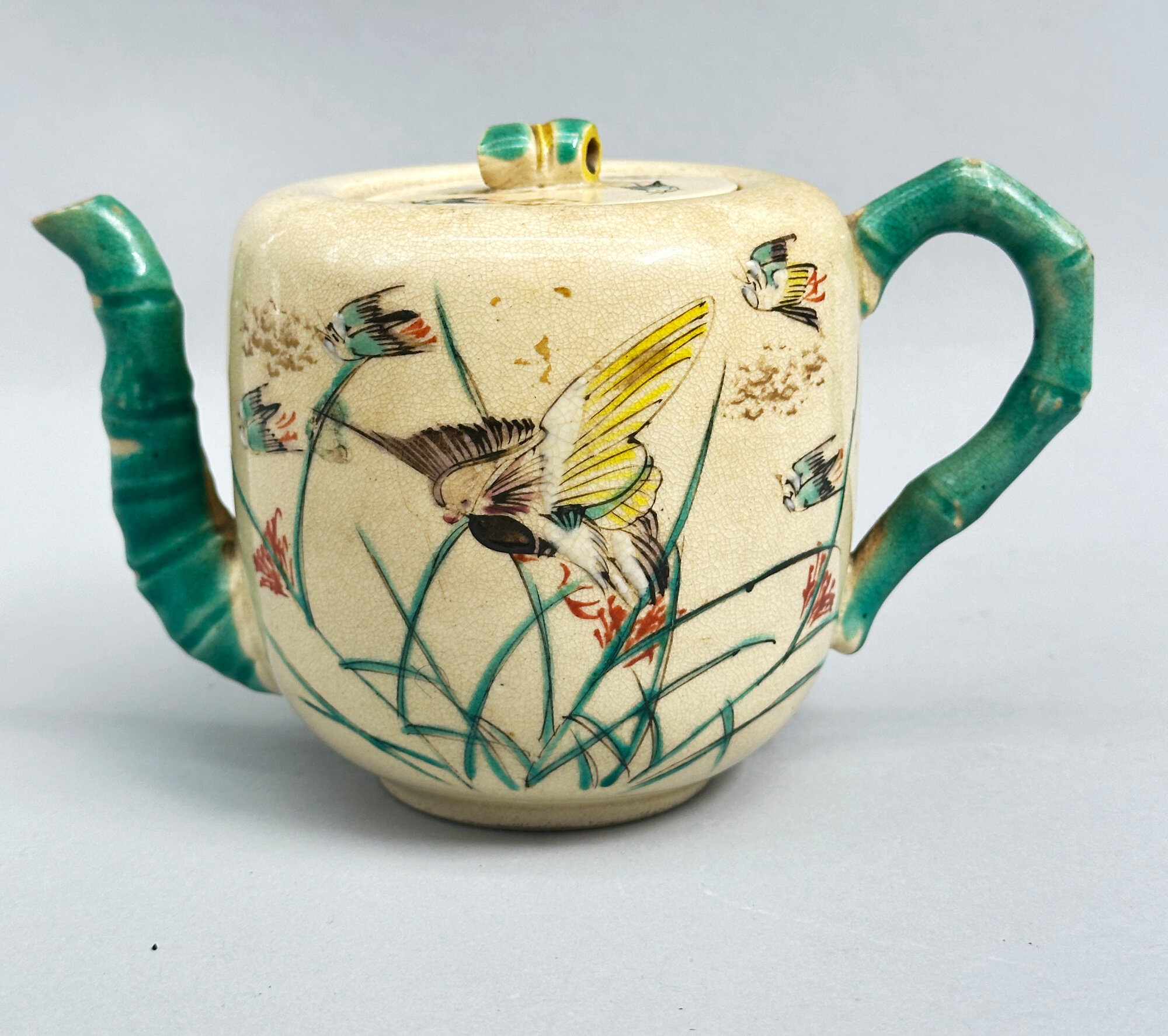
Japanese Awata ware Teapot and Cover, signed, circa 1900
Price: £25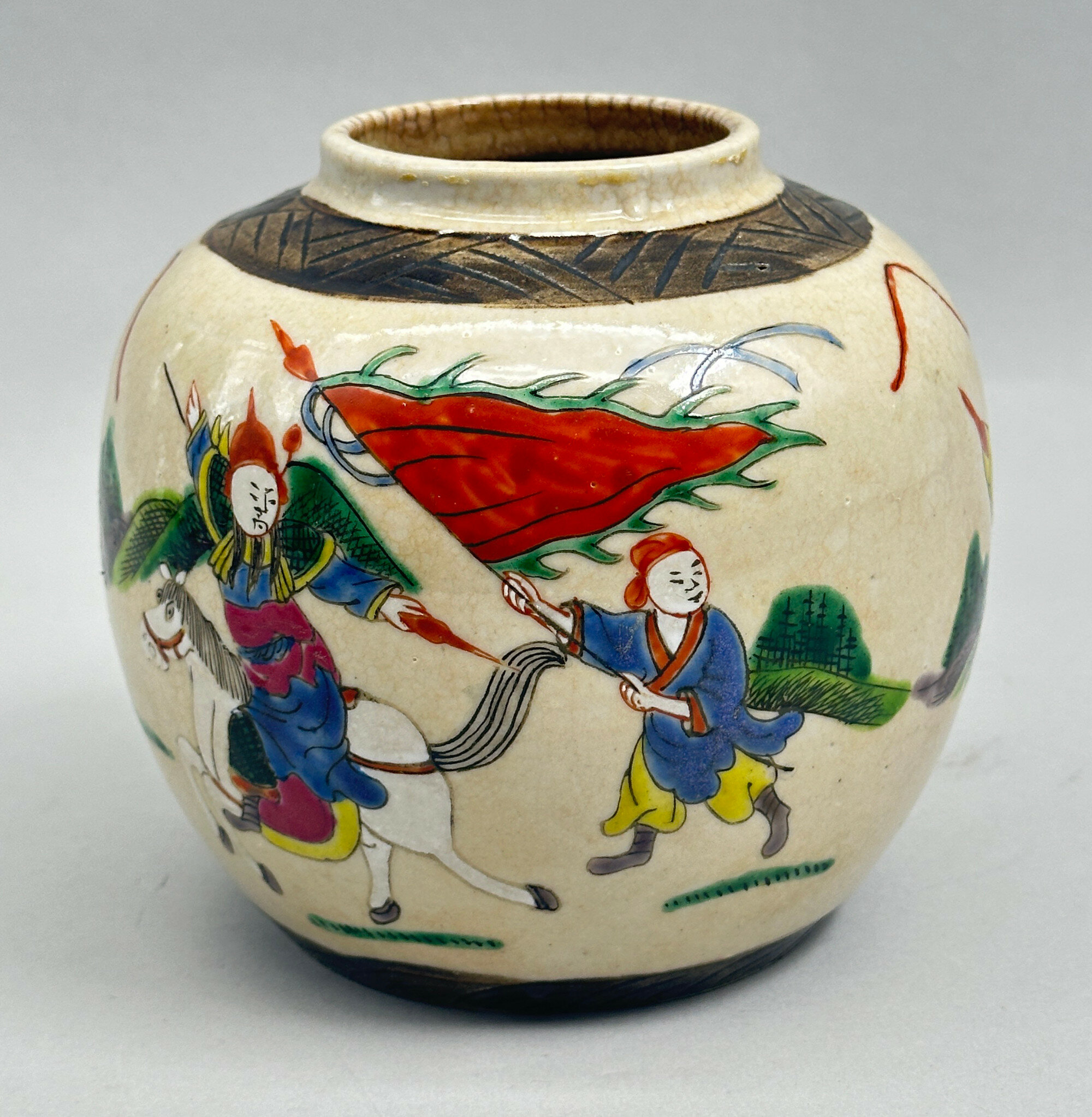
Chinese Crackleware Ginger Jar decorated with Warriors circa 1900
Price: £25'Crackleware' glazed pieces, usually with 'bronzed’ bands, were a staple output of the Chinese potteries from the mid nineteenth century onwards and were produced in a wide variety of mainly vase shape forms, both in polychrome and blue and white and intended as decorative pieces for the Victorian rooms of the West. As with other ceramic types, the quality deteriorated and this piece is typical of the late productions with a more modest level of craftsmanship but still retaining a naif charm. As with many ginger jars, this one lacks its original domed cover which would have been decorated to match.
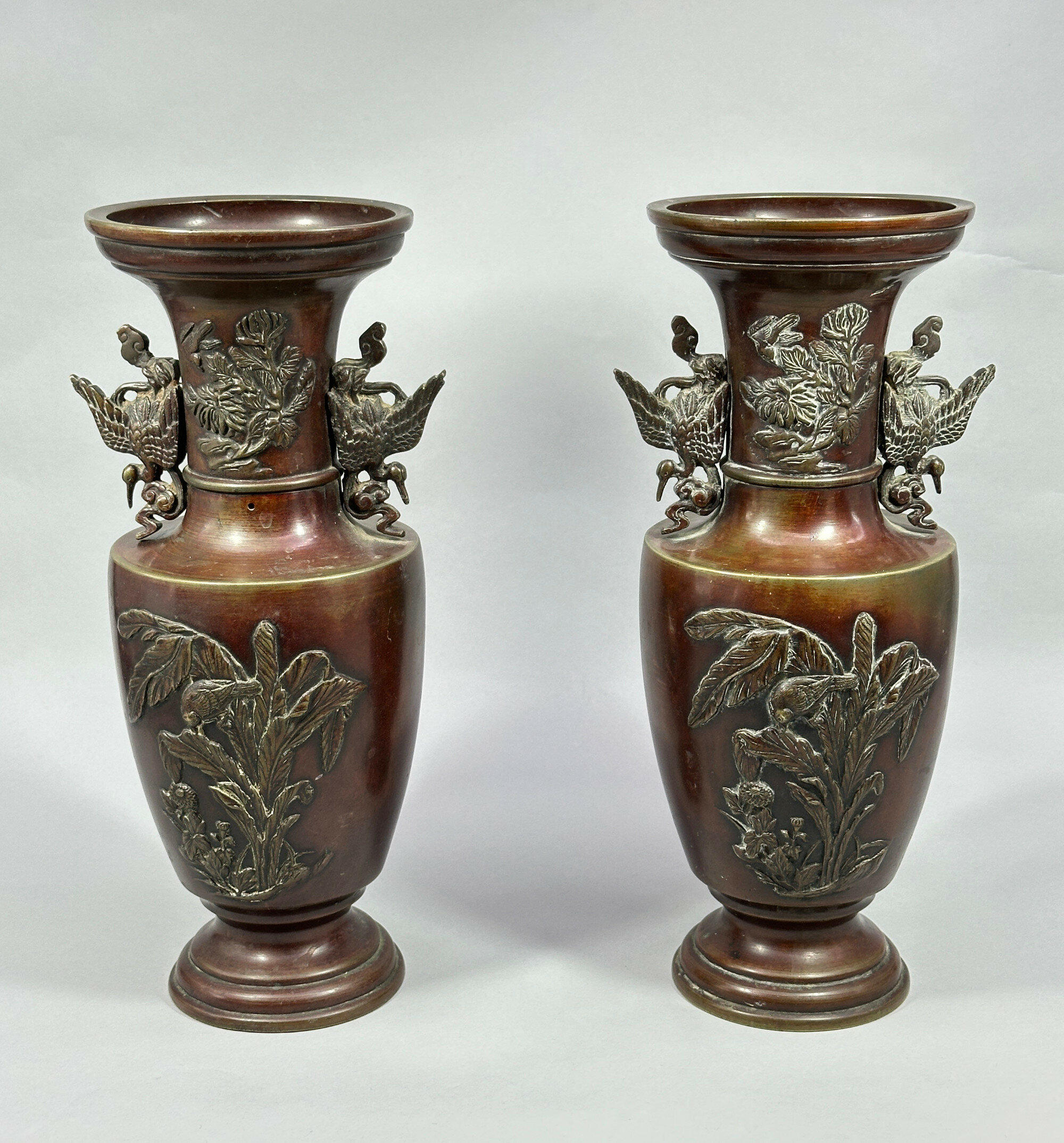
Pair of fine quality Japanese Bronze Vases decorated birds, circa 1880
Price: £220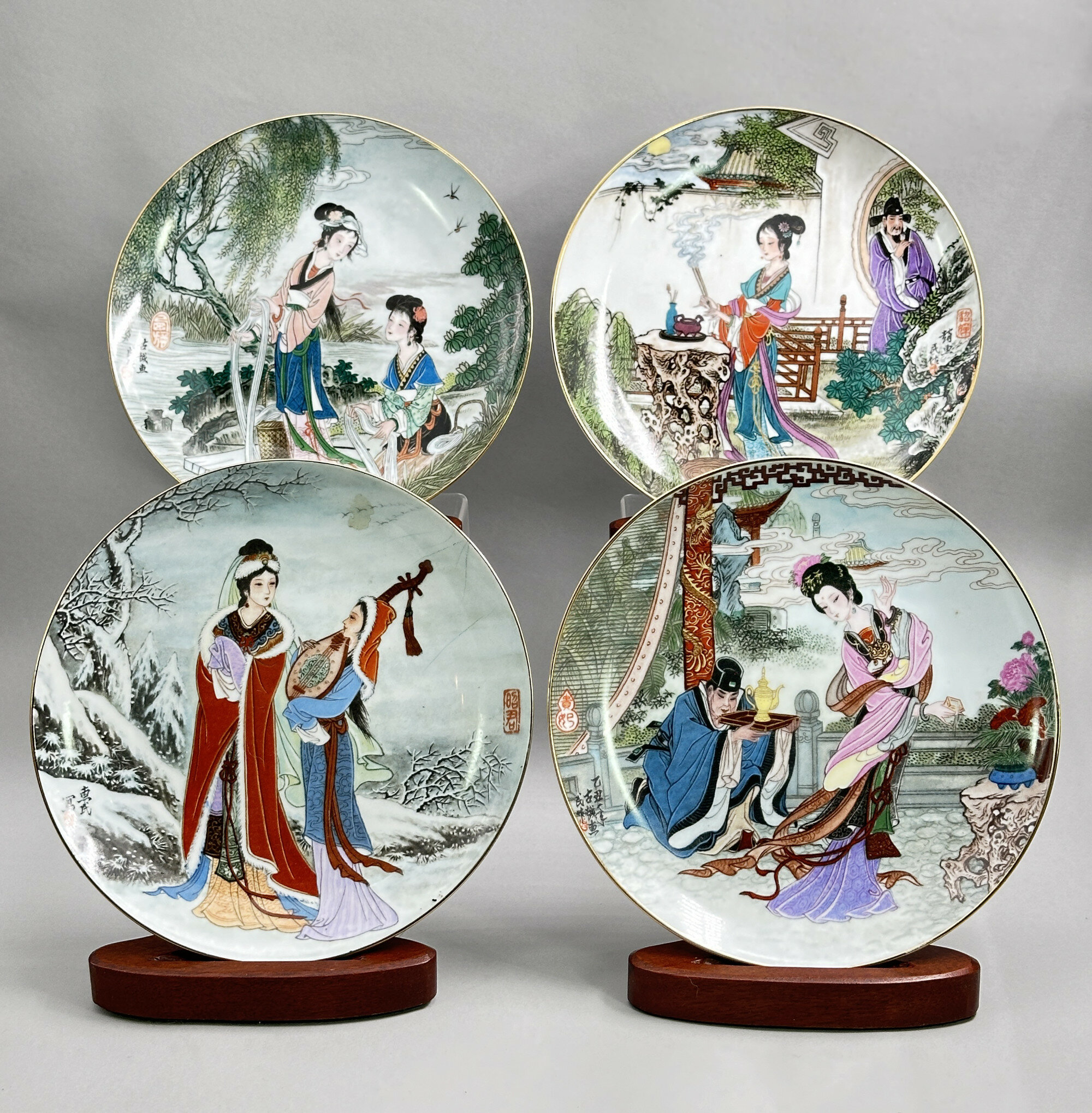
Set of Japanese Plates decorated with Geisha in landscape scenes, late C20th
Price: £40Please note that the stands are for display purposes only.
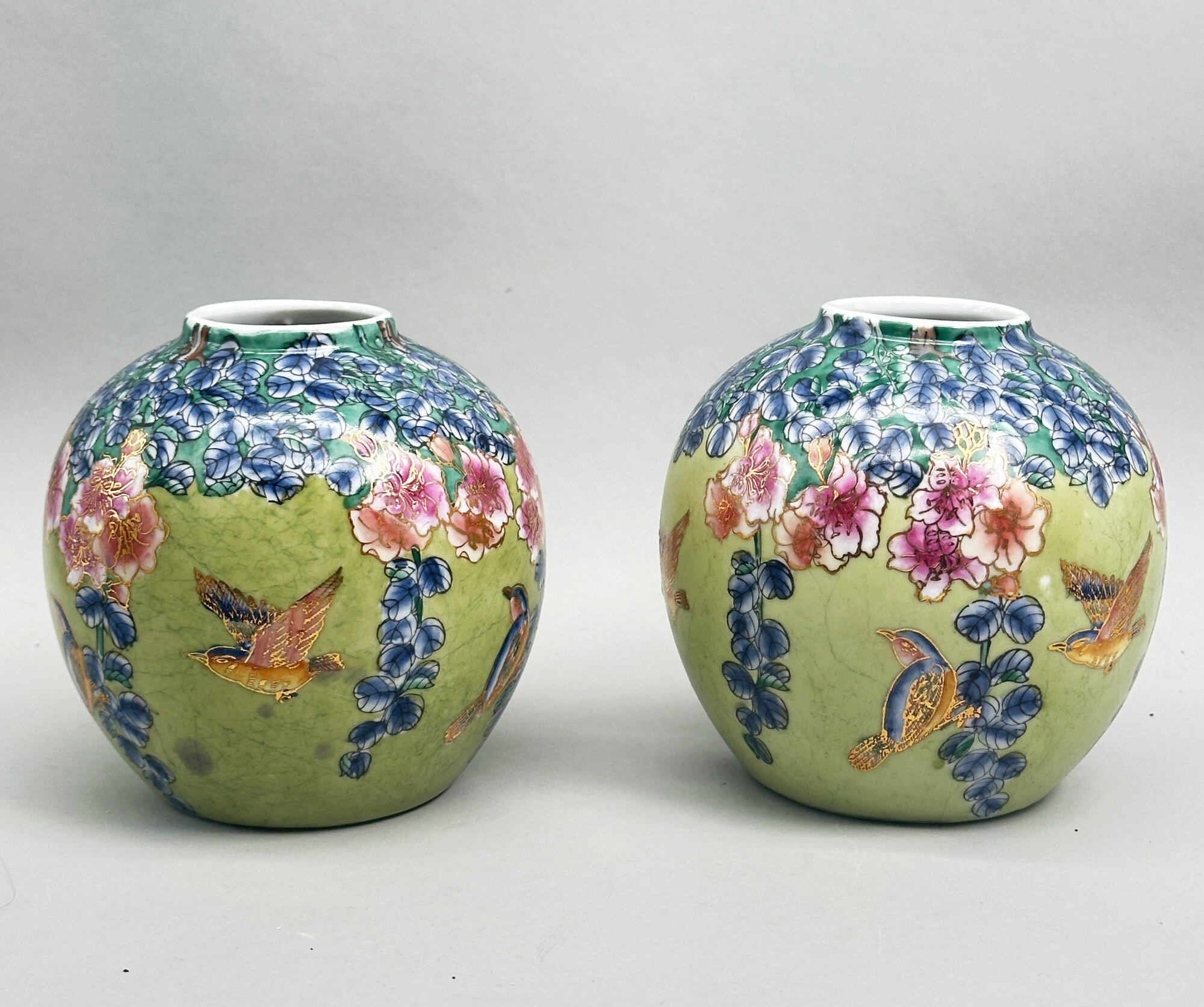
Pair of Chinese Ginger Jars decorated Birds and Flowers, late C20th
Price: £45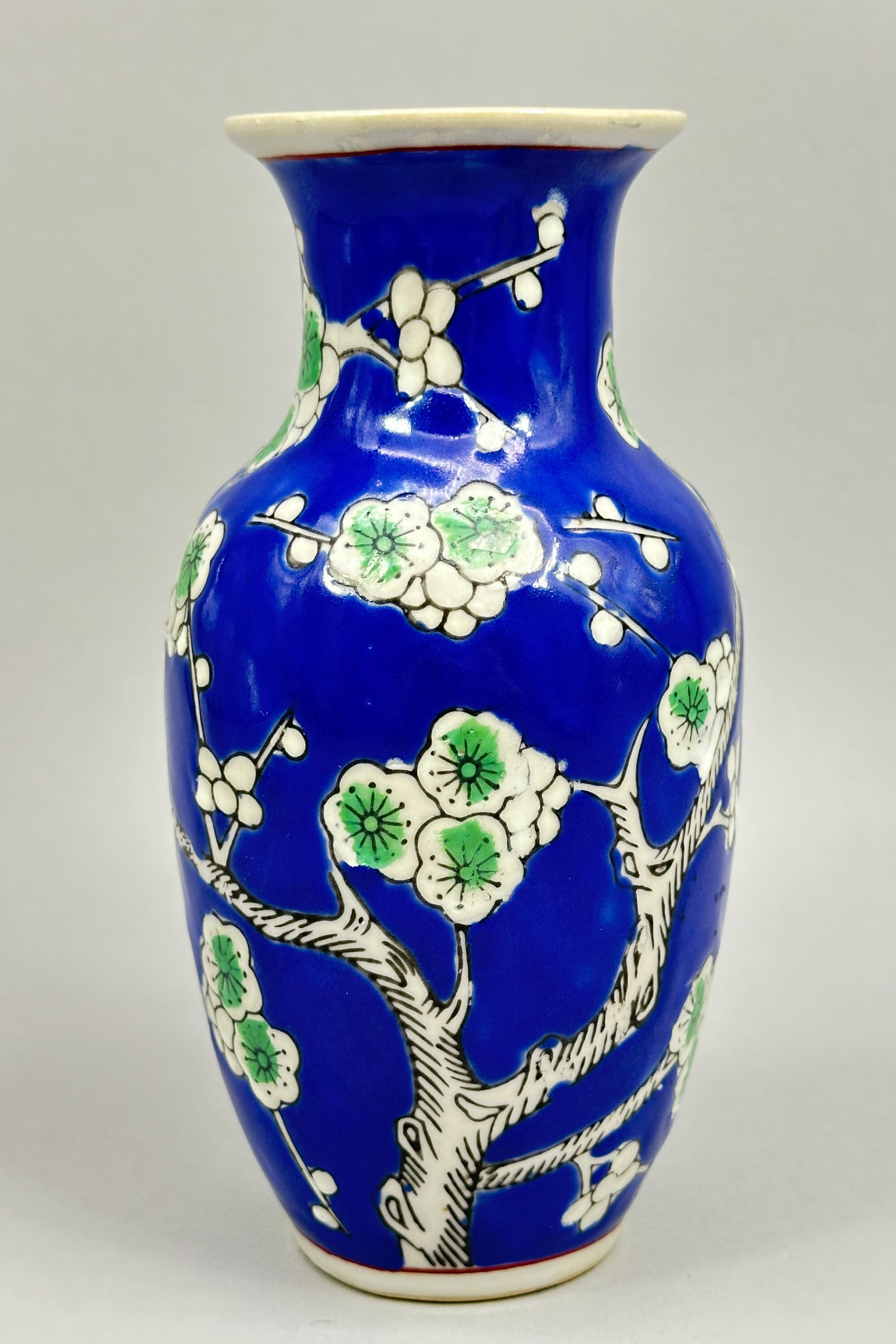
Chinese blue ground Vase decorated Prunus, late C20th
Price: £25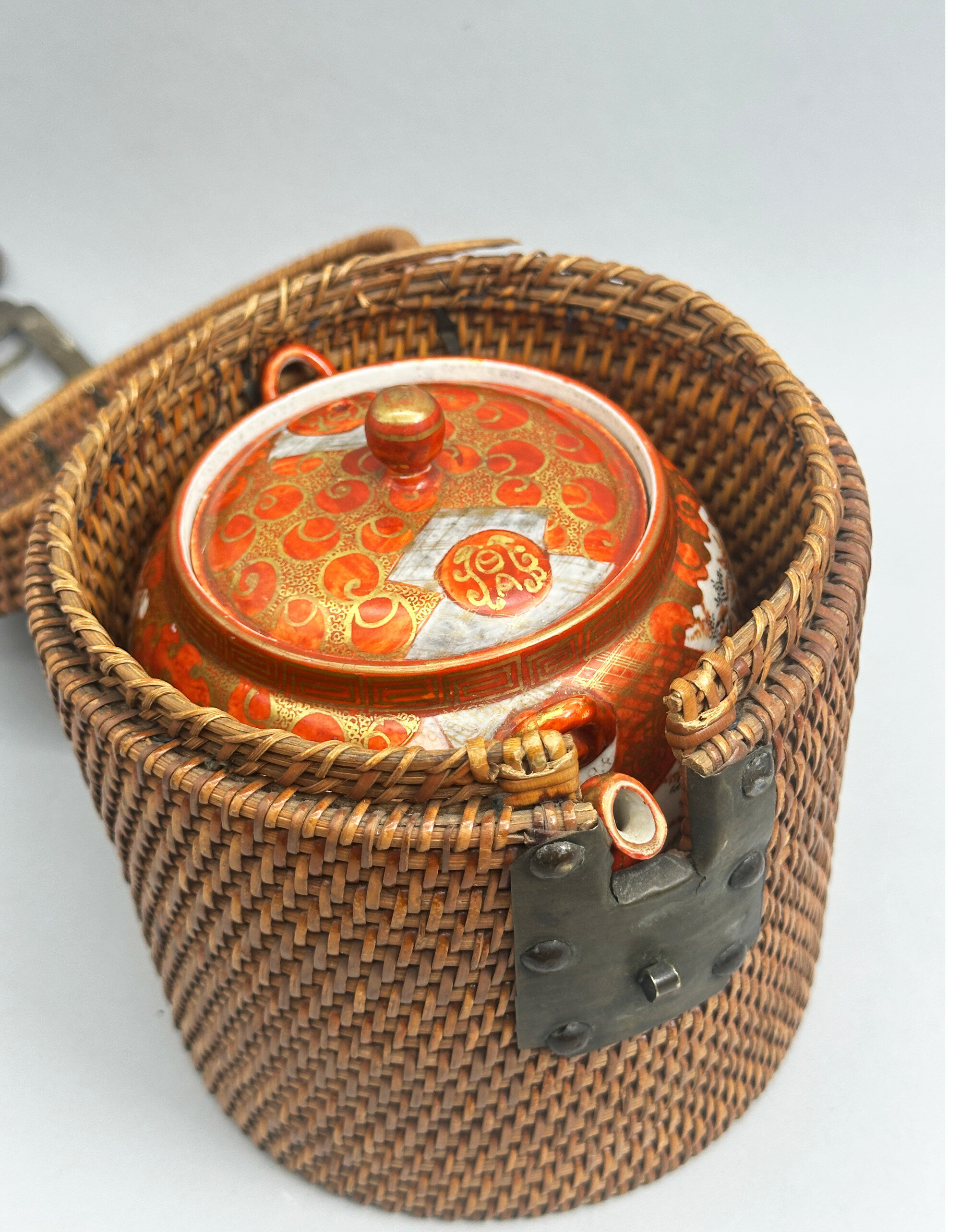
Japanese Kutani Teapot in a carrying Basket, circa 1900
Price: £45Kutani (the word means 'nine valleys') porcelain was made at various factories in the former Kaga province of Japan. The earliest pieces were in a completely different style employing a palette of colours emphasising green, the so called 'Ko Kutani'. Production of this ceased around 1730, and manufacturing was not revived until the early nineteenth century when the more familiar colourings of iron red and gold were introduced. Vases, bowls and plaques are found in this style but also teapots of which this is a typical example. The decoration is of birds and flowers on a faintly craquelure glaze ground and the lid has a complementary ‘brocade pattern’ design. The base has a two character mark reading ‘ku’ ‘tani’ as is often found. The basket is of tightly woven wicker with the metal fitments as described and is probably Chinese in common with many similar examples, although the Japanese did, of course, have a basket weaving tradition of their own. Slight damage means that the ensemble has to be of decorative value rather than practical use but it remains an interesting and entertaining souvenir item from the orient.
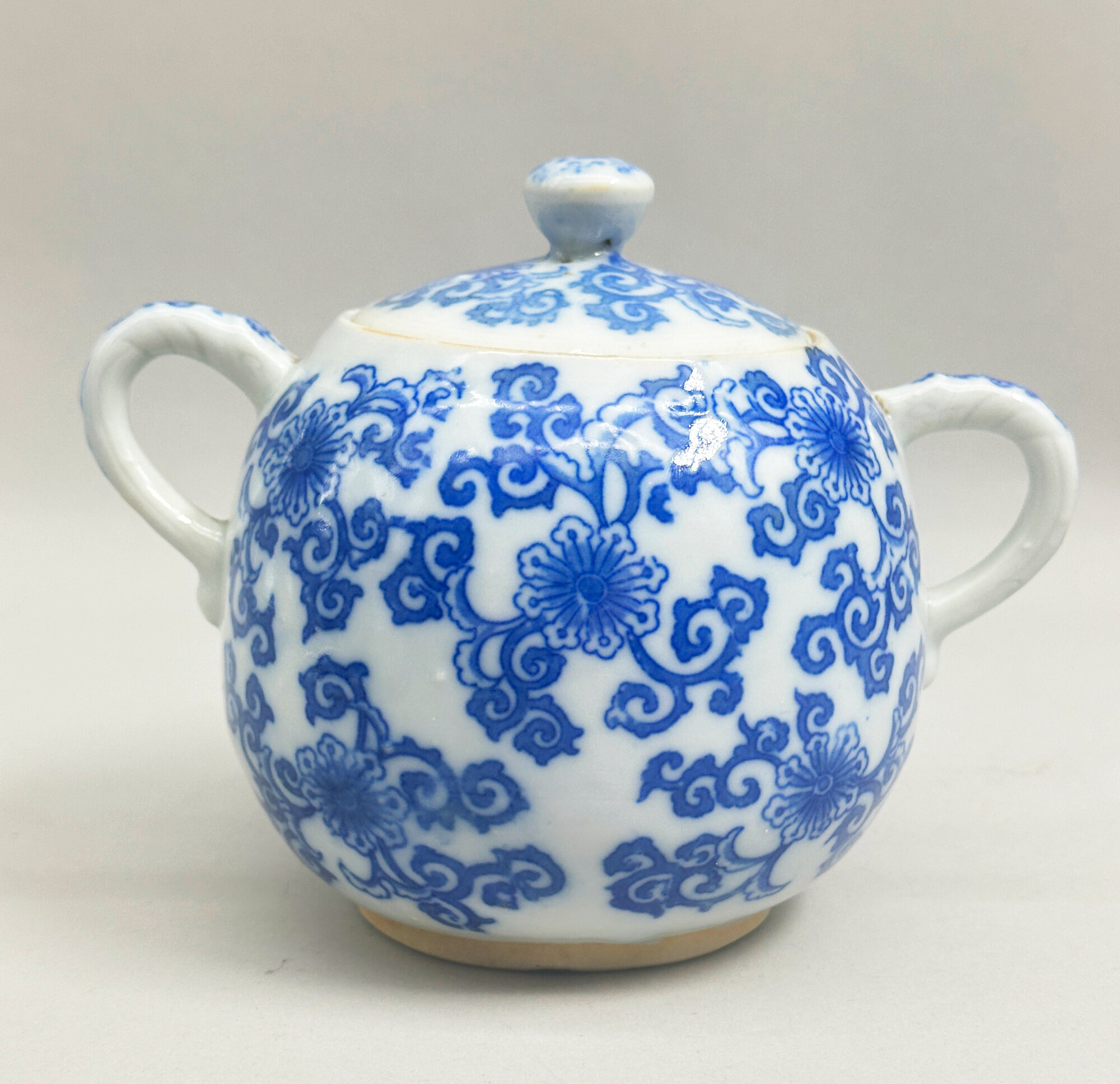
Japanese Blue and White Sugar Bowl and Cover, first half C20th
Price: £25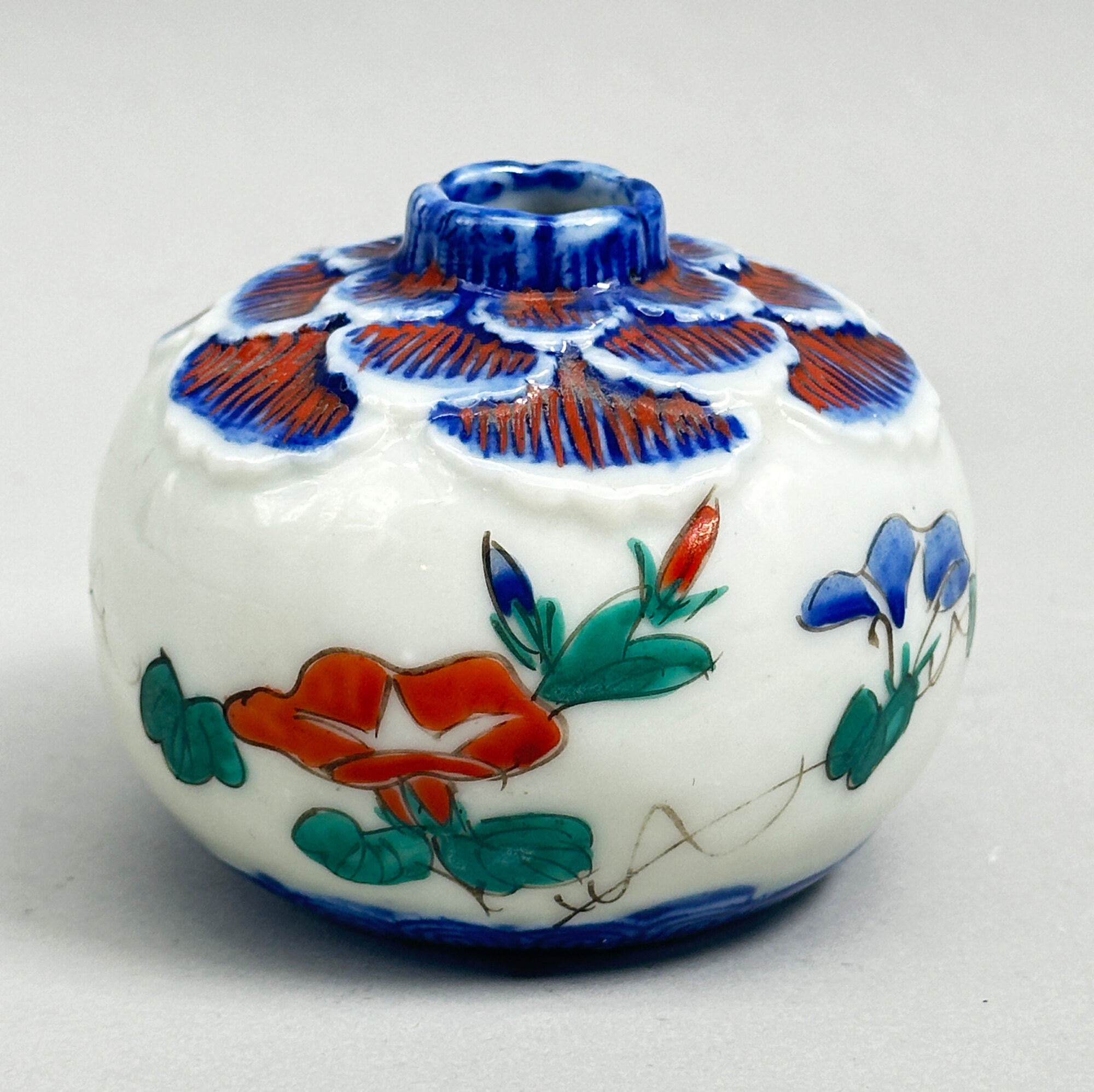
Chinese lotus form Water dropper, C20th
Price: £25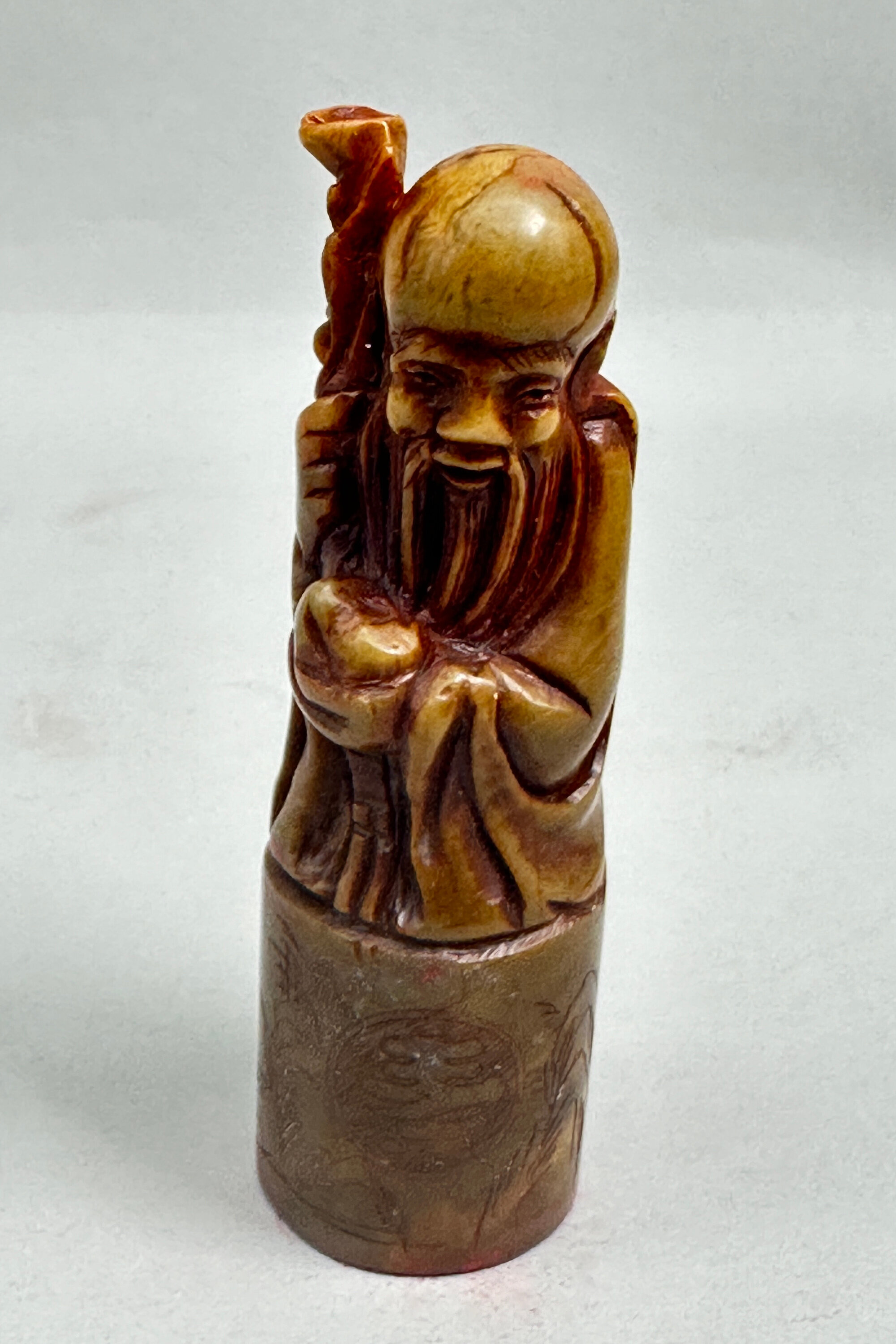
Chinese Soapstone Seal with Shou Lao, C20th
Price: £45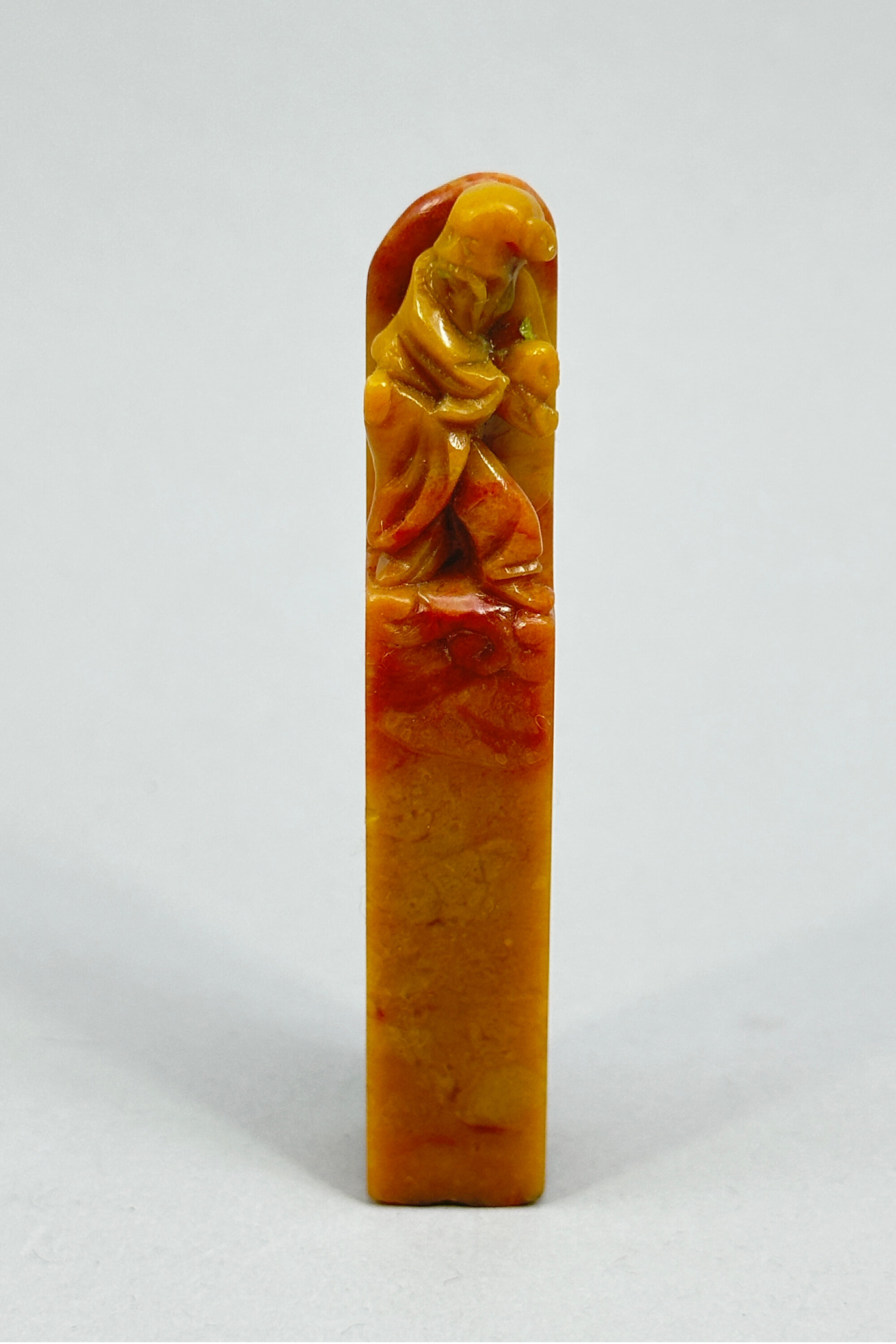
Chinese Shoushan Soapstone Seal with the characters A.H., C20th
Price: £45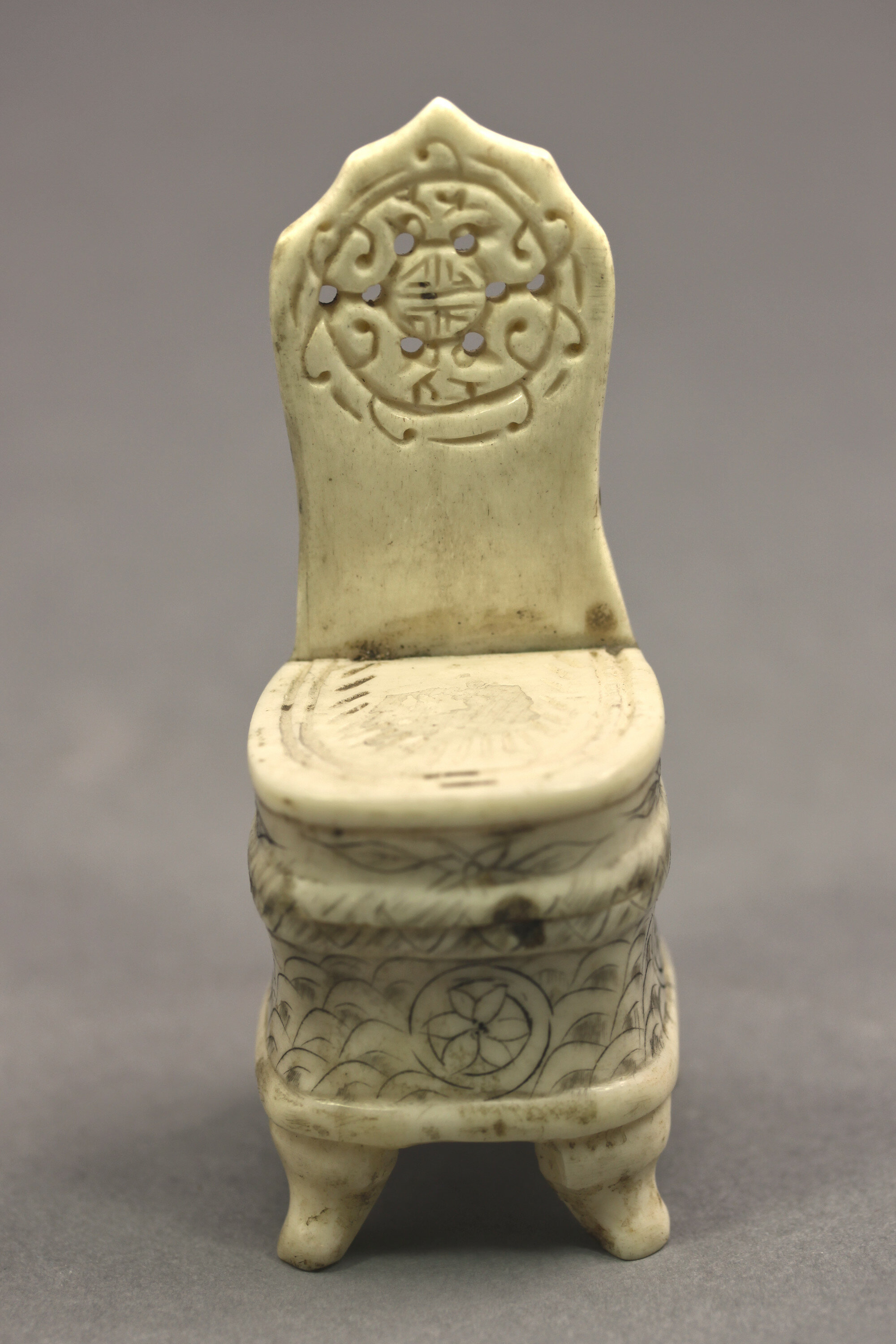
Chinese Bone Inkwell in the form of a Chair, early 20th century
Price: £25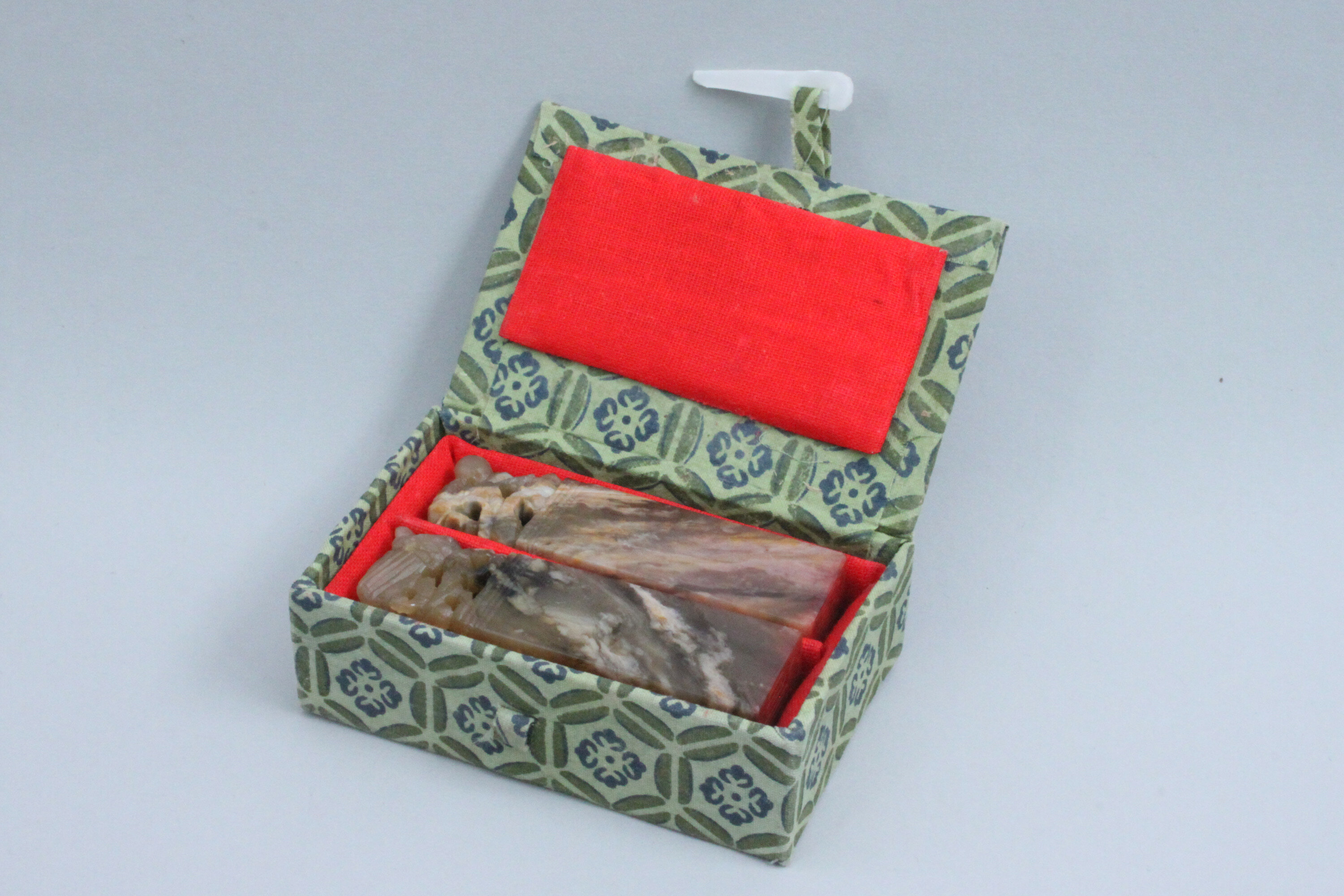
Pair of Chinese Soapstone Seals in a fitted box, C20th
Price: £45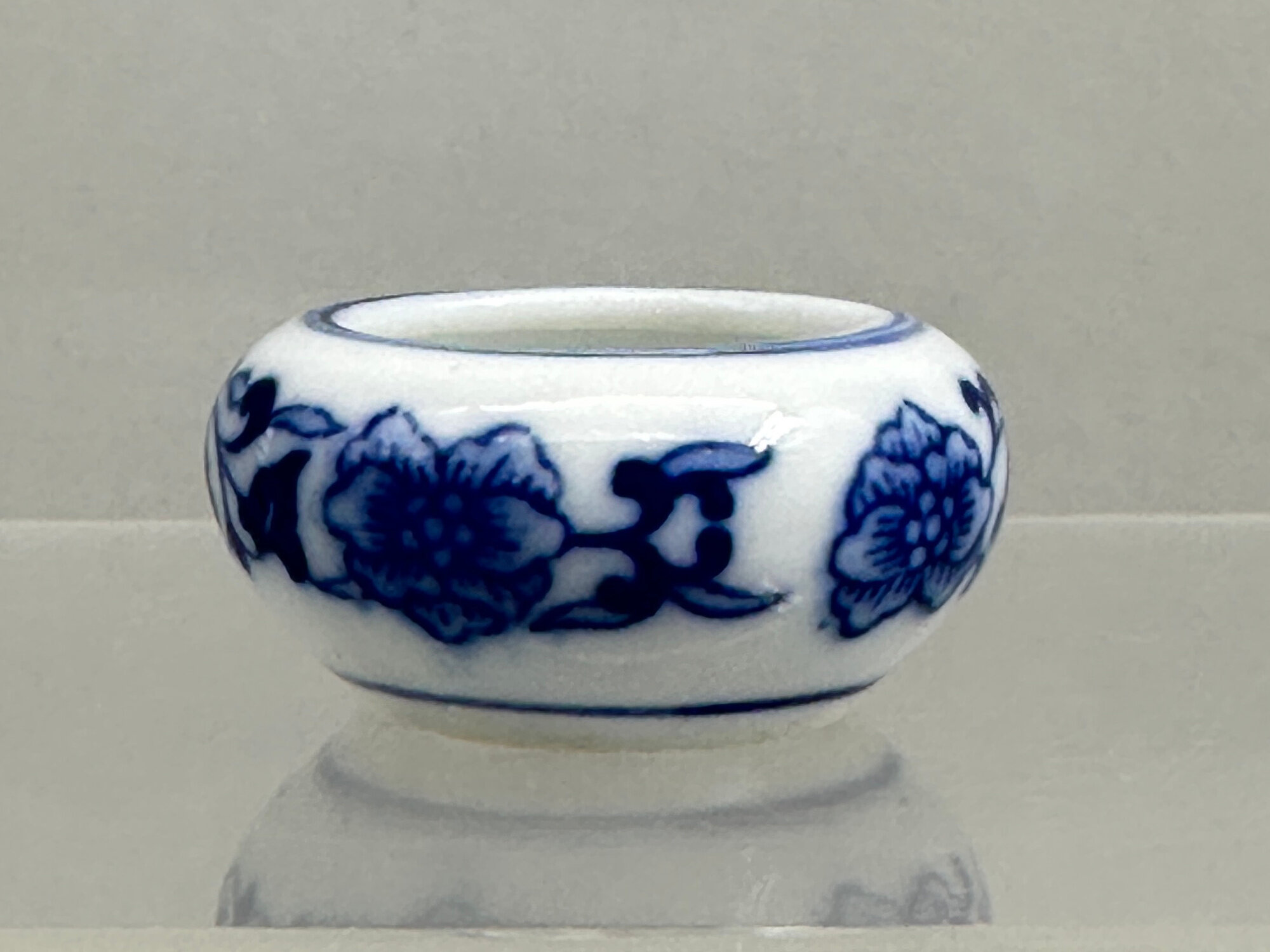
Small Chinese Blue and White Brushwasher, C20th
Price: £25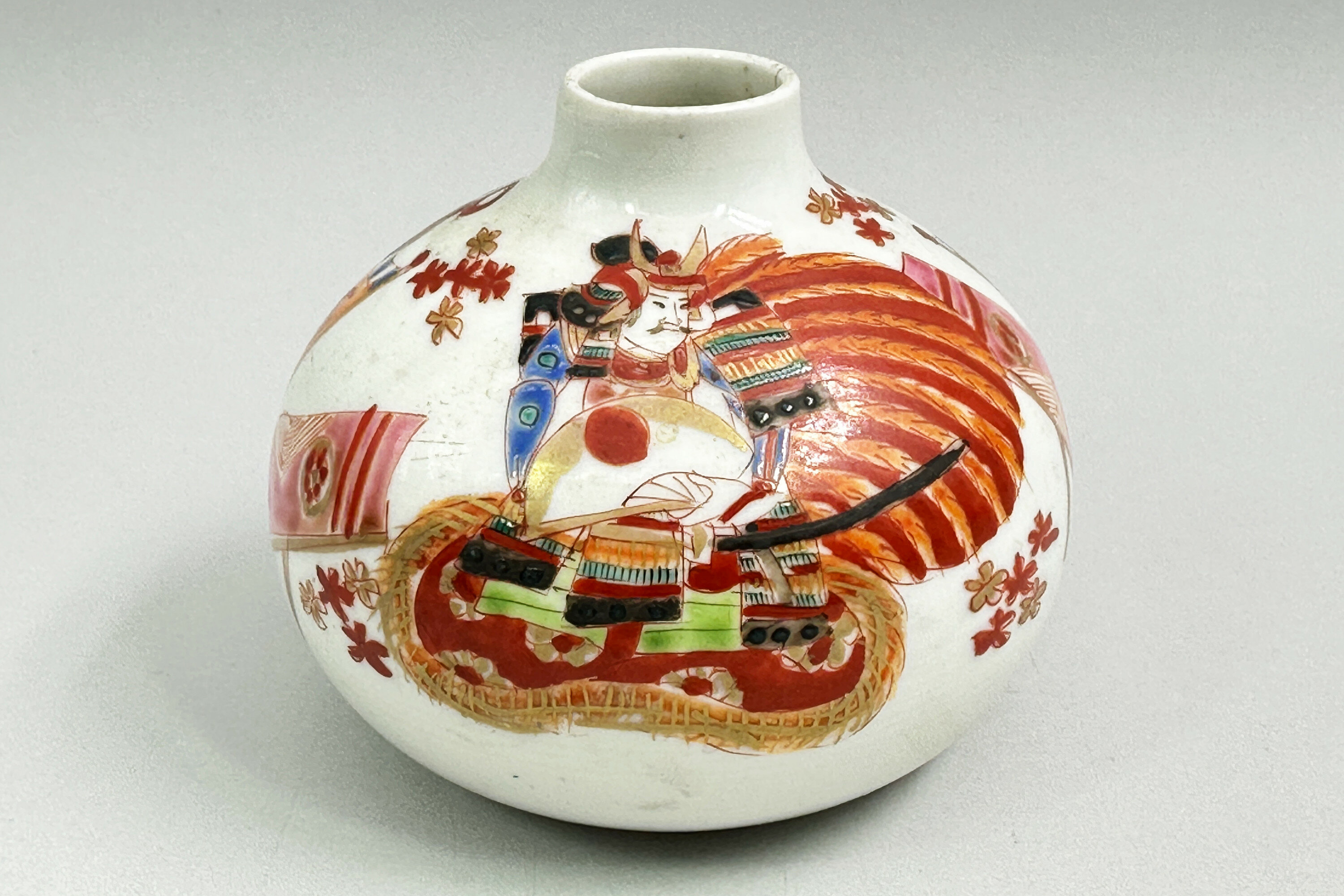
A Japanese Hichozan Shinpo Brushwasher circa 1880
Price: £25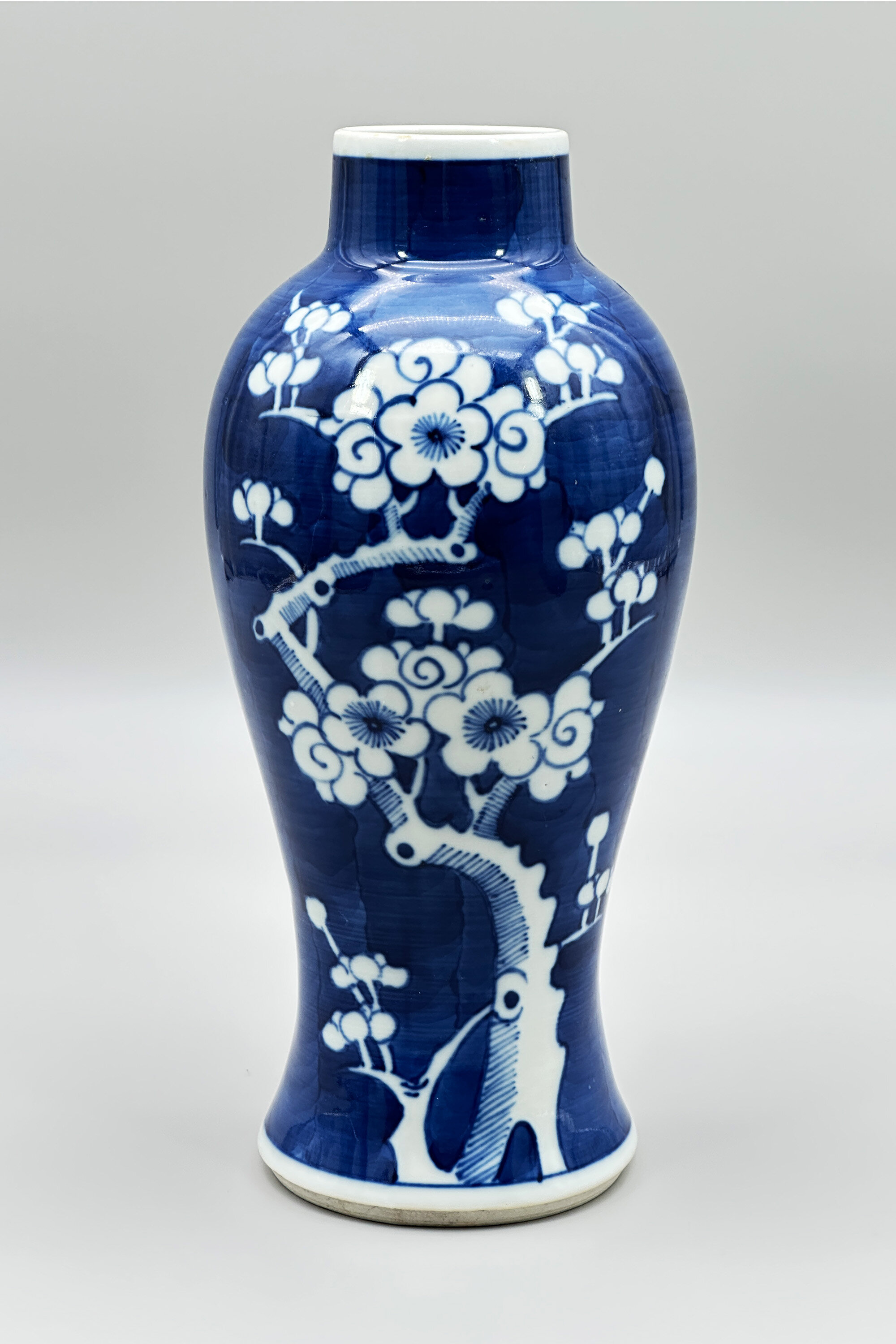
Chinese Blue and White Vase decorated with flowering Prunus circa 1900
Price: £55Flowering prunus or plum blossom is one of the most iconic of the decorative designs used by Chinese potters and first appears in the Kangxi period (1662-1722). Kangxi ginger jars in the pattern were highly prized by Victorian collectors with one example, the legendary ‘Huth’ jar, fetching 5900 guineas, a little over £6000, at auction in 1905, a price equivalent to over a quarter pf a million pounds today. The tree symbolises perseverance and renewal and was usually shown against a pattern of ‘cracked ice, representing the end of Winter and the beginning of Spring. Branches of plum blossom convey the ‘Five Blessings’ : longevity, wealth, health, love of virtue and a peaceful death. The number five was an auspicious number for the Chinese and is reflected in the five petal form of the prunus flower.
Once evolved, the design was continuously repeated by Chinese potters and is even produced today. Many of late nineteenth century pieces display a rather more slapdash interpretation of the pattern as here where the ‘cracked ice’ of the eighteenth century pieces is replaced by the repeated brush strokes of a blue wash ground and the painting of the tree itself is sketchy. The style of decoration and the paste of the foot indicate a circa date to around 1900, but this modest interpretation of centuries old pattern still possesses a charm of its own.
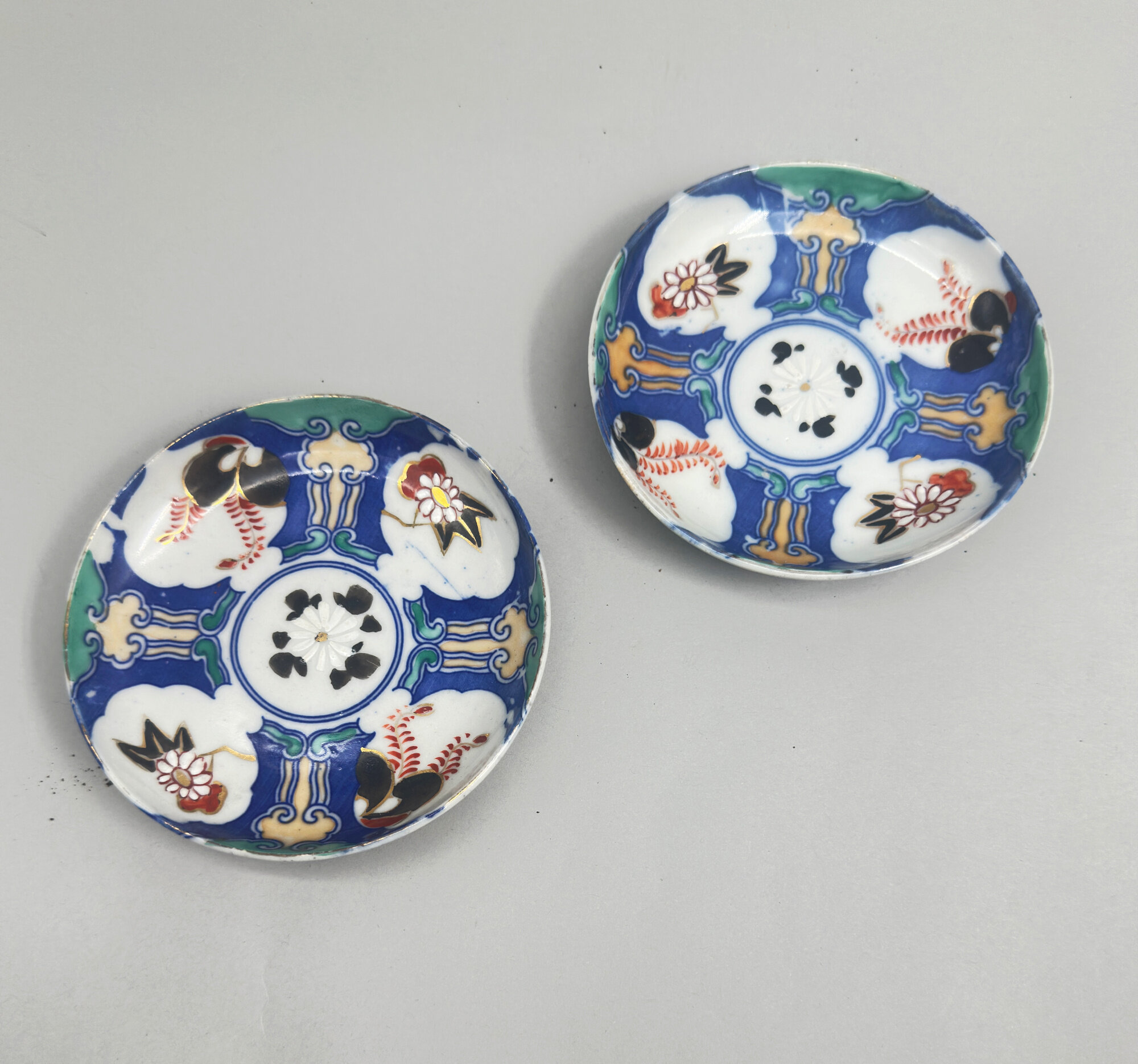
Pair of Japanese Arita small Dishes circa 1880
Price: £40The town of Arita in the former Hizen Province, northwestern Kyūshū island, was a major centre for the production of porcelains in Japan. Best known for blue and white pieces it also produced polychrome wares as well, including the familiar imari colourings. While similar to Imari, the wider palette of colours used here is usually termed ‘Arita’ and the decorative appeal of the style is clear. These bowls probably come from an original set of five and with slightly coarser decoration than usual were probably made for the domestic market. The paste of the foot implies a dating to the Meiji era (1868 - 1912) probably around 1880.
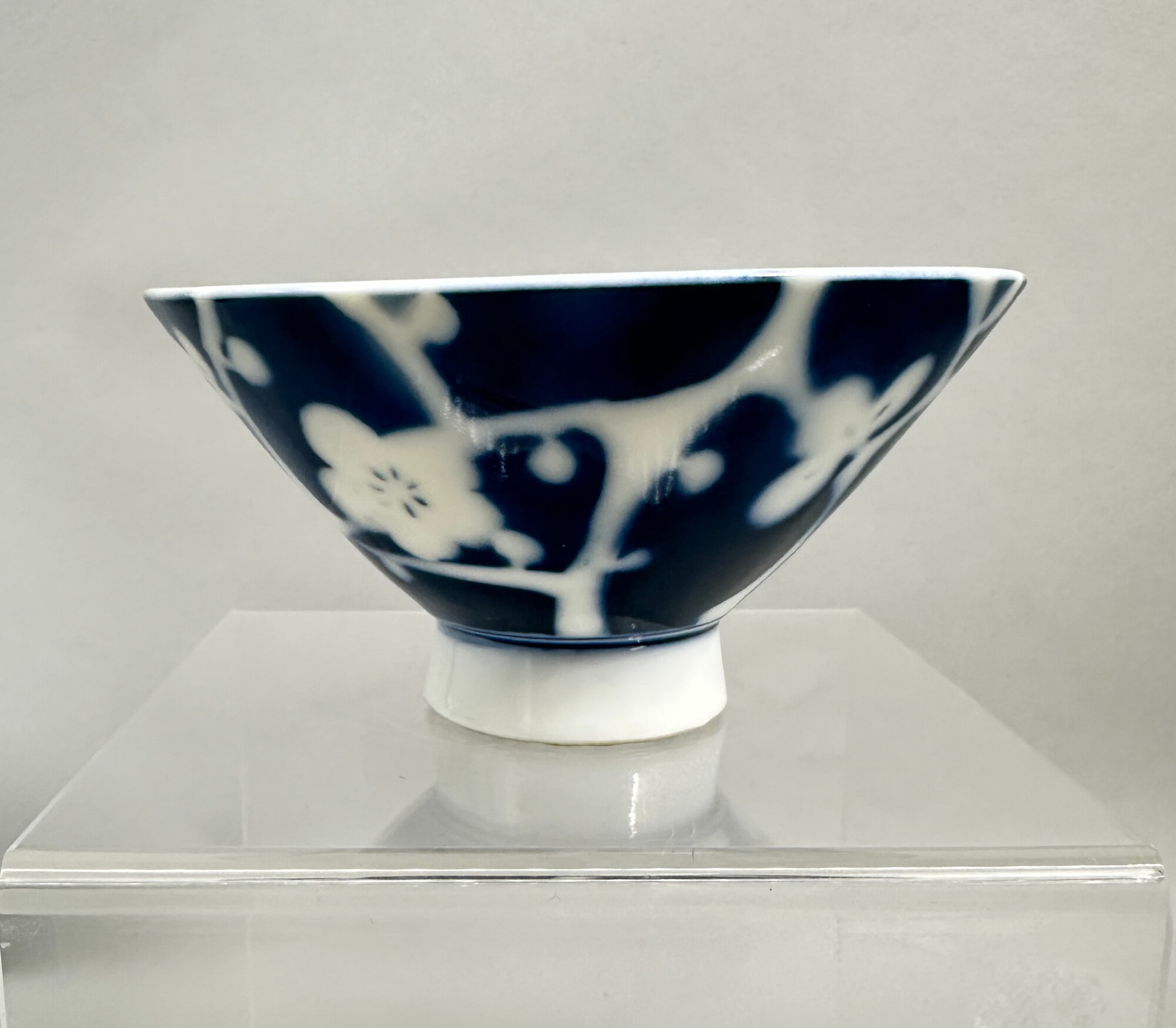
Japanese blue and white hat shape small Bowl with flowering prunus, C20th
Price: £25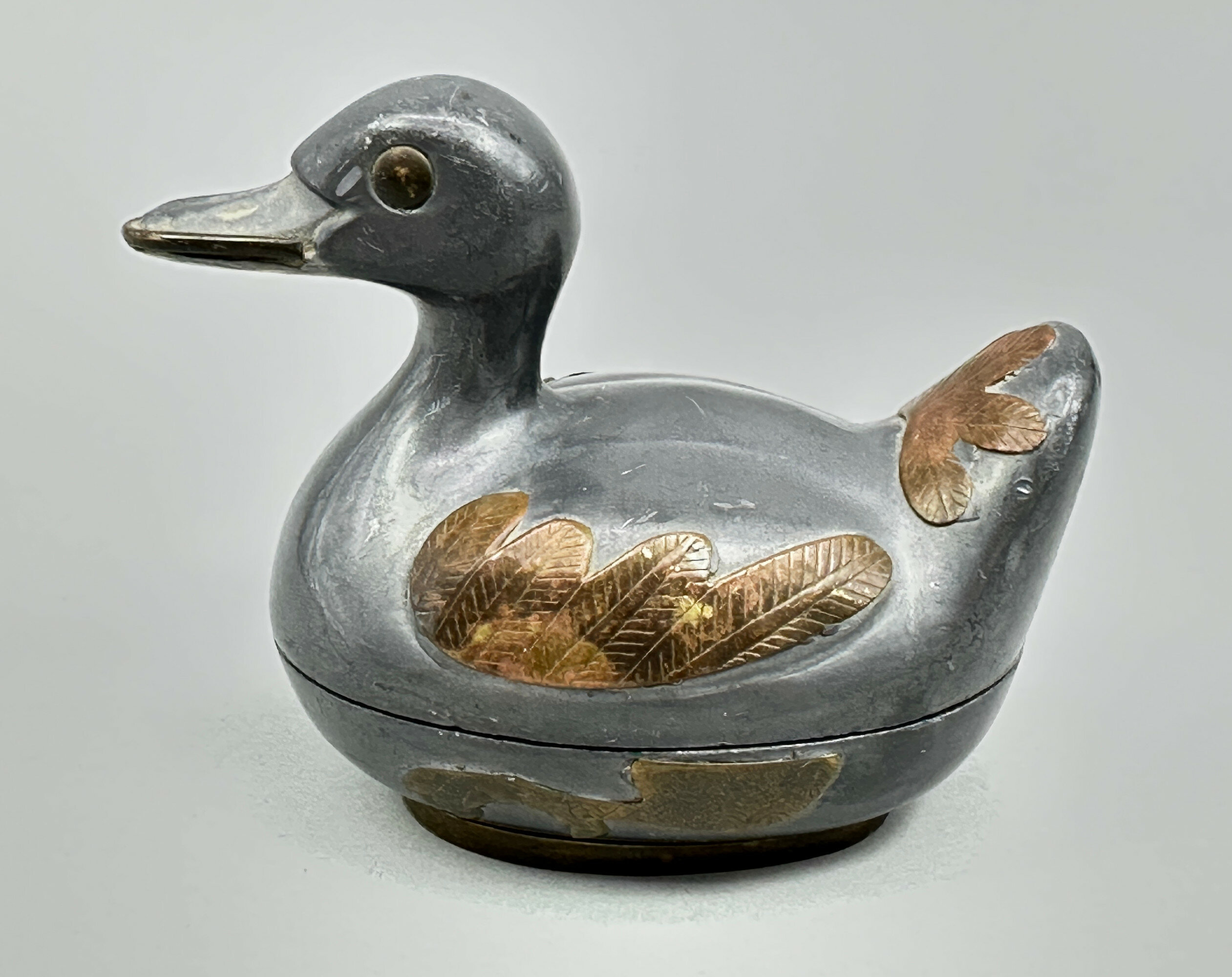
Pewter and brass box and cover in the form of a Mallard Duck, Gatco, Hong Kong, 1960s
Price: £25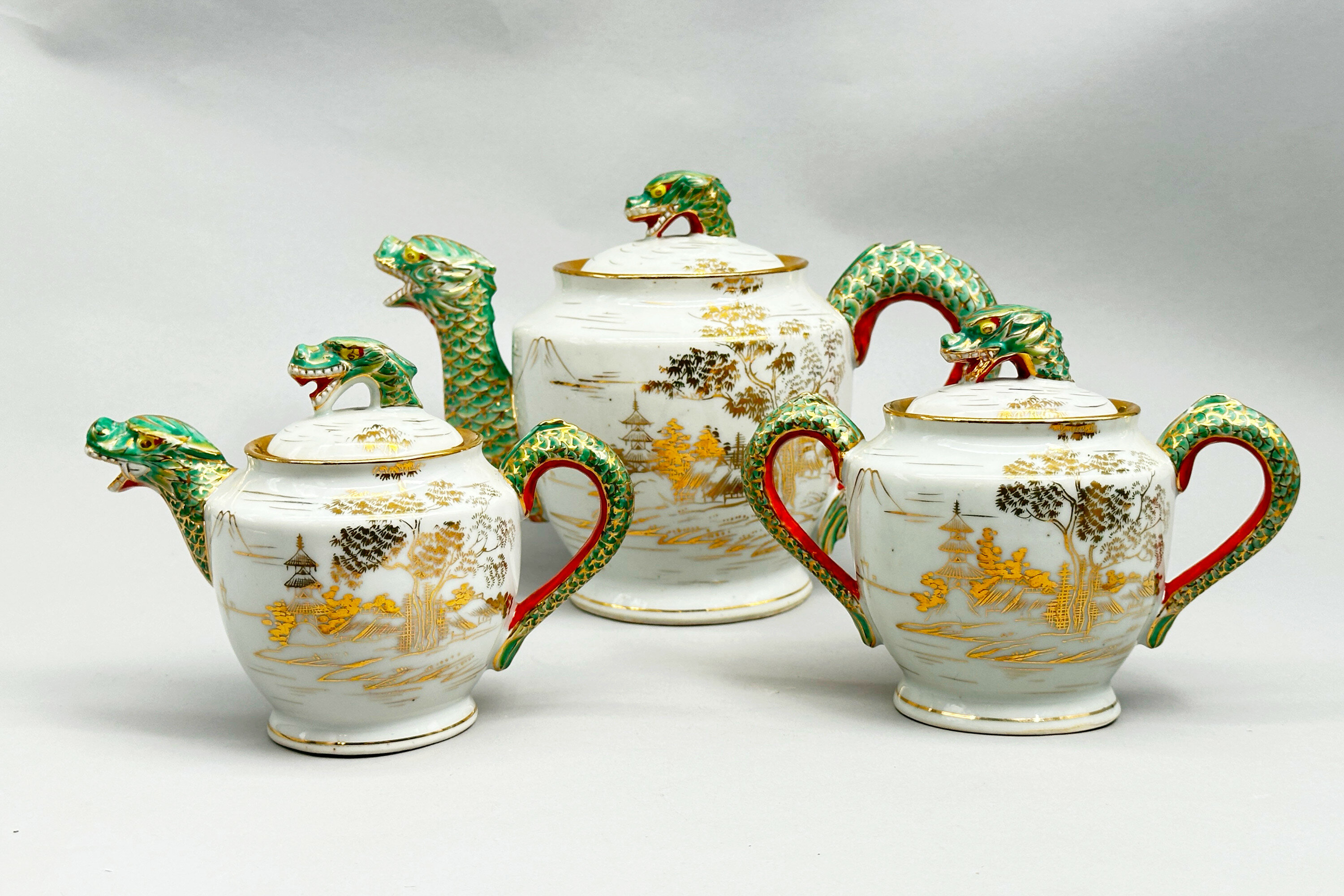
Japanese Kutani Part Tea Service circa 1920
Price: £75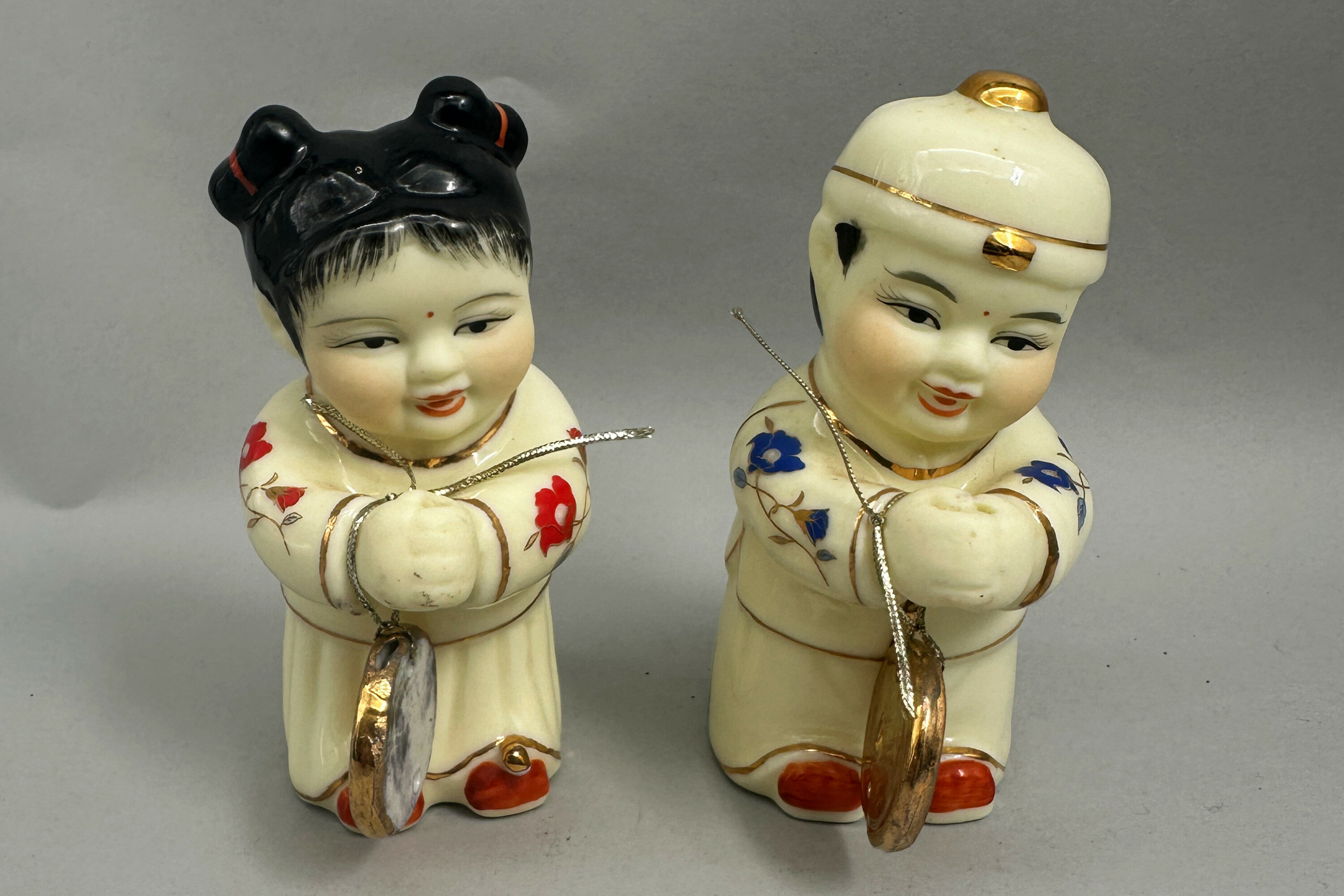
Decorative pair of Chinese ceramic figures of children, Yunu and Jintong , late C20th
Price: £45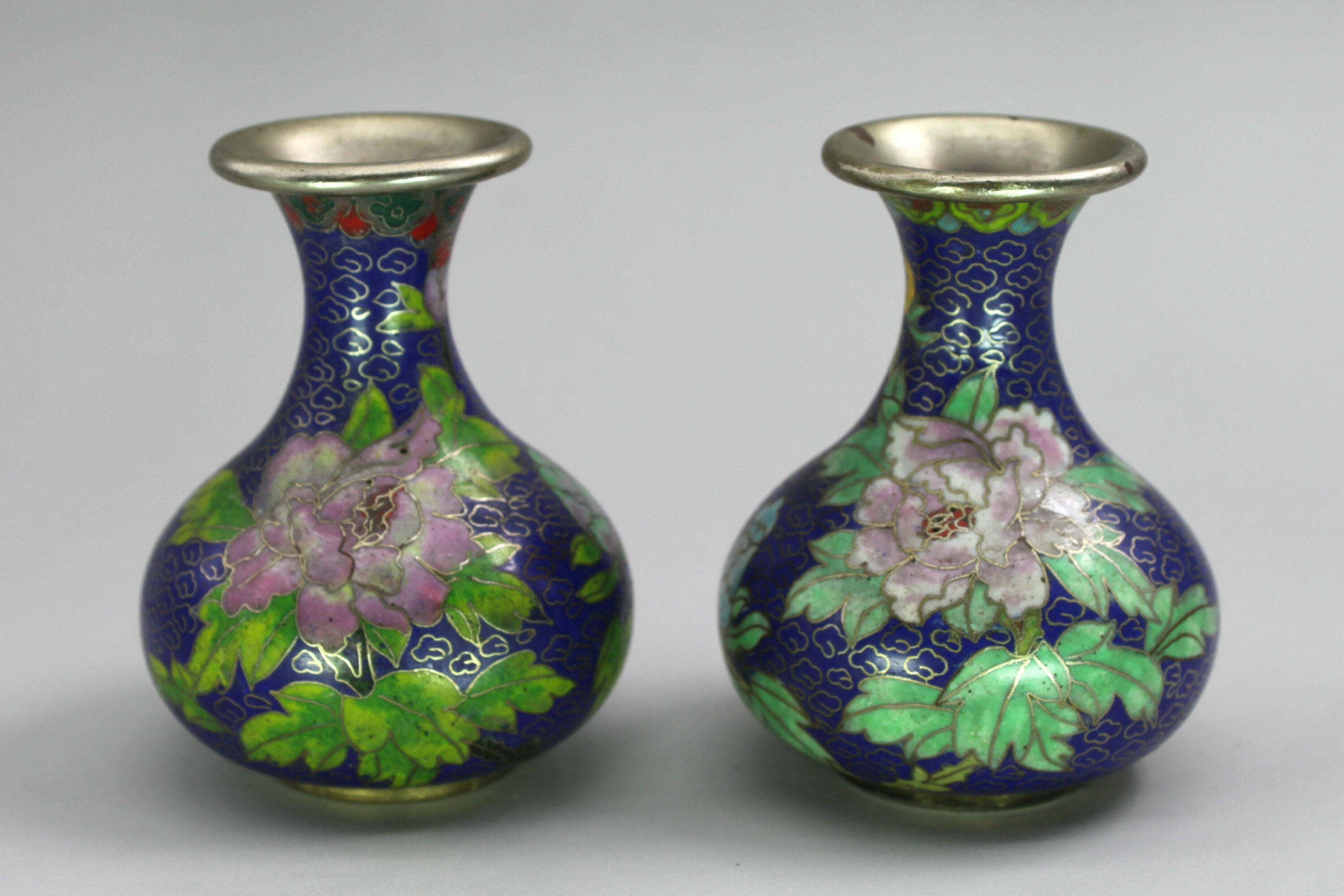
A Matched Pair of Chinese Cloisonne Bottle form Vases circa 1900
Price: £25